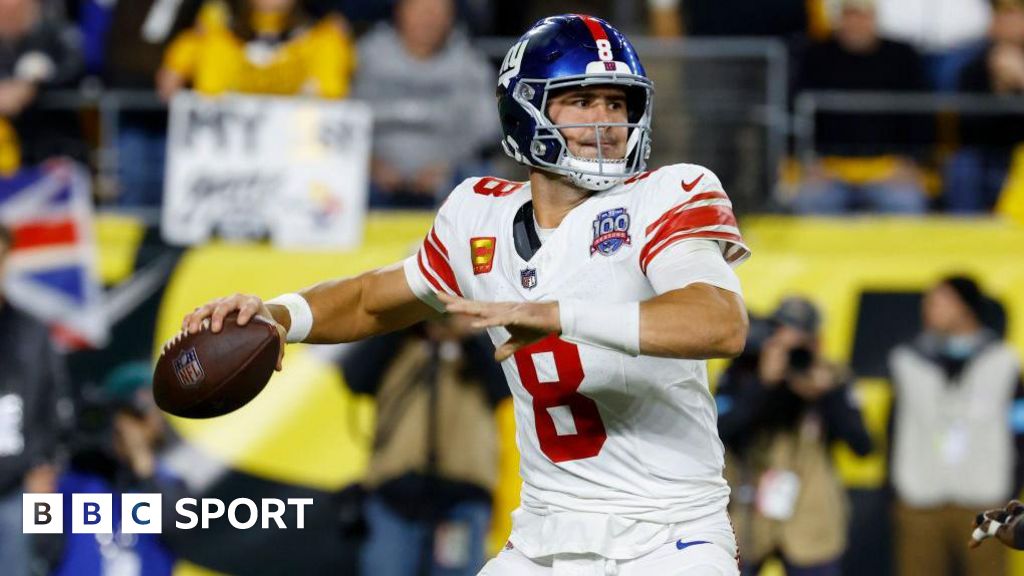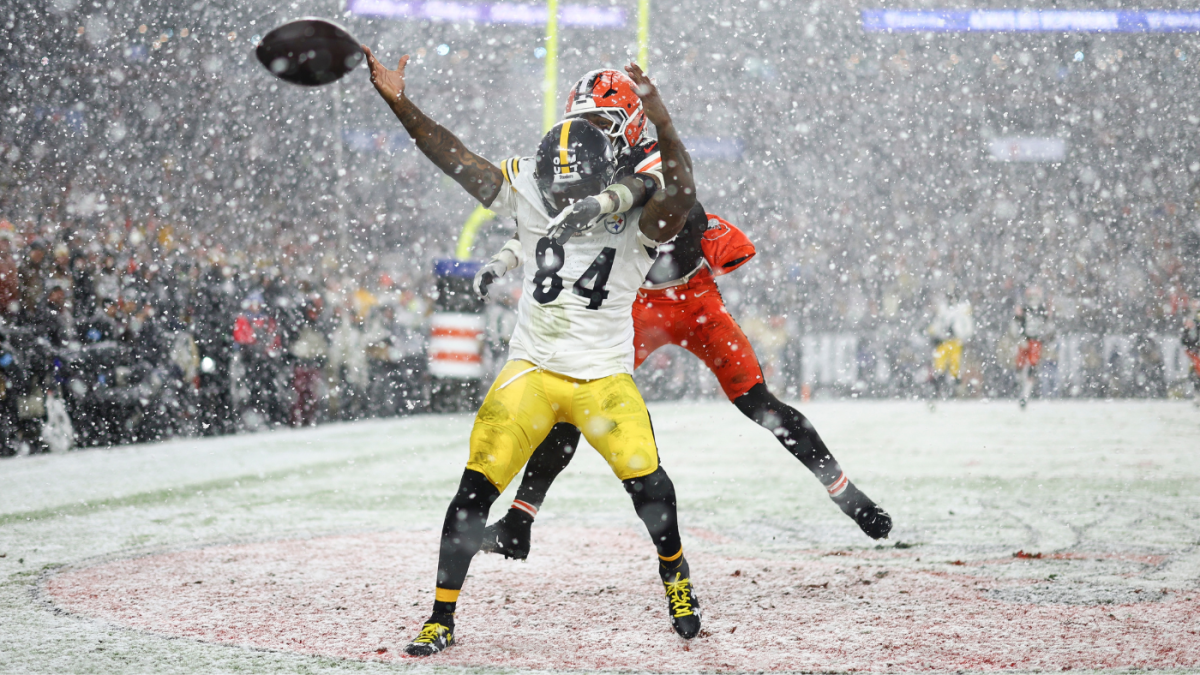NFL Week 2 Recap: Immediate fantasy football takeaways from Sunday’s games

• Alvin Kamara hits the hat trick: The New Orleans Saints achieved a dominant road victory that included Kamara scoring three touchdowns in the first half.
• Newcomer running backs with big days: Both the Green Bay Packers‘ Josh Jacobs and the Los Angeles Chargers‘ J.K. Dobbins built on their strong Week 1’s with effective 130-plus-yard rushing performances.
• Unlock your edge with a PFF+ subscription: Get full access to all of our in-season fantasy tools, including weekly rankings, WR/CB matchup charts, weekly projections, the Start-Sit Optimizer and more. Sign up now!
Estimated reading time: 40 minutes
PFF’s fantasy football recap focuses on player usage and stats, breaking down all the vital information you need to achieve fantasy success in 2024.
Las Vegas Raiders @ Baltimore Ravens
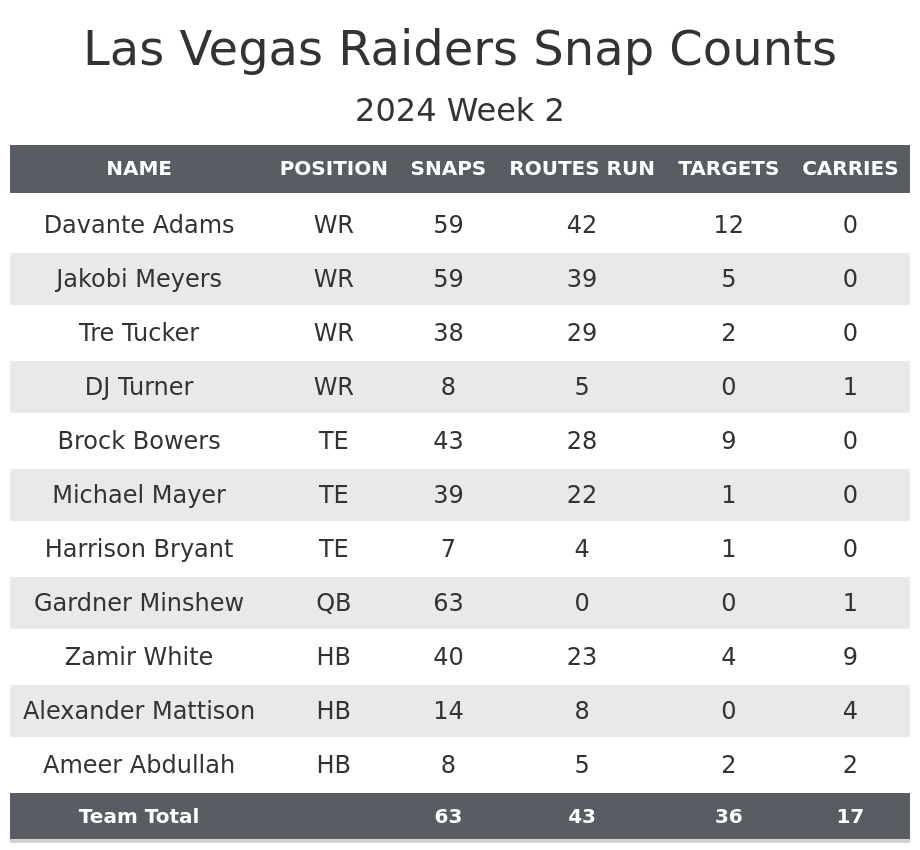

Zamir White plays more snaps but doesn’t produce: White played a much higher percentage of the offensive snaps, but that only led to 6.8 PPR points.
Last week, White was in a near-even split with Alexander Mattison on early-down and short-yardage snaps. Mattison played 19-of-20 snaps on third downs and two-minute drills.
This week, the distribution was very different. White took a clear majority of early-down snaps. The other piece of good news for White is he took some of the two-minute drill snaps, splitting with Ameer Abdullah. Last season, he barely played in the two-minute drill. Mattison continued as the third-down back.
The bad news for White is Mattison continued to split short-yardage work. That included a goal-line snap that led to a Mattison touchdown.
If the Raiders are in a game script where they are winning, White can be a fantasy starter in this split because he should see 15-plus carries in those games. The Raiders were down by 10 points with 10 minutes to go and had a comeback victory, so even though they won this game, it wasn’t a situation where they could commit to the run. In close games or games where the Raiders are losing, White should be left on benches in fantasy leagues.
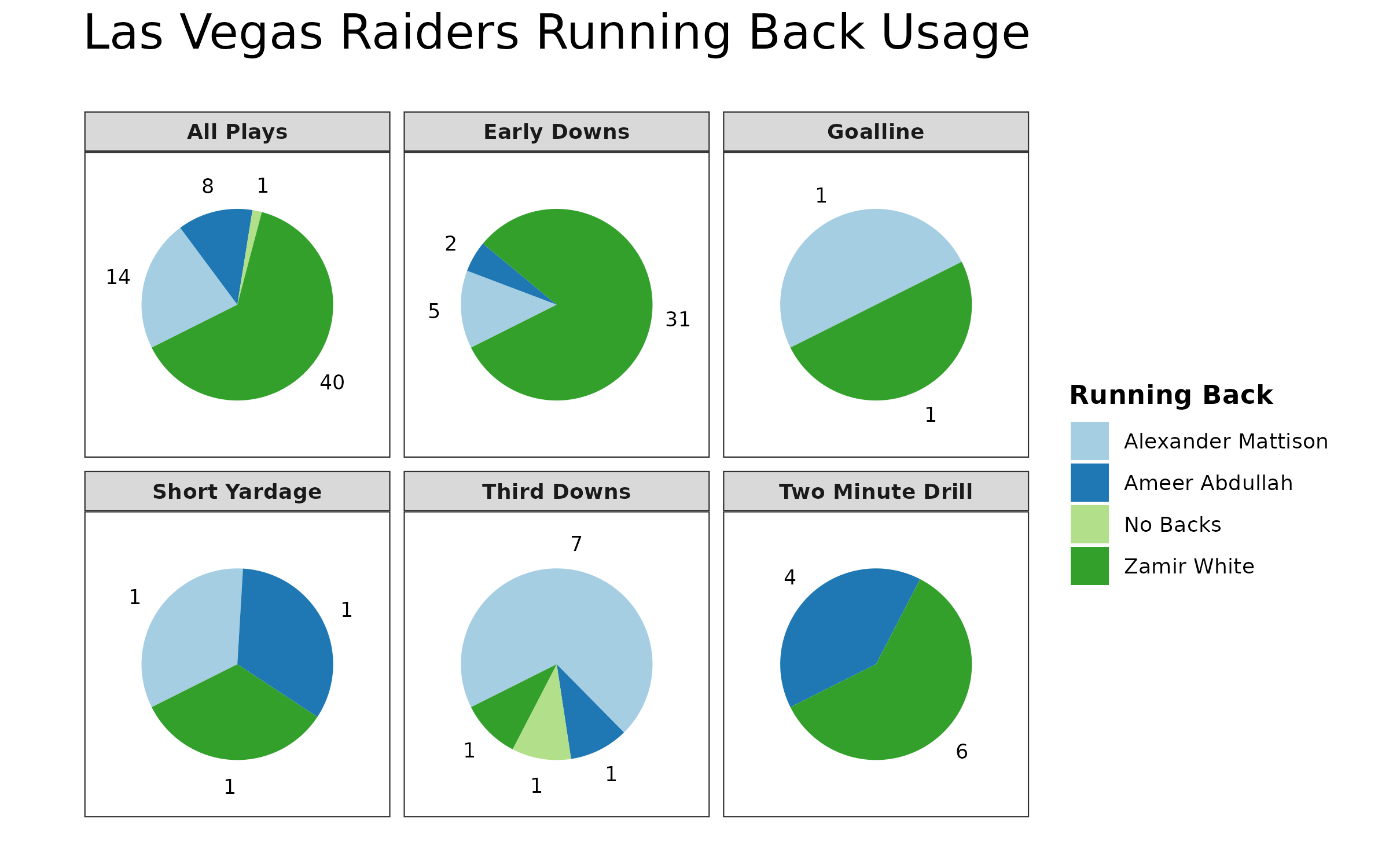
Brock Bowers hasn’t hit his ceiling yet: Bowers has been one of the best fantasy tight ends this season, and there is still room to improve.
Bowers caught nine passes for 98 yards and has been a clear top-five fantasy tight end so far this season. There is still room for him to improve his role with the offense.
The Raiders haven’t used as much 12 personnel as the preseason suggested, with 42 snaps out of 11 personnel compared to 15 out of 12 personnel. This means that on most plays, it’s either Bowers or Michael Mayer on the field. Bowers played 23 snaps out of 11 personnel compared to Mayer’s 18 and Harrison Bryant‘s one. The majority of those plays were pass plays regardless of which tight end was on the field.
Bowers continued to show up on the injury report this past week due to a foot injury, although he was a full participant each game. There is a chance that Bowers runs even more routes as the season goes on and he’s further removed from his foot injury. Even if he stays in his current role, his target share is high enough to sustain TE1 production.
Ravens decrease 12 personnel usage: The Ravens ran 40 plays in 12 personnel this week compared to 21 snaps in 11 personnel and 11 in 21 personnel last week.
Isaiah Likely was the waiver wire pickup after his dominant Week 1, but a lot changed from last week to this week. The Ravens’ distribution of formation changed significantly with 28 snaps in 11 personnel, 19 snaps in 12 personnel and 11 snaps in 21 personnel. This meant there were significantly fewer plays where both Mark Andrews and Likely were on the field at the same time.
Last week, Andrews played seven-of-eight snaps in 11 personnel in the first half, but Likely was the leader in the second half with eight-of-13. This week, we were back to Andrews being the primary tight end in 11 personnel throughout the game, playing 21-of-28 snaps while Likely played the other seven.
Likely continued to join Charlie Kolar in 22 personnel, while Kolar took most of the snaps in 21 personnel. Those are mostly rushing plays, but it meant a few pass plays with neither Likely nor Andrews.
This all added up to Likely running a route on less than half of the Ravens passing plays. Likely should stay on fantasy rosters, but it will be much harder to start him going forward.
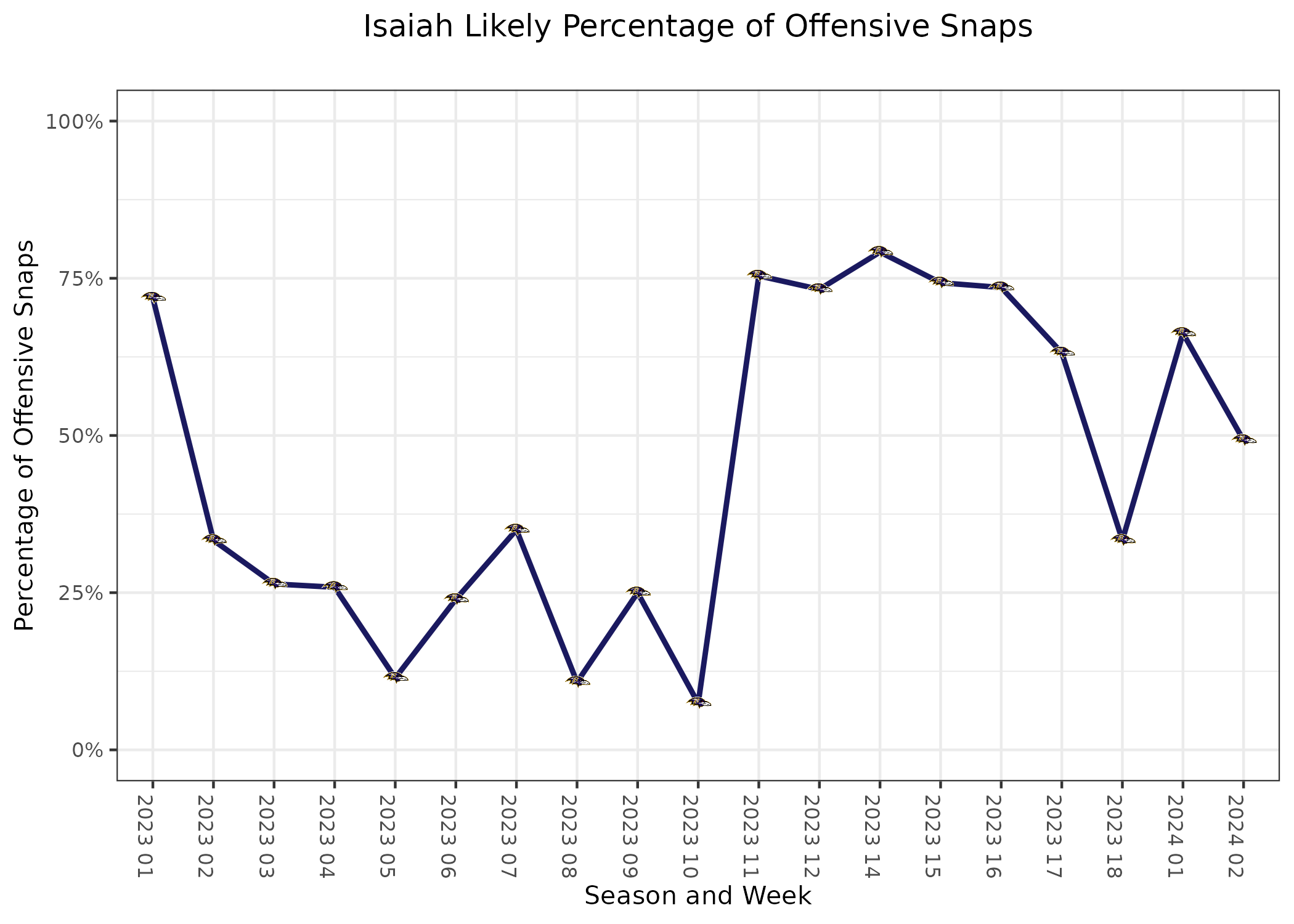
Miscellaneous Notes
- Rookie running back Dylan Laube was a healthy inactive for the Raiders for a second straight week. It was a similar story for Ravens rookie wide receiver Devontez Walker.
Los Angeles Chargers @ Carolina Panthers
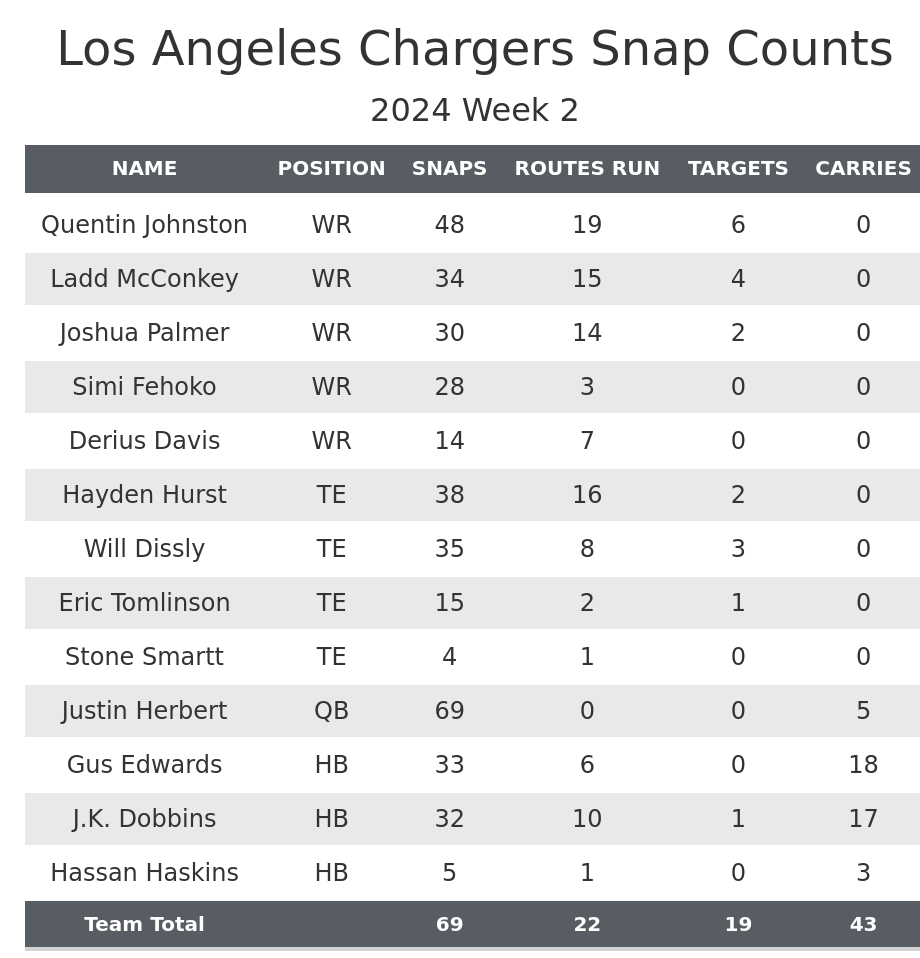
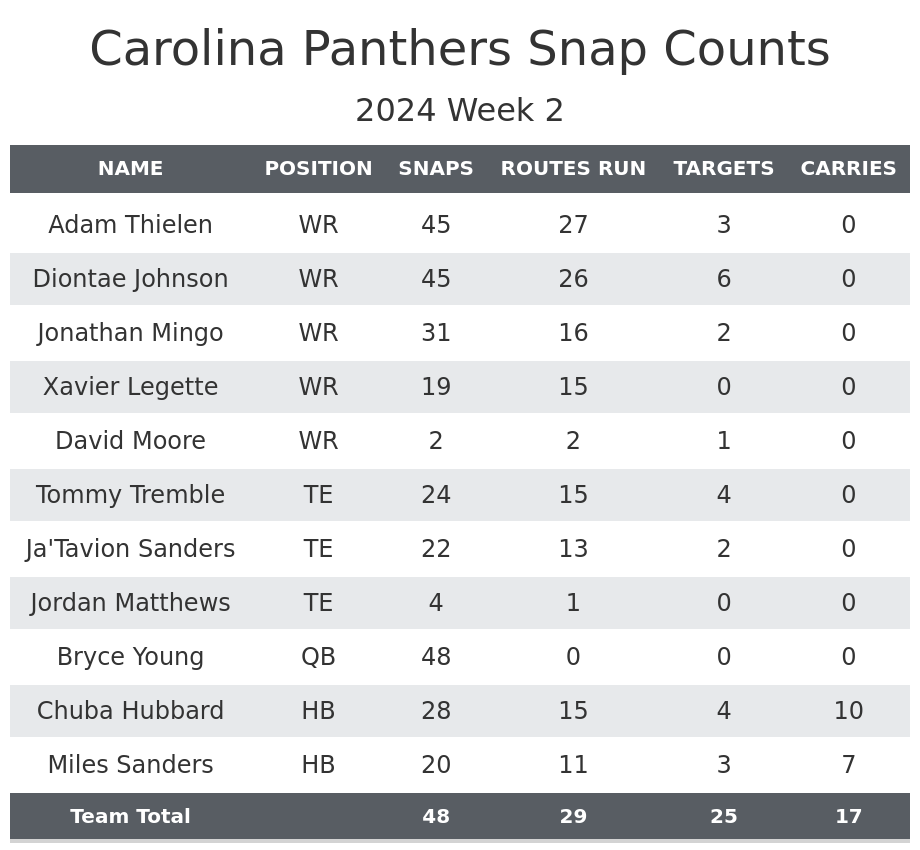
J.K. Dobbins starts for the Chargers: He replaces Gus Edwards as the Chargers’ primary running back.
Dobbins put together an excellent Week 1 performance with 10 carries for 135 yards and a touchdown while Edwards ran 11 times for 26 yards. He was rewarded with the Week 2 start, although the backfield split was similar to Week 1. Dobbins and Edwards split early downs while Dobbins was the primary passing down back.
The biggest difference was that Dobbins played the goal-line snaps, although his one touchdown came on a 43-yard run. As long as the Chargers are in-game scripts that enable them to run a lot, Edwards and Dobbins should be expected to be heavily involved in the run game. It will be interesting to see the split when the Chargers play from behind. Theoretically, Dobbins would be playing more snaps in those games.
Dobbins is a must-start player going forward. The big question is if he can earn more playing time to maintain being a top-five running back. It’s also reasonable to consider cutting Edwards. These are the game scripts where he should have the most fantasy value, but he hasn’t achieved fantasy-starting production.
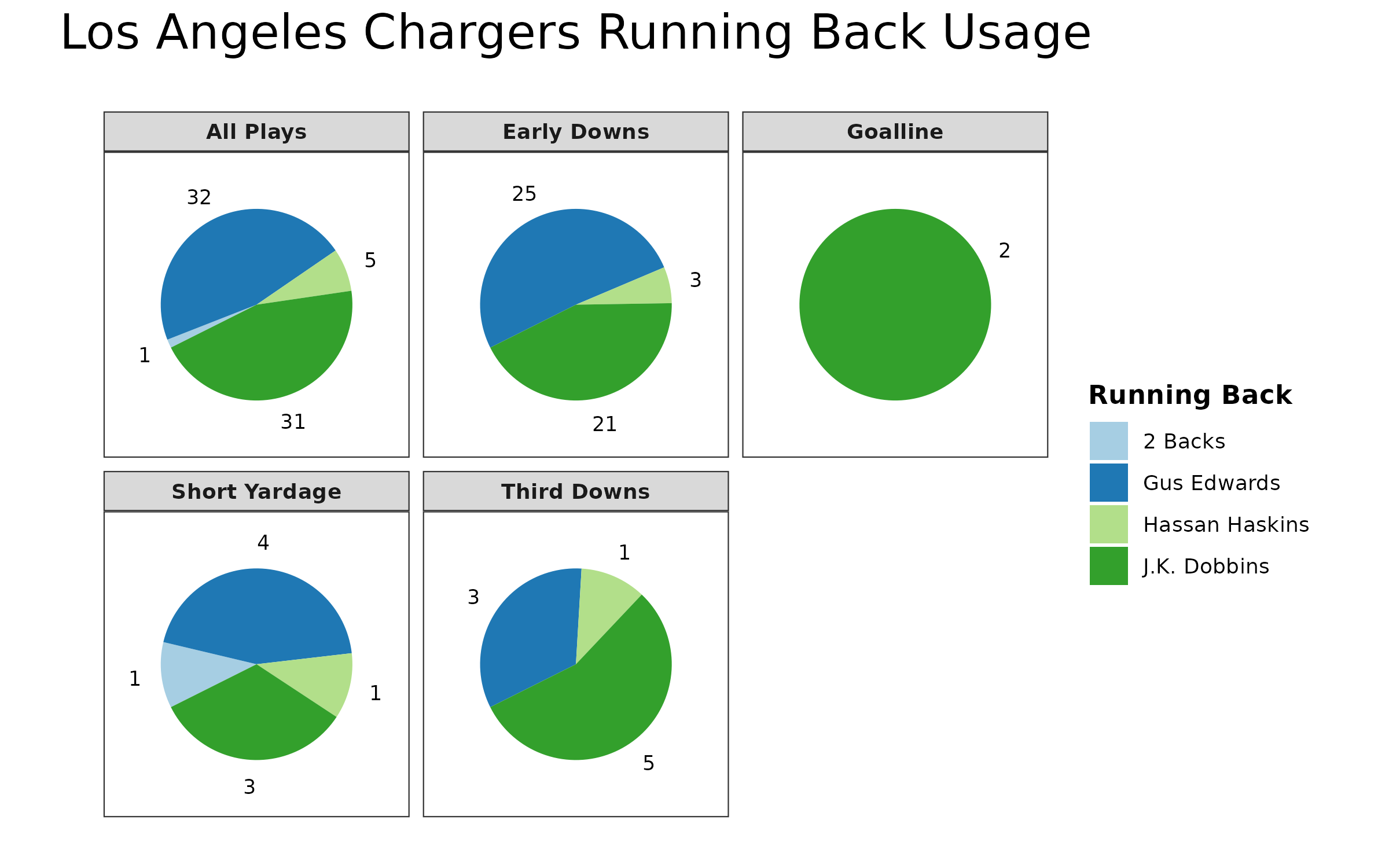
Quentin Johnston shines as the healthy wide receiver: Johnston was the Chargers’ main healthy outside wide receiver and doubled his career touchdown total.
D.J. Chark Jr. is on injured reserve while Josh Palmer was questionable for this game due to a knee injury. Palmer rotated out much more than usual, including barely playing in the fourth quarter. He also spent some time in the medical tent.
Johnston’s role wasn’t much different from last week or most of last season. The big difference this time around is that he caught his targets and they happened to go for touchdowns.
Johnston is worth a waiver add in deeper leagues. There is a chance this is the start of his career turning around. It’s more likely he won’t be as big of a focal point in the offense as the season goes on once Palmer and Chark are healthier and Ladd McConkey becomes a bigger part of the offense.
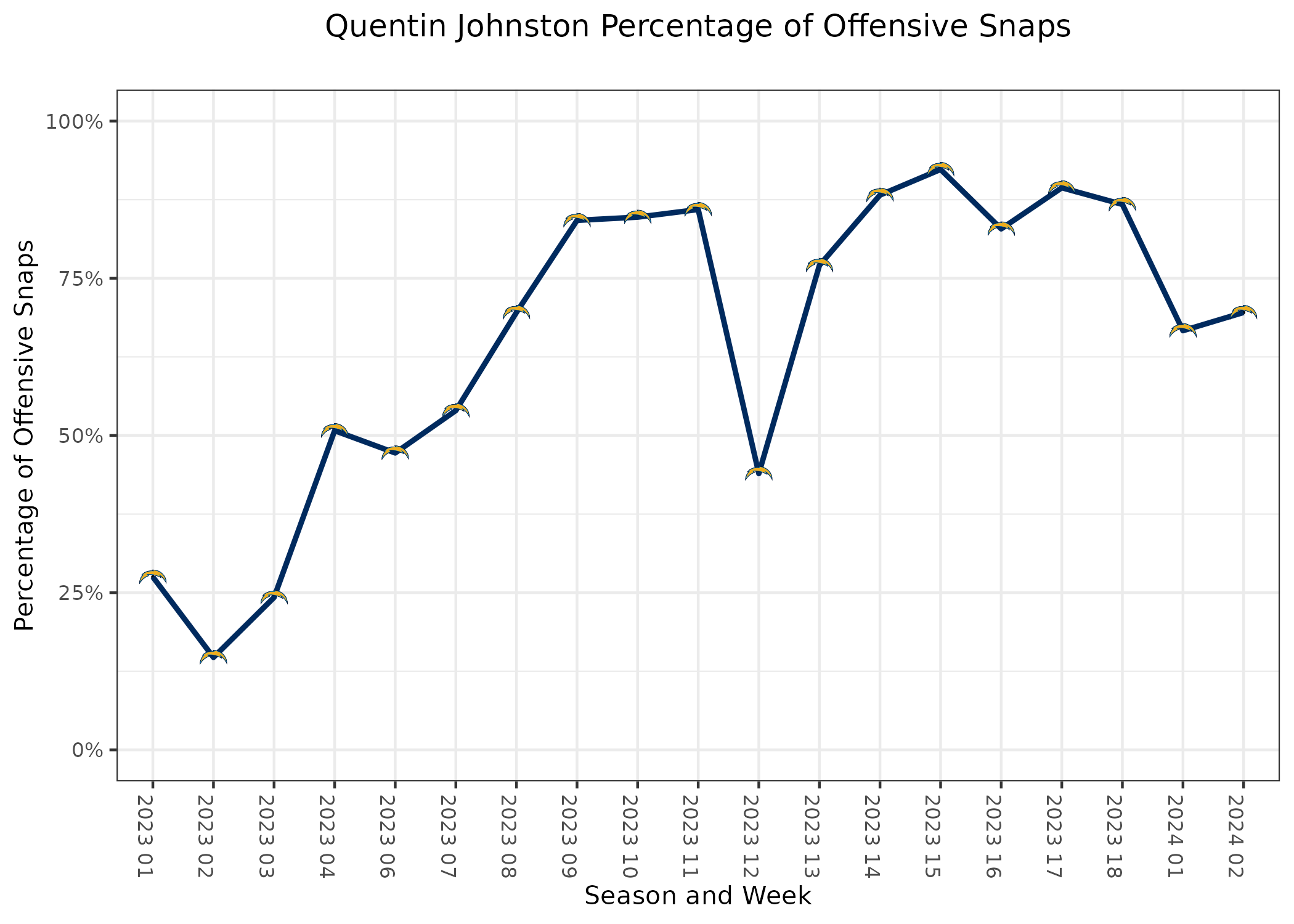
Chuba Hubbard pulls slightly ahead of running back rotation: The Panthers rotated their running backs by drive, which favored Hubbard.
The Panthers rotated by drive last week. Hubbard took two drives to Sanders’ one, but the drives Miles Sanders played were much longer. In this game, Hubbard was the primary running back for most of the game, playing 20-of-28 snaps over the first eight drives. However, Sanders played significantly in the last 16 minutes of the game, which brought the playing time much closer to even.
Hubarrd was the better player, averaging 6.4 yards per carry compared to Sanders’ 2.9. Hubbard also caught four passes for 14 yards. If the Panthers’ offense starts putting drives together, Hubbard would have a bit more fantasy value.
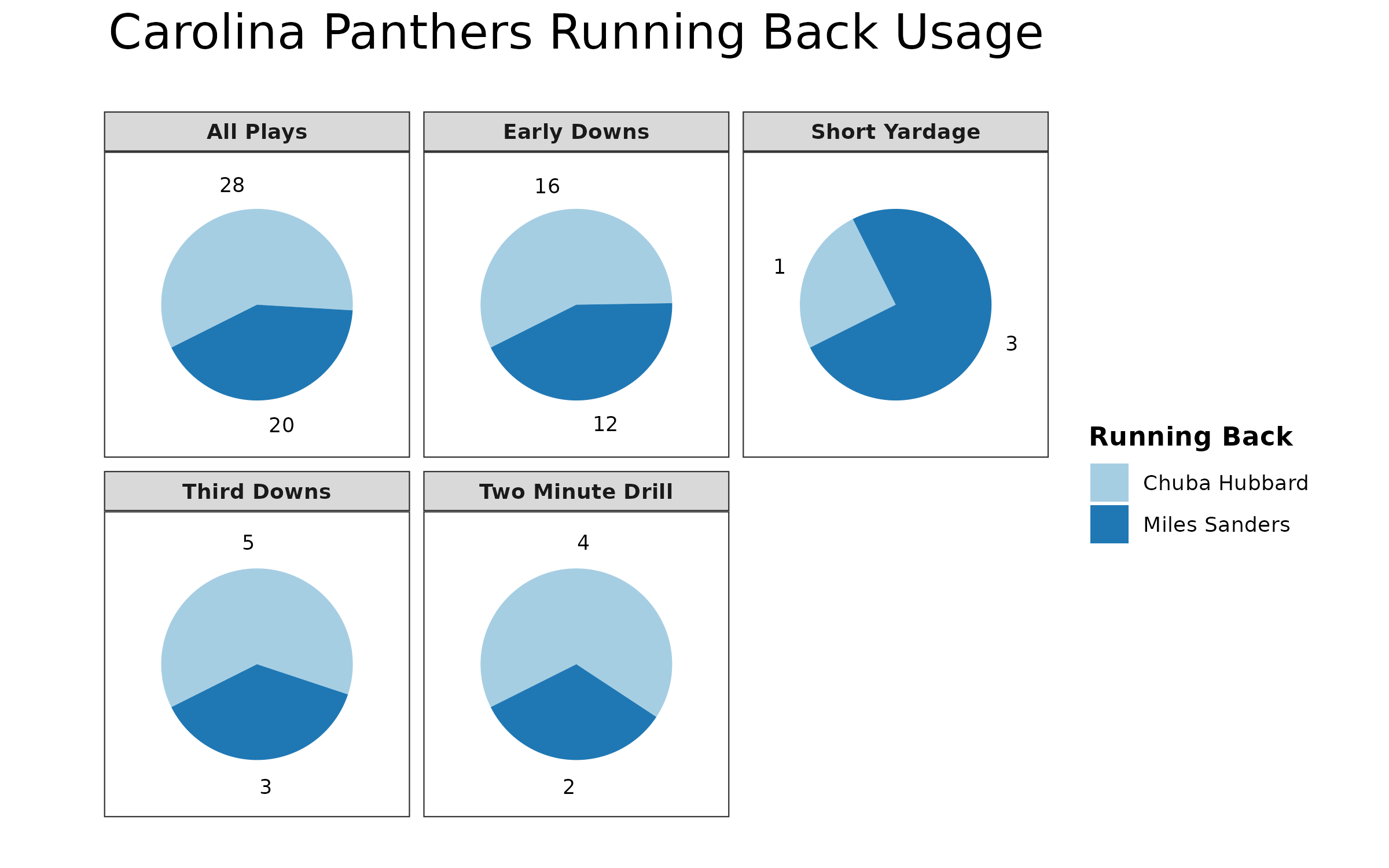
Miscellaneous Notes
- While Jonathan Mingo played ahead of Xavier Legette last week, Legette ended up playing more snaps. This week, Mingo started the game and was clearly ahead in offensive snaps.
- Panthers veteran Tommy Tremble made his 2024 debut after missing all of the preseason along with Week 1. He immediately entered a two-man rotation at tight end with Ja’Tavion Sanders. The fourth-round rookie seemed like a possible sleeper early in the season, but this rotation will make it very difficult for him to become a fantasy starter.
- Rookie running back Kimani Vidal was a healthy inactive for the Chargers for a second straight week.
- Tight end Hayden Hurst continues to be the clear receiving tight end for the Chargers. His snap count will be higher when the games are closer for Los Angeles, but he still isn’t receiving many targets. Eric Tomlinson played so much because they ran a lot of 22 personnel with defensive lineman Scott Matlock at fullback.
New Orleans Saints @ Dallas Cowboys
- Alvin Kamara: 20 carries, 115 yards, 3 touchdowns, 2 receptions, 65 receiving yards, 1 receiving touchdown
- Rashid Shaheed: 4 receptions, 96 yards, 1 touchdown

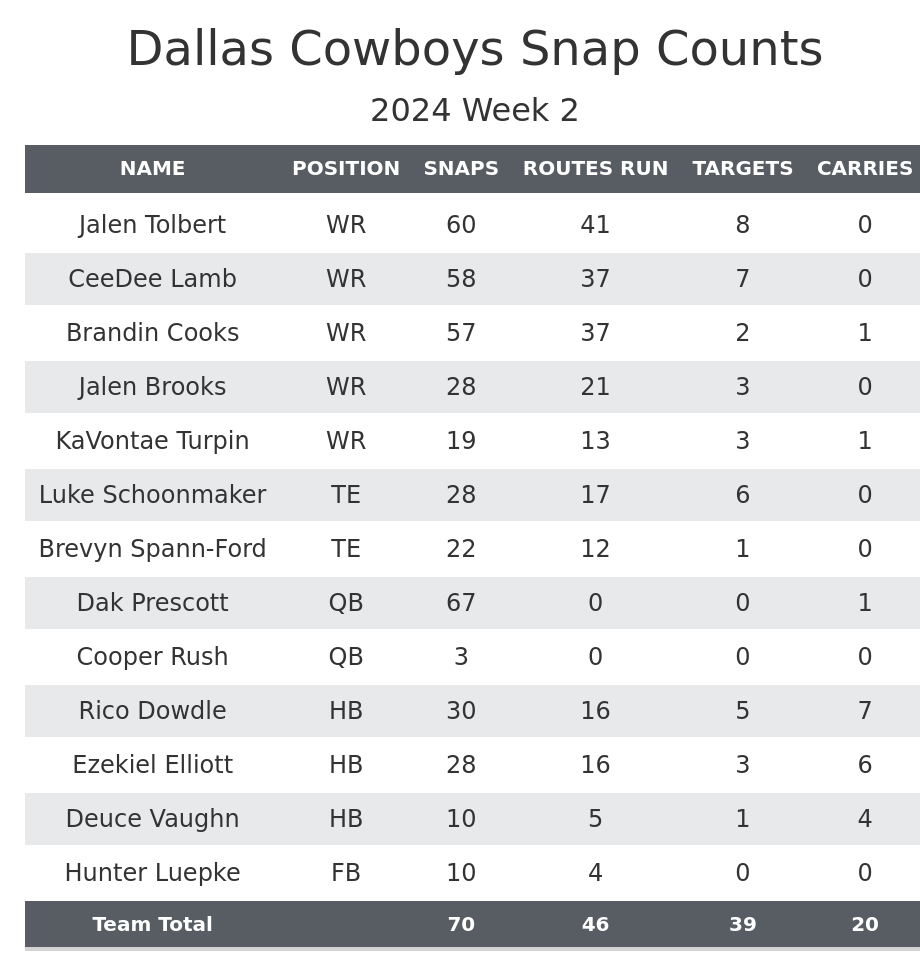
Monitor Taysom Hill‘s health: He went to the hospital with a chest injury.
Coach Dennis Allen suggested it was more precautionary than anything. He left at the end of the third quarter after playing in 28 of a possible 41 snaps during that time.
His playing time has been higher than in previous years when the game is close, but he’s not running the ball enough to trust him in fantasy leagues. He ran three times in the first three quarters, which was second-most on the team but not close to Alvin Kamara’s 15 during that time. As long as Kamara is playing this well, it will be harder to trust Hill in fantasy leagues.
Ideally, Hill is healthy, and if he is, it will be good to see him in a closer game to see if his usage increases. To this point, the Saints simply haven’t needed him.
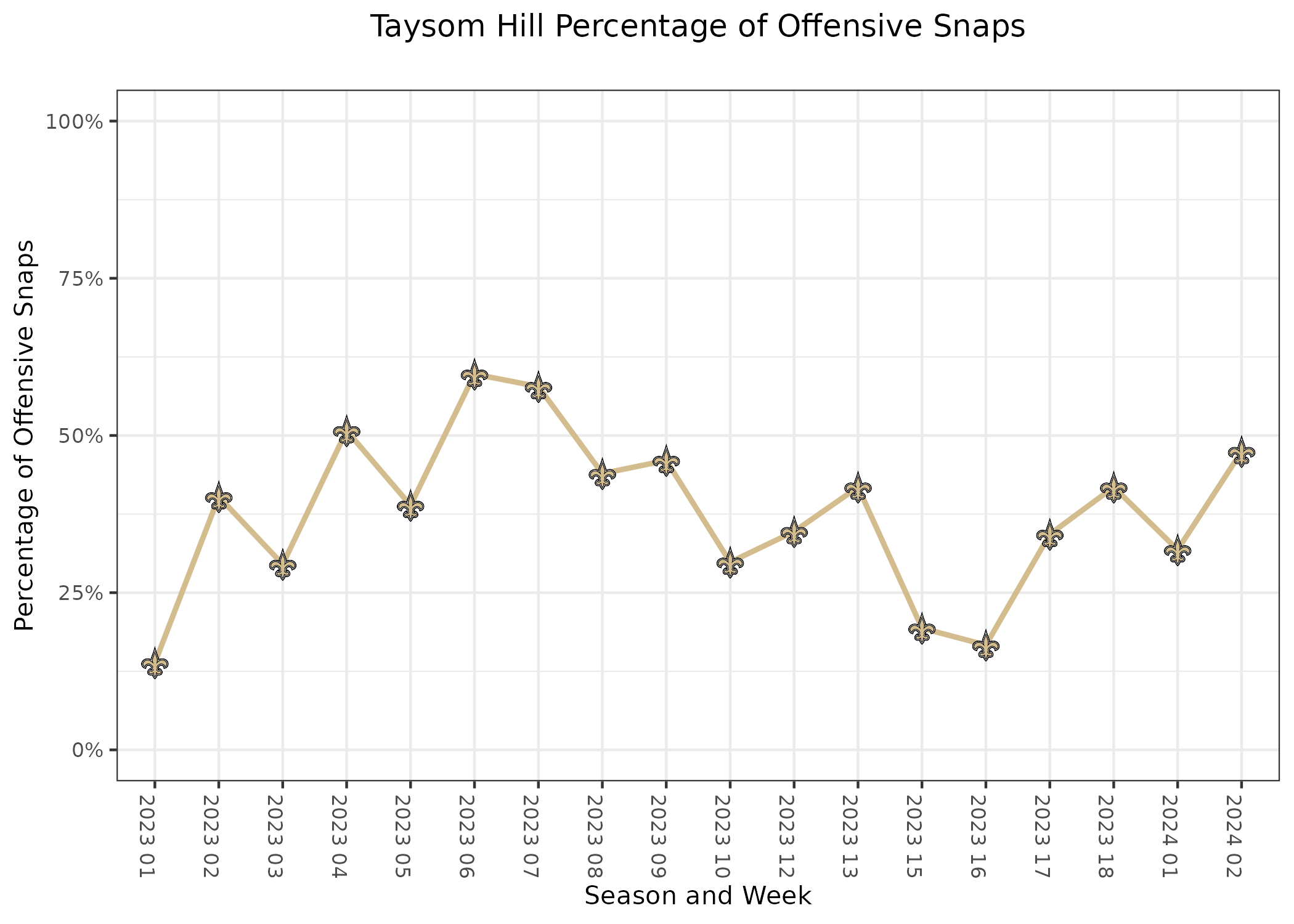
Avoid the Saints’ other tight ends: Neither Foster Moreau nor Juwan Johnson received a target after both scored touchdowns last week.
Neither Saints’ tight end is being used in a way to produce consistent fantasy value. Moreau has dominated offensive snaps this season because he’s their run-blocking tight end, and the Saints have run the ball a lot. He was playing in everything except 11 personnel. Johnson played every snap out of 11 personnel but only ran a route on four of the 20 pass plays in the game.
Johnson should run a lot more routes in closer games or when the Saints are playing from behind, but it’s unlikely he will see a high target share in those situations. They can be dropped in any league where they are rostered.

Deuce Vaughn complicates running back rotation: Vaughn played 10 offensive snaps and ran the ball four times, making it just the third game of his career with significant work.
The Cowboys utilized a two-man rotation last week with a rotation by drive. Ezekiel Elliott took the first drive while Rico Dowdle had the second. This week, Dowdle was up first. Vaughn typically only played if a drive lasted five or more plays. Ideally, the Cowboys would trust Dowdle or Elliott to play significant snaps on one drive followed by a few snaps on the next.
This meant no Cowboys running back had more than 30 rushing yards or reached double-digit attempts. Dowdle is still worth a waiver-wire target, as he was the most effective back in this game and caught four passes for 29 yards. The fact that he started this week over Elliott is a step in the right direction. The Cowboys will need to abandon the strict rotation by drive for Dowdle to be worth starting.
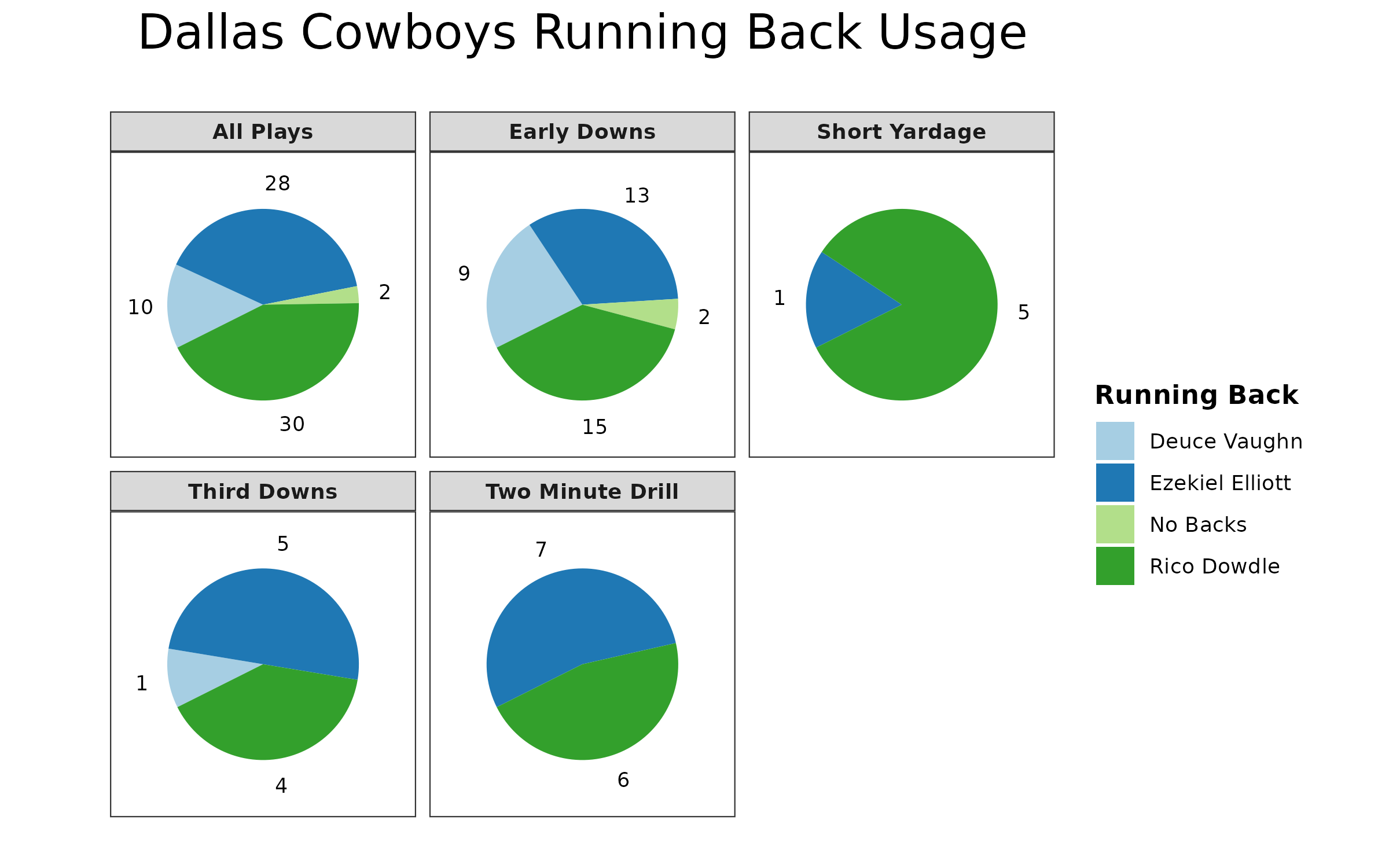
Miscellaneous Notes
- Cowboys starting tight end Jake Ferguson missed this game due to a knee injury.
- Cowboys tight end John Stephens missed his second straight game due to a hamstring injury.
- This left Luke Schoonmaker and Brevyn Spann-Ford splitting time at tight end, with no clear tendency of how one tight end was used over the other. Schoonmaker was trusted much more in the passing game with six receptions for 43 yards while Spann-Ford didn’t catch his only target.
- Saints wide receiver A.T. Perry was inactive despite being a full participant in practice all week. He was a starter at the end of last season but seemed lower on the depth chart based on the preseason. He was inactive last week due to his hand injury.
- Both Chris Olave and Rashid Shaheed played over 80% of the Saints’ offensive snaps in the first half but didn’t play as much in the second half because they weren’t needed.
- Cedrick Wilson no longer has a clear hold on the third wide receiver spot. Mason Tipton, who is an undrafted rookie out of Yale, rotated in for three-receiver sets. Wilson played most of the snaps in the first and third quarters while Tipton played the second quarter, and both played a lot in the fourth.
Tampa Bay Buccaneers @ Detroit Lions
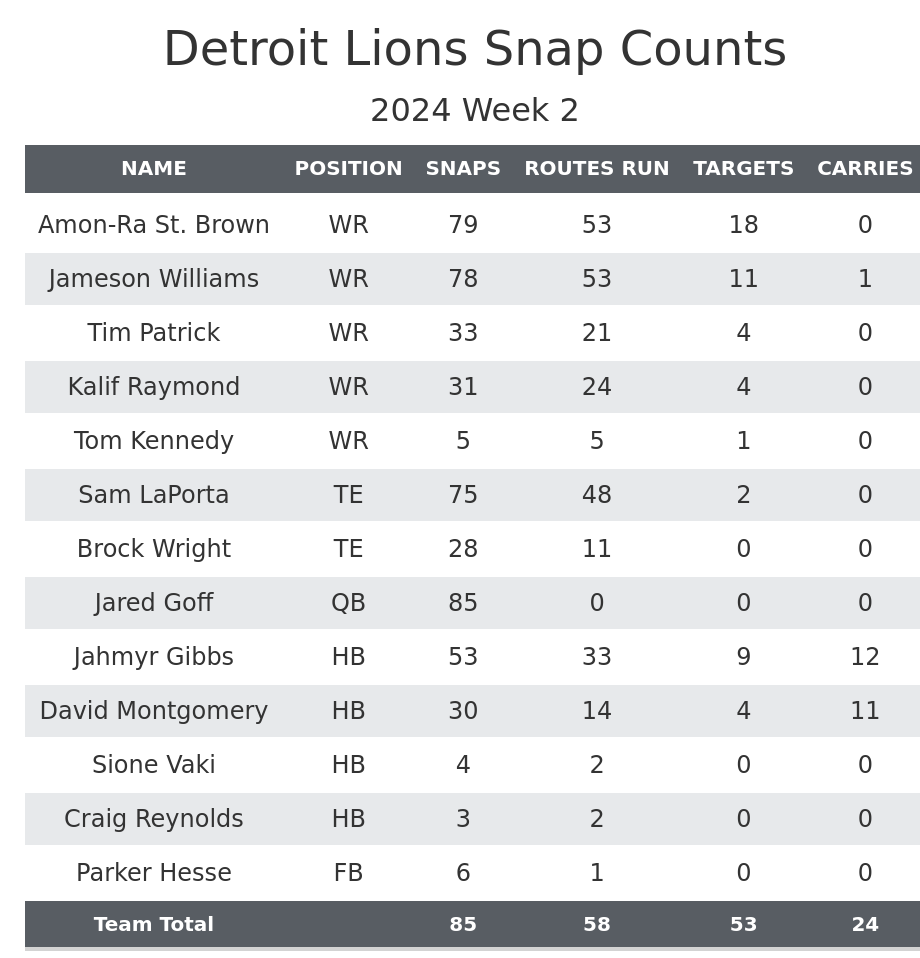

Bucky Irving continues to play significant snaps: Irving and White’s split was remarkably similar to last week.
In both games, Irving played 13 snaps on early downs while the team used two halfbacks on three plays. White took three goal-line snaps, and White played almost all of the third-down snaps. The main difference is White took fewer snaps on early downs, dropping from 26 to 20.
White suffered a groin injury early in the game, but that only caused him to miss a few plays, and those could have been plays White would have been in anyway. He left on one drive and was back during the next one.
Irving was the more effective rusher, running seven times for 22 yards compared to White’s 10 carries for 18 yards. The biggest difference from last week to this week is White wasn’t involved in the passing game, catching one pass for five yards. This left White with 3.3 PPR points. Irving isn’t at a point where he’s a fantasy starter, but he’s running the ball enough to prevent White from being a consistent fantasy starter. Irving remains a waiver-wire target because it wouldn’t be surprising if he starts leading the team in carries.
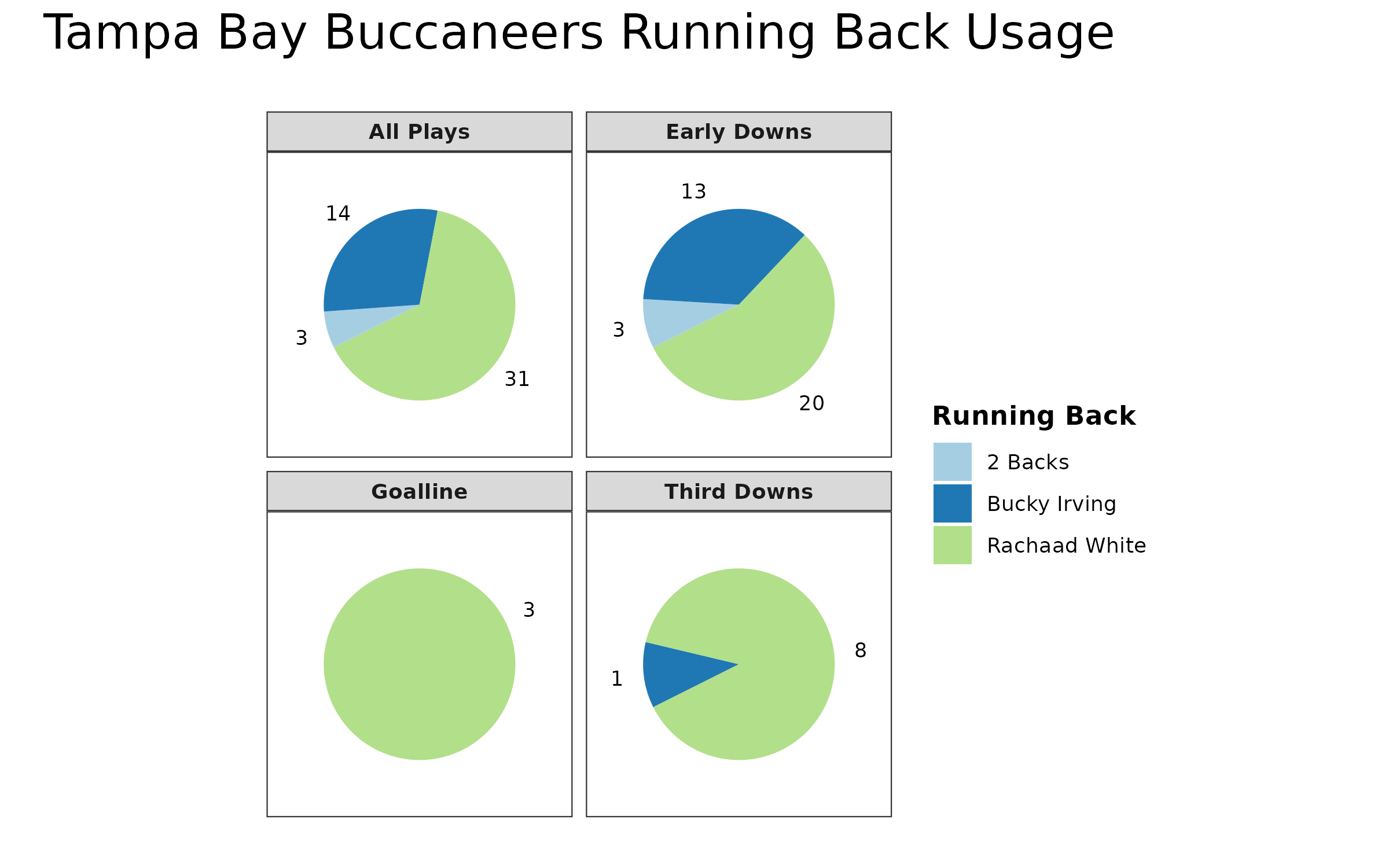
Tim Patrick debuts for the Lions: Patrick was elevated off the practice squad for this game and ran the third-most routes among the wide receivers.
Patrick was released by the Denver Broncos on cut-down day and landed on the Lions’ practice squad. Rookie Isaiah Williams popped up on the injury report on Thursday due to an abdomen injury and was ruled out on Friday. It was unclear if Patrick was elevated just to fill Williams’ roster spot, or if Detroit was ready for Patrick to have a large role.
It seemed to be the latter, as Patrick rotated with Kalif Raymond as the third wide receiver in three-receiver sets. It’s also worth noting that Jameson Williams was questionable due to an ankle injury, and if anything, he was more involved than usual. Williams moved up my rest-of-season rankings last week and will be doing so again this week.
It’s unlikely Patrick will emerge as a fantasy-relevant player in Detroit when the team has so many other skill players who are fantasy-relevant, but there could be weeks where Patrick has a great game while defenses are so focused on everyone else.
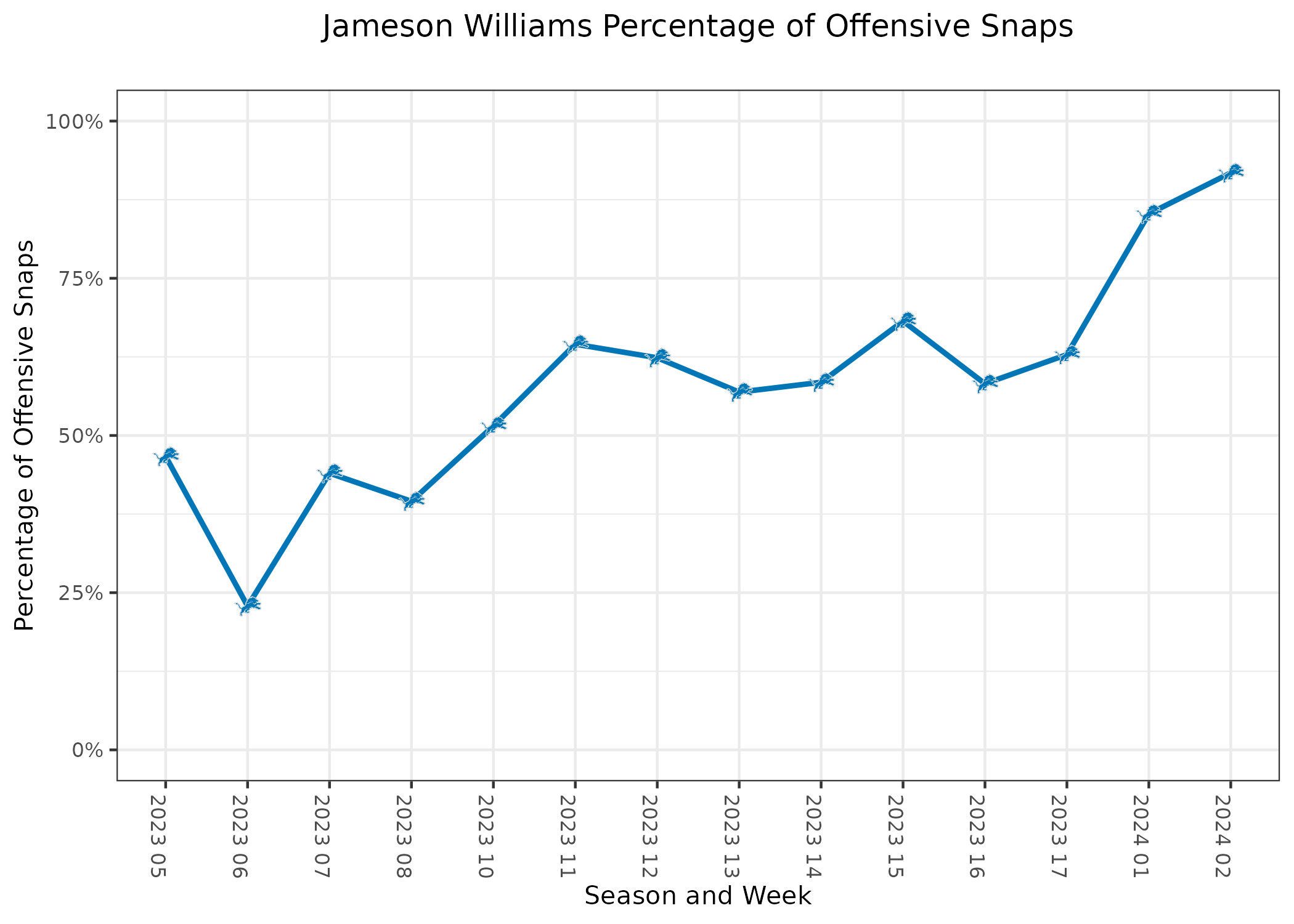
Miscellaneous Notes
- Jahmyr Gibbs and David Montgomery‘s snap split was relatively normal for this game, with this being on the higher end for Gibbs when the two are healthy.
- Amon-Ra St. Brown was dealing with a leg injury late in the game but was able to run off the field. This doesn’t seem overly concerning but is worth monitoring.
Indianapolis Colts @ Green Bay Packers
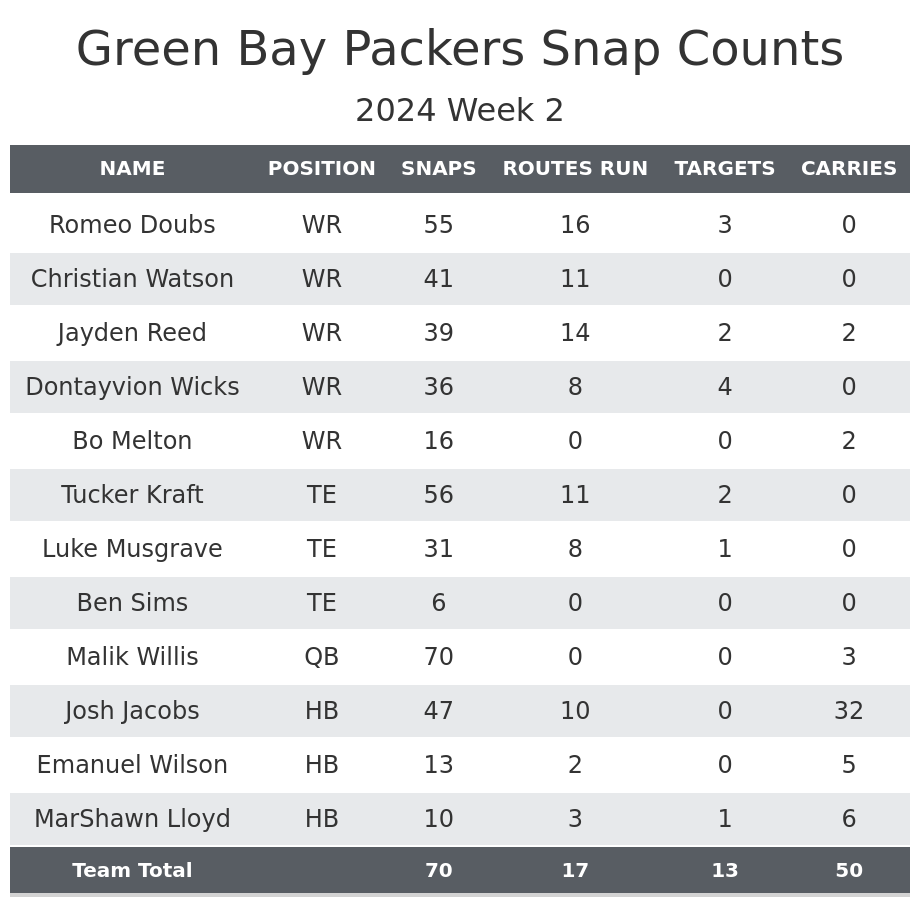
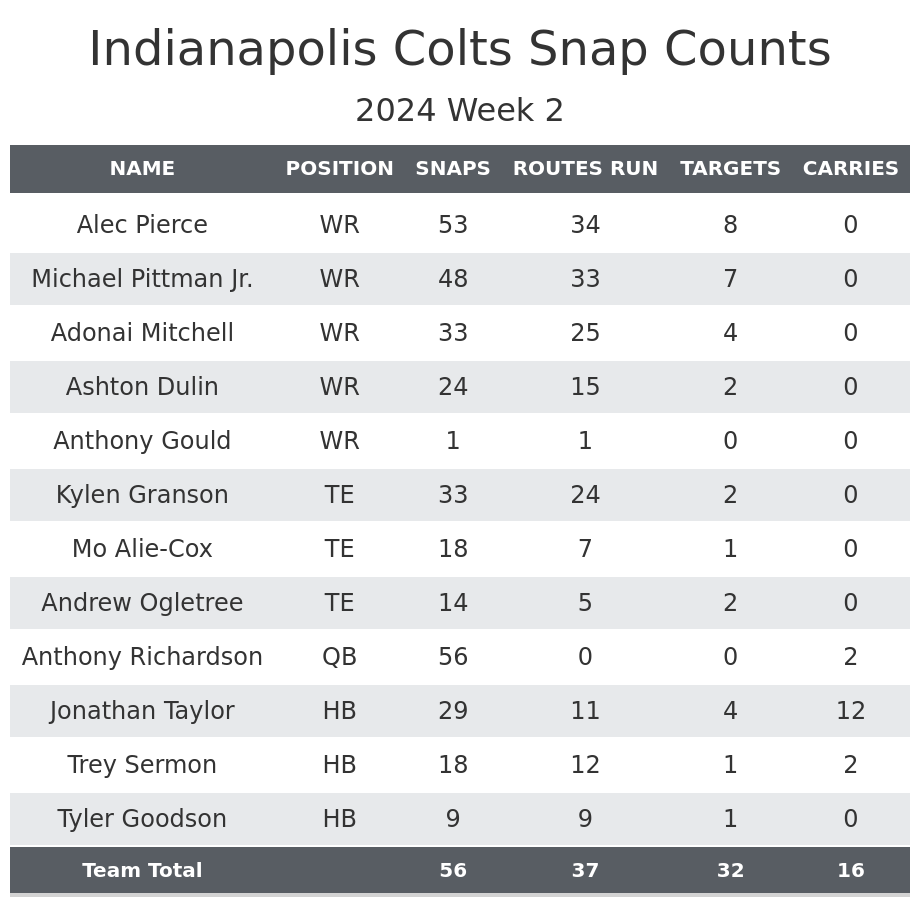
Jonathan Taylor was limited in passing situations: Taylor was a feature back in Week 1 but not in this game.
Taylor played in 43 of a possible 45 snaps in Week 1, including all seven snaps during two-minute drills and all but one on third downs. This week, the story was different. Trey Sermon and Tyler Goodson split 18 snaps in the two-minute drill and played the majority of the third-down snaps. It is worth noting those two-minute drill snaps occurred in the last few minutes of the game when the Colts were down, so things may have been different if the two-minute drill snaps happened in the first half, or if the Colts weren’t down by two scores for most of it.
This is good news for Taylor’s ability to stay healthy this season but bad news for Taylor’s fantasy ceiling and ability to catch passes. After running 12 times for 103 yards and catching two passes for 32 yards, it could be a time to sell high.

Alec Pierce scores again: Pierce has posted two of the best games of his career in the last two weeks.
Pierce’s role as an every-down starter hasn’t changed, but he’s caught eight of his 10 targets over the last two weeks for 181 yards and two touchdowns. He’s becoming an even more intriguing waiver-wire target after two strong performances, but things may change soon.
Josh Downs was inactive for a second straight game, but he could be back for next week. He would take over in the slot, which means second-round rookie Adonai Mitchell would be out of the starting lineup. Considering Mitchell spent this game rotating with Ashton Dulin, it seems unlikely that Mitchell will take significant snaps from Pierce, but it’s possible. It’s also possible that Downs takes targets away from Pierce. It’s fine to consider Pierce in deeper leagues if he’s still available, but I’m also still not sold on him being a long-term option.
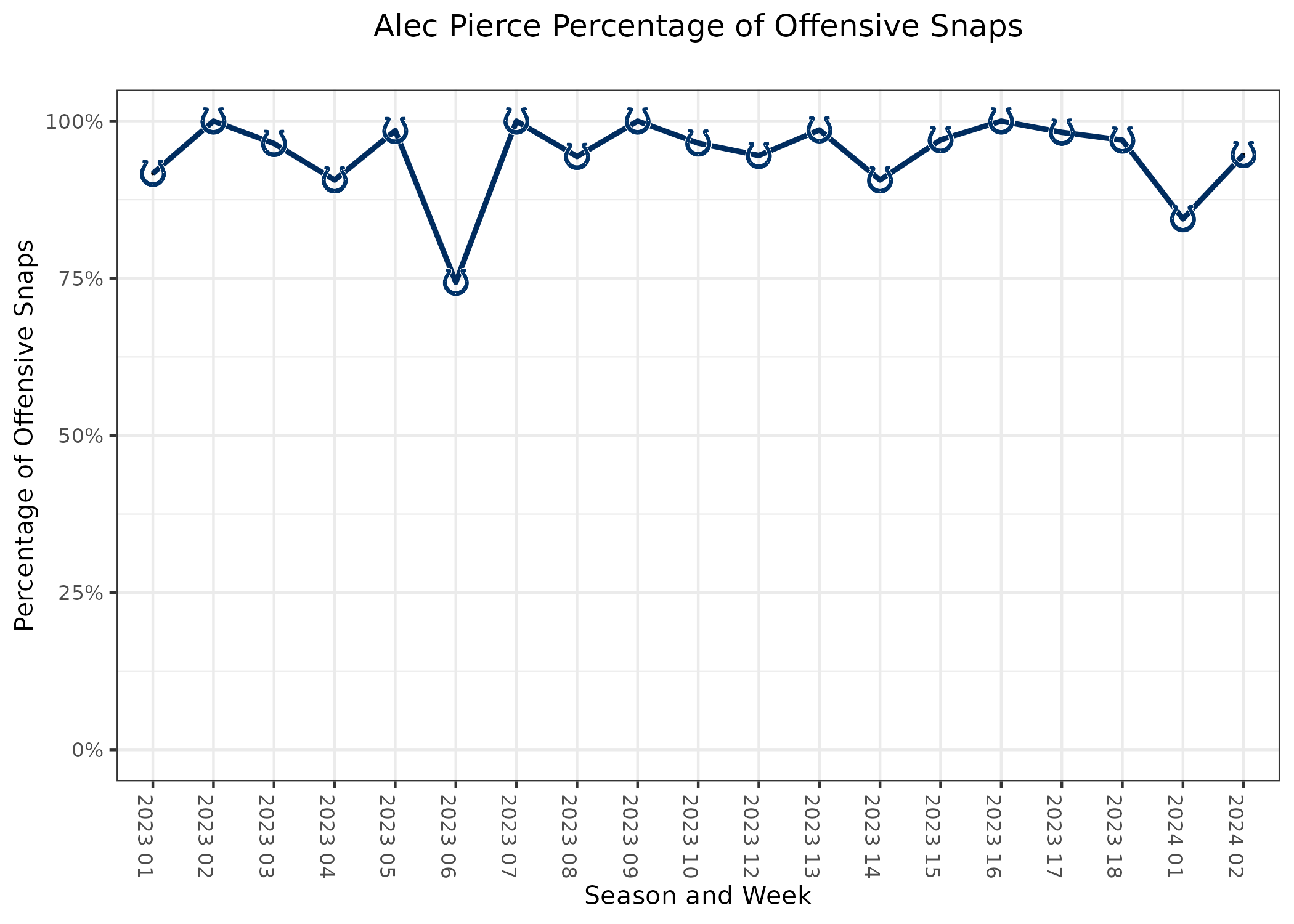
MarShawn Lloyd eased into action: Lloyd made his regular season debut in a limited role.
Lloyd missed Week 1 and was limited all week due to a hamstring injury. He was officially questionable and ended up playing 10 offensive snaps. Those snaps were spread out throughout the game. He played one snap at a time, often to give Jacobs a break. He was already ahead of Emanuel Wilson as the early-down backup. Wilson played more offensive snaps due to his third-down work.
Considering how well Jacobs has played for the Packers, Lloyd is just a handcuff for now, but there is a chance he will carve out a larger role in the Packers offense.
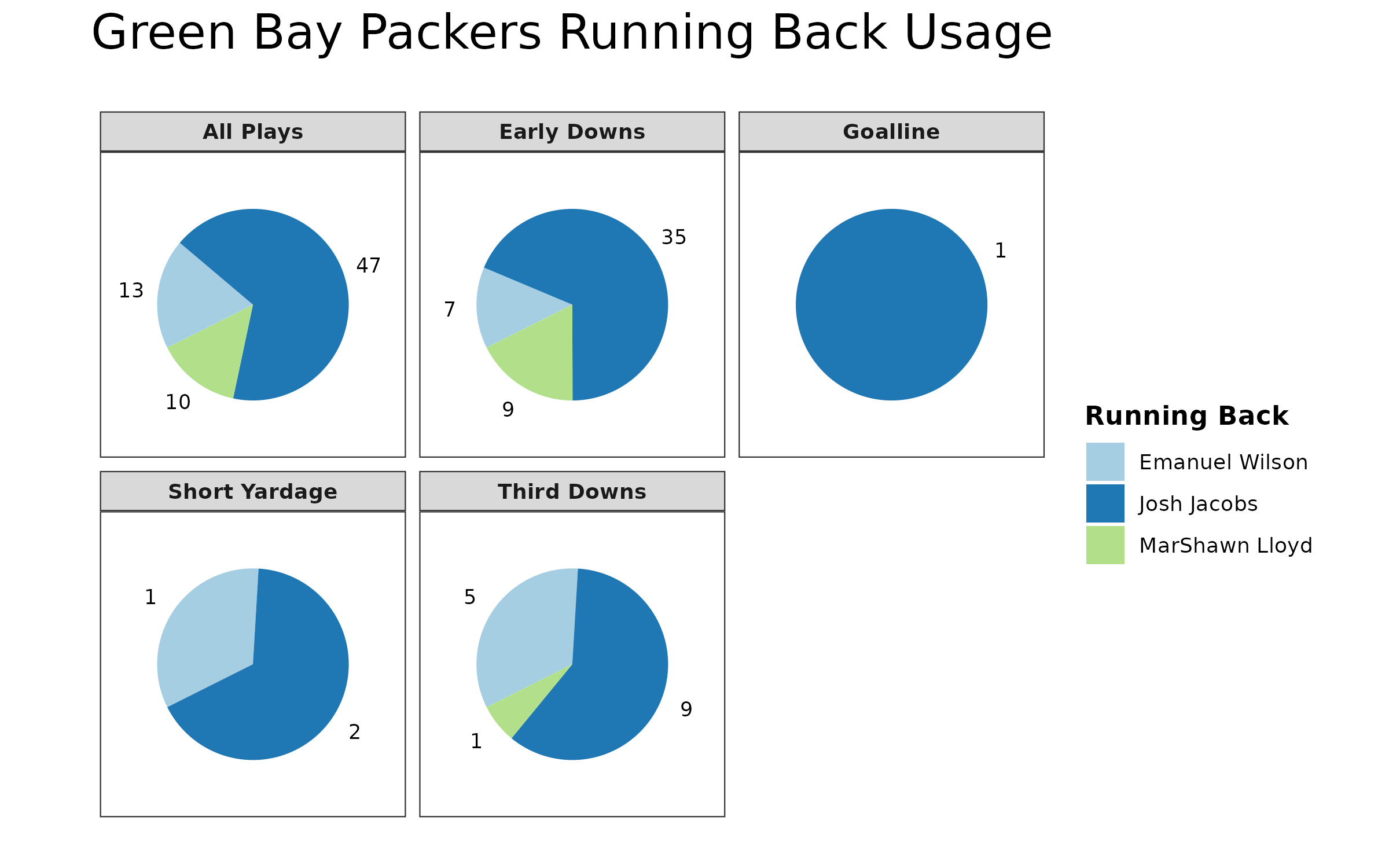
The Packers’ wide receiver rotation continues: The Packers quarterback change had minimal impact on the wide receiver rotation.
The Packers continued to use Romeo Doubs as an every-down wide receiver while Christian Watson and Dontayvion Wicks rotated in the other spot and Jayden Reed only played in 11 personnel. Reed was questionable for this game, but that had no impact on his role, as he was almost always on the field in 11 personnel. The main difference is the Packers didn’t need as much 11 personnel snaps this week as last.
The Packers’ run-first offense makes it difficult to trust any of the wide receivers in the short term, but in the long run, Doubs seems to be the best option. He runs the most routes, led the team today with three receptions for 62 yards, and is one of Jordan Love’s favorite red-zone targets.
Miscellaneous Notes
- Last week, Tucker Kraft was clearly the Packers’ every-down tight end. This week, Luke Musgrave cut into his playing time more, particularly in 11 personnel. This will make it harder to trust either tight end even when Love returns.
Cleveland Browns @ Jacksonville Jaguars
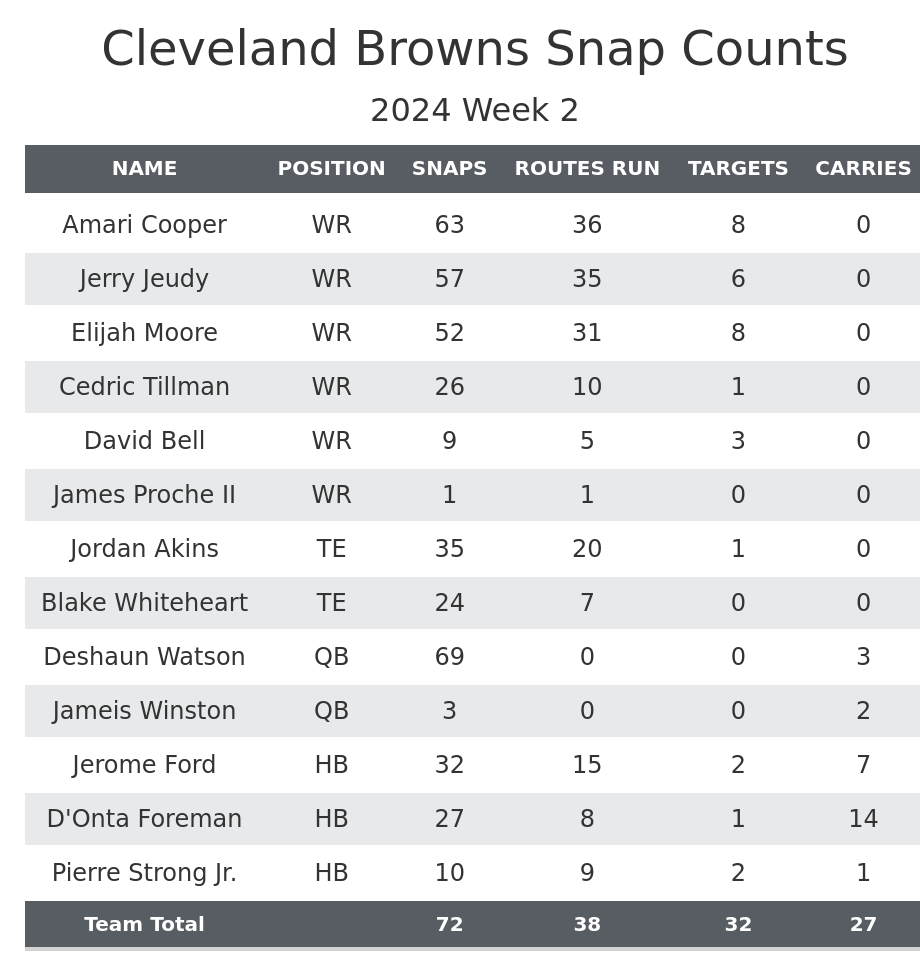
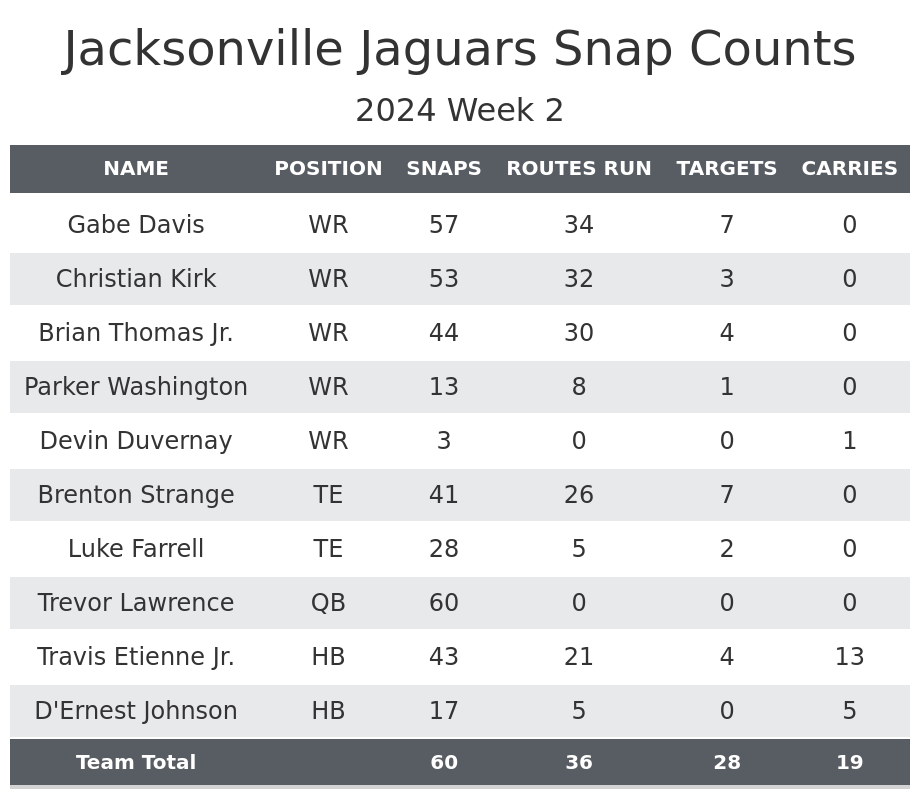
Browns went back to a three-man committee: D’Onta Foreman was much more involved in the Browns offense this week.
In Week 1, Jerome Ford was the clear feature running back, playing 57 of a possible 76 offensive snaps. This was a career-high in both total snaps and percentage of offensive snaps. This made it seem like Ford would be a safe player to start in fantasy leagues.
Instead, this week started as a three-man committee. Foreman only played one snap in the first game but started this game with seven snaps on the first drive. In the first half, Ford played 14 of a possible 36 snaps, while Foreman played 12 and Pierre Strong Jr. played nine.
Strong suffered a hamstring injury early in the second half, which turned this back into a two-man committee. Foreman ended up with twice as many carries as Ford, and he was on the field for the goal-line snaps. Foreman is worth a waiver-wire pickup, but it will be hard to trust either running back going forward. Foreman might end up being the better option of the two if he can convert some goal-line work into touchdowns.
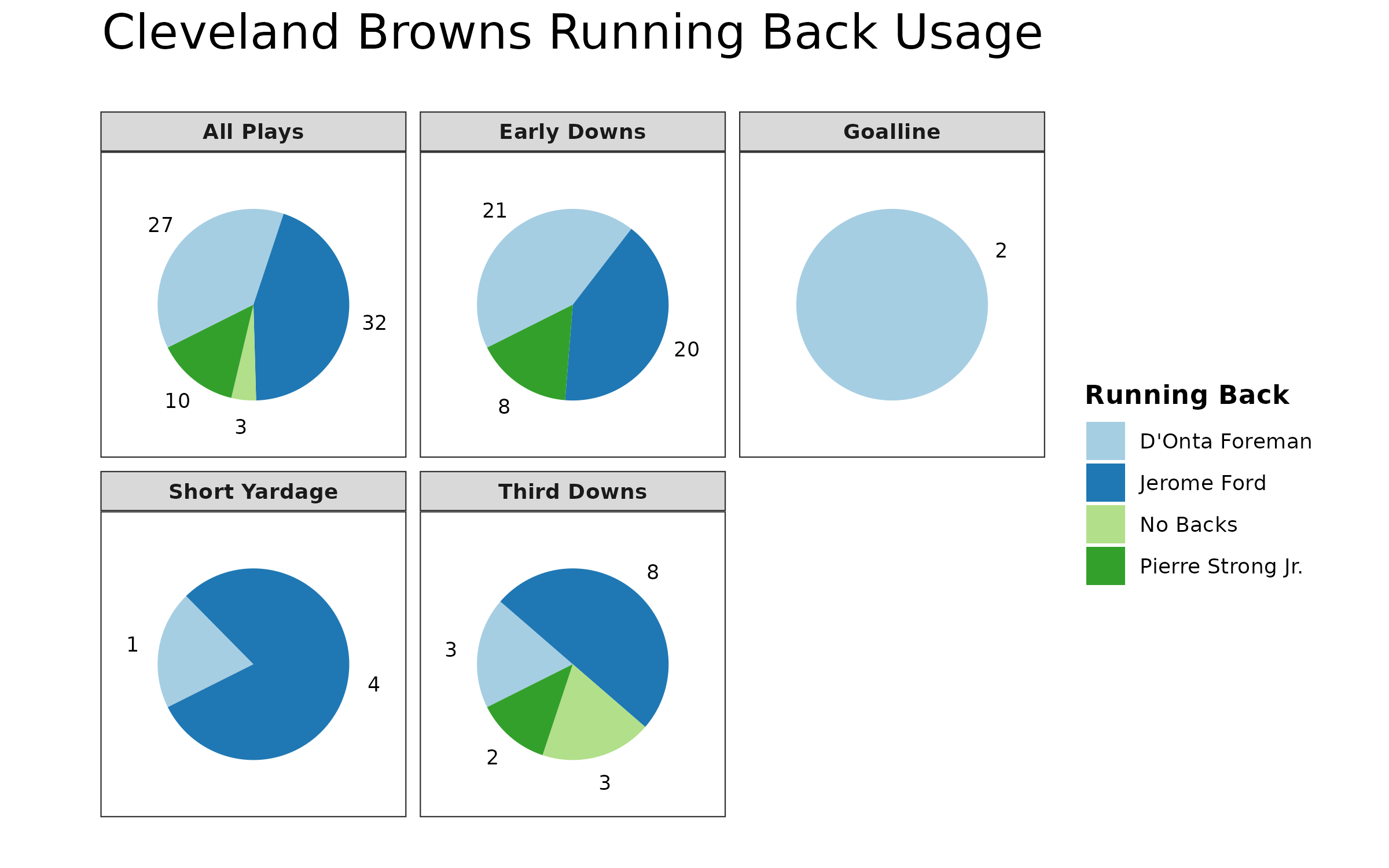
Monitor Tank Bigsby’s health: Bigsby suffered a shoulder injury on a special teams play early in the game and didn’t return.
This meant Bigsby didn’t play a single snap on offense. Therefore, Travis Etienne Jr. played slightly more than last week. It was more than he played late last season but less than early in the season. There wasn’t a rotation by situation, the Jaguars just consistently limited Etienne’s playing time.
This means we are unlikely to see Etienne reach the same heights as early last season, even if Bigsby’s injury is significant. It also means that Bigsby’s playing time in Week 1 might have less to do with him and more to do with the team wanting to limit Etienne’s snaps.
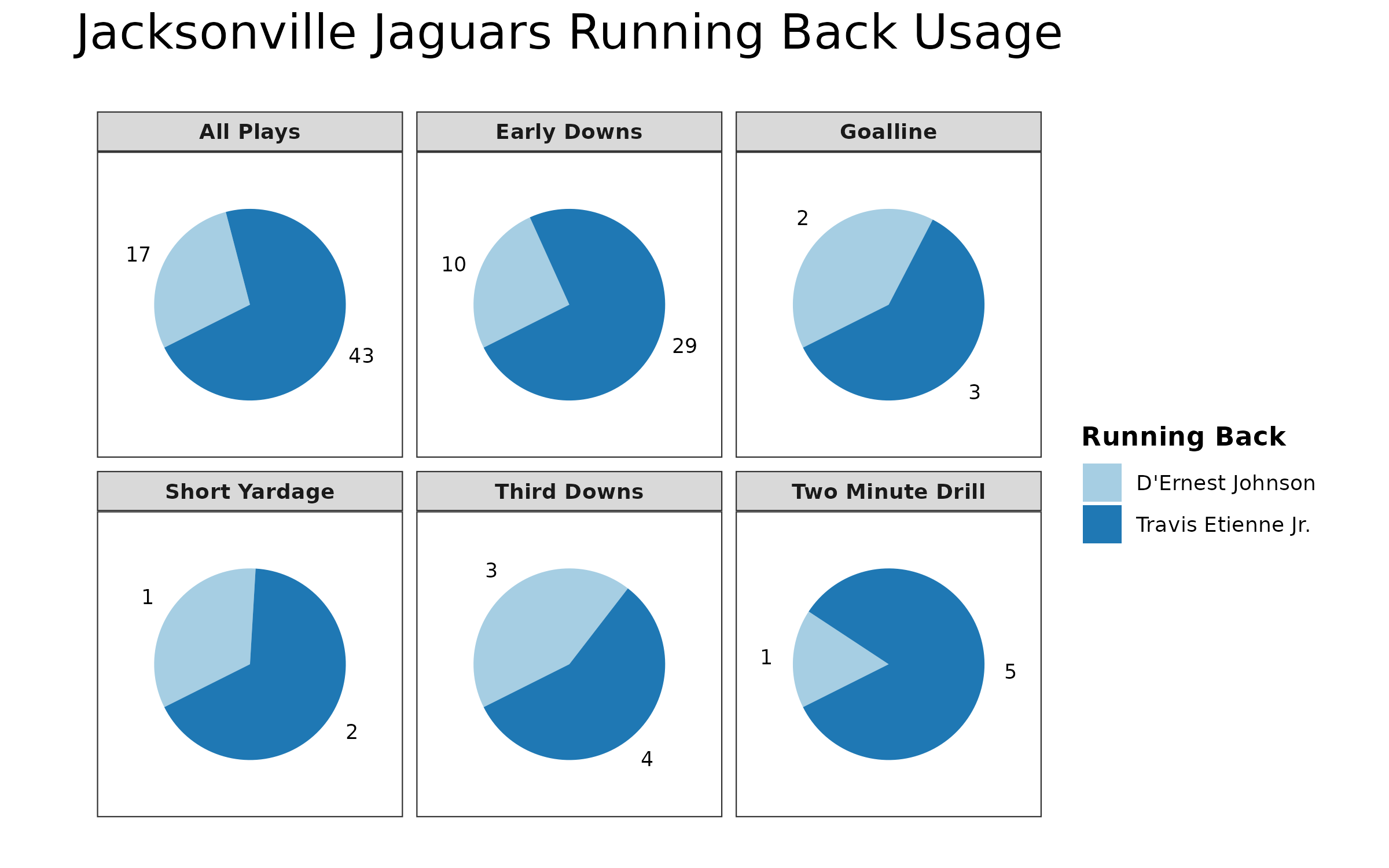
Brian Thomas Jr. makes big plays but is also rotated out more: Thomas caught two passes for 66 yards and 28 yards respectively but played fewer snaps.
Thomas played in 38-of-51 snaps in 11 personnel, while Parker Washington took 13 snaps from that personnel grouping. The good news is Thomas was still one of the primary receivers in 12 personnel, taking six-of-nine snaps. Christian Kirk was limited to three-of-nine snaps in 12 personnel.
The good news for all of the wide receivers is the Jaguars didn’t use as much 12 personnel in this game due to the surprise news that Evan Engram wasn’t playing. Assuming Engram is back sooner rather than later, we can expect more 12 personnel, meaning fewer snaps for Kirk in future weeks.
Thomas can be a borderline fantasy starter going forward, but ideally, he is rotated out a little less and sees a higher target share going forward.
Miscellaneous Notes
- Evan Engram suffered a hamstring injury during warmups and was ruled out. Brenton Strange was Engram’s replacement, taking all of the snaps we would expect Engram to play. If Engram misses significant time, Strange is worth considering off the waiver wire.
- Last week, Elijah Moore was the clear primary slot receiver with 43 snaps from the slot. This week, both Moore and Jeudy played 28 snaps from the slot, while Amari Cooper and Cedric Tillman both played 13 snaps from the slot.
- Browns tight end David Njoku missed this game due to an ankle injury.
- Last week, Jordan Akins was playing 100% of Cleveland’s offensive snaps after Njoku’s injury. This week, Blake Whiteheart took significant playing time from Akins, although it was almost all in run situations.
- The Browns also played 15 snaps in 10 personnel. They join the Cowboys as teams who have used a significant number of 10 personnel snaps while their starting tight end is injured.
- Browns backup wide receiver David Bell was elevated from the practice squad for this game. He suffered a hip injury and was ruled out.
San Francisco 49ers @ Minnesota Vikings
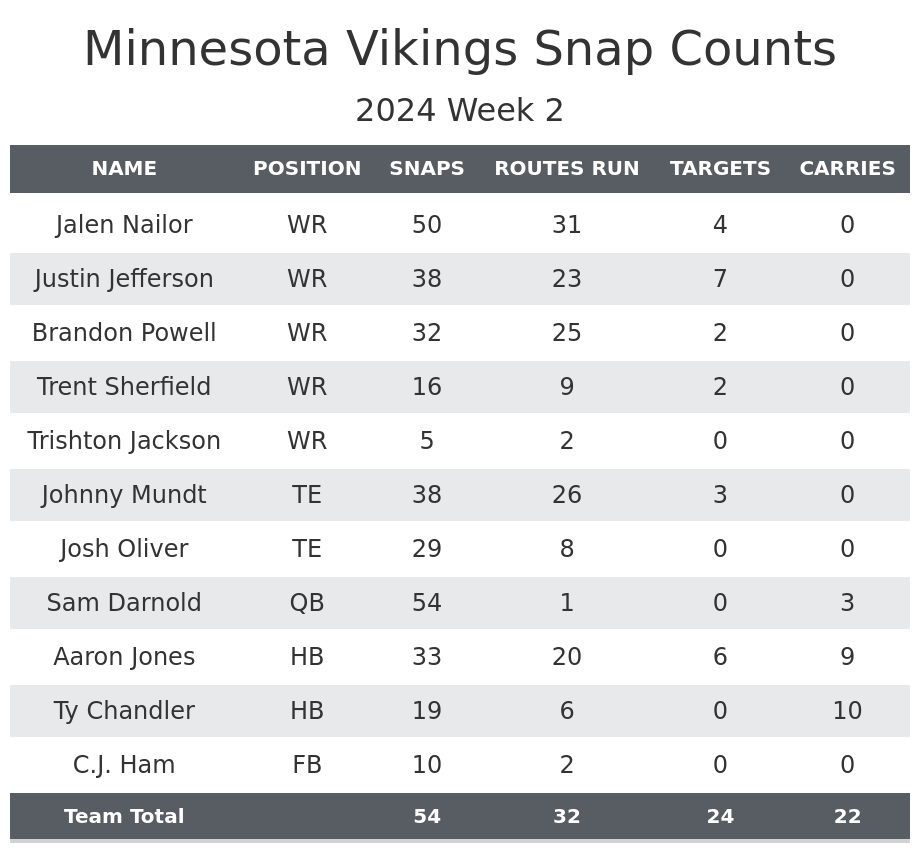
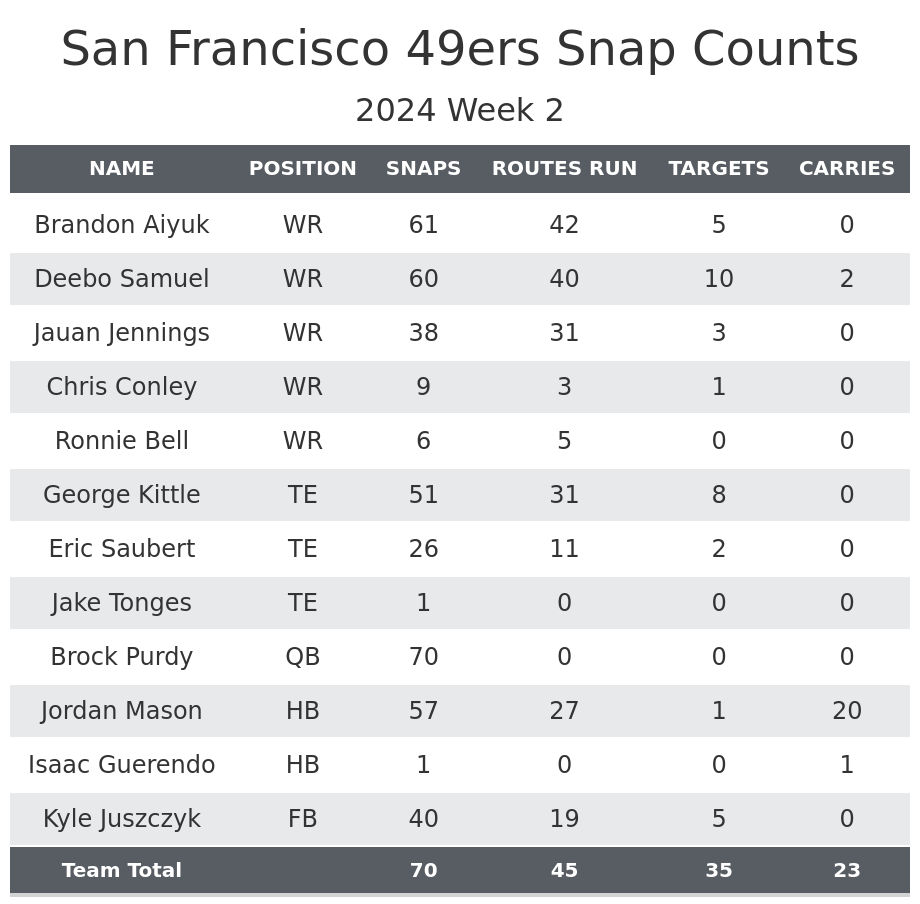
Jordan Mason continues in a feature role: Christian McCaffrey landed on injured reserve due to tendinitis and his return timeline is unknown. At a minimum, he will miss three more games.
Mason continued to be used in a feature role, playing the vast majority of snaps in almost all situations. He ran 20 times for 100 yards and a touchdown.
One difference between last week and this week was that Deebo Samuel wasn’t used as much in the run game. This left Mason on the field for a higher percentage of snaps. The other difference is on a few third downs, Kyle Juszczyk stayed on the field instead of Mason in the backfield. Juszczyk used to play on third downs a lot a few years ago when Elijah Mitchell was the early-down back before the team traded for Christian McCaffrey.
Even if Mason misses some time on third downs, he should remain a top-10 fantasy running back for as long as McCaffrey is out.
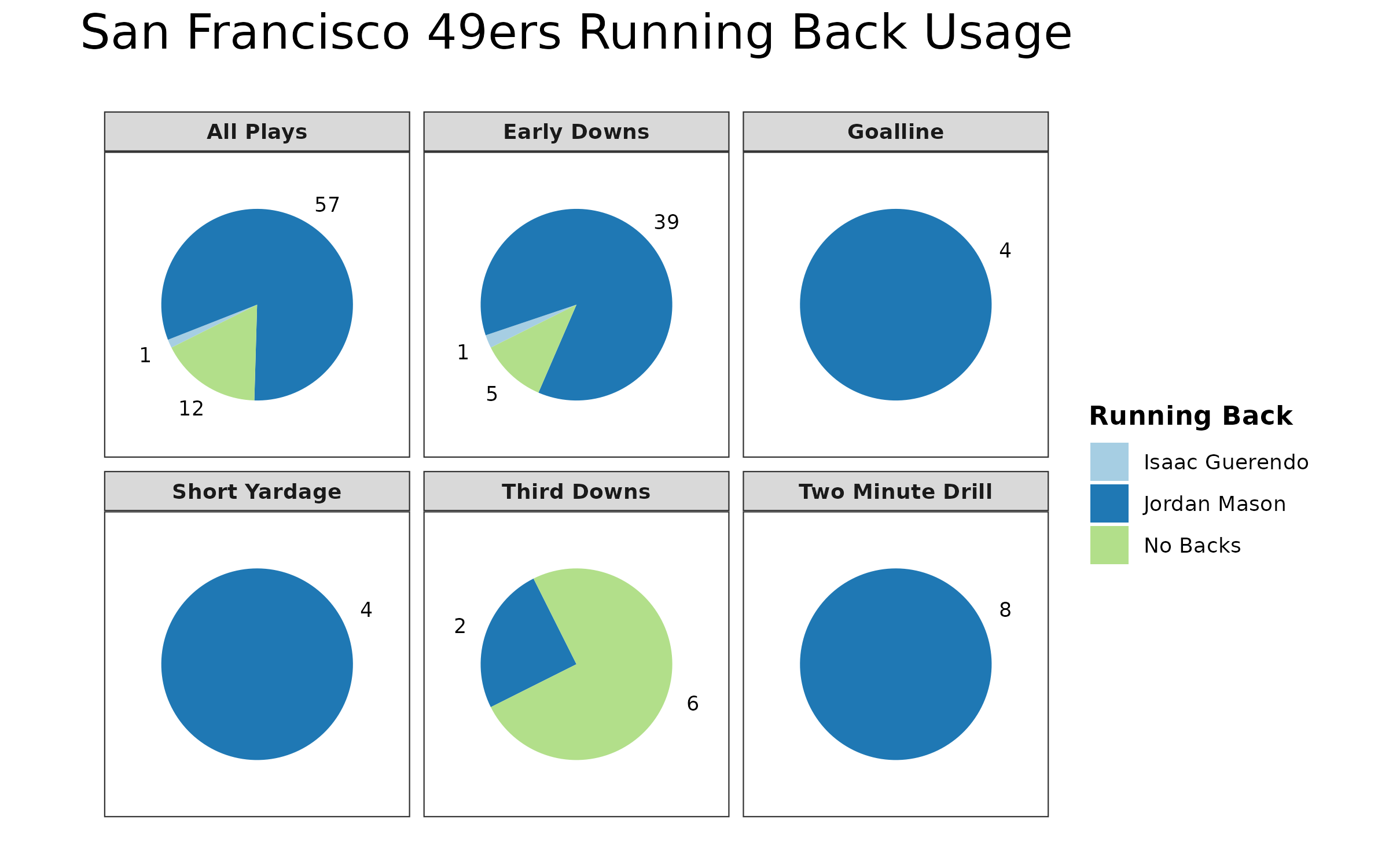
Ty Chandler leads the Vikings in rushing yards: Chander ran 10 times for 82 yards compared to Aaron Jones‘ nine carries for 32 yards.
Jones was the Vikings’ clear main running back for most of the game. On the first seven drives, Jones played 27 snaps to Chandler’s six. Most of Chandler’s snaps came on the fourth of those seven drives.
Jones then went to the medical tent and was later able to return to the game, but during that time, Chandler played well as a runner. Jones was still the better receiver with five receptions for 36 yards while Chandler was never targeted.
Jones may be fine, and the Vikings could go back to the split they had to start this game. That would make Jones a must-start and leave little fantasy value for Chandler. It’s also possible that Jones isn’t 100% or that the Vikings simply like what they saw out of Chandler and think he deserves more time. Regardless, Chandler should be on fantasy rosters as the clear handcuff to one of the league’s older running backs.
Vikings adjust to injuries at wide receiver: Jordan Addison was inactive in this game due to an ankle injury.
While Jalen Nailor supposedly won the Vikings’ third wide receiver spot in training camp, Brandon Powell playing more than Nailor before Addison’s injury last week. However, in this game, the wide receiver rotation was simple. Nailor joined Justin Jefferson as every-down receiver while Powerll joined in three-receiver sets.
Jefferson suffered a leg contusion in the third quarter and didn’t return. Trent Sherfield replaced Jefferson in the lineup. Jefferson doesn’t believe he is seriously injured and is considered day-to-day. Nailor should be considered a waiver target. He caught three passes for 54 yards and a touchdown, and there is at least a chance he will be the Vikings’ top wide receiver next week.
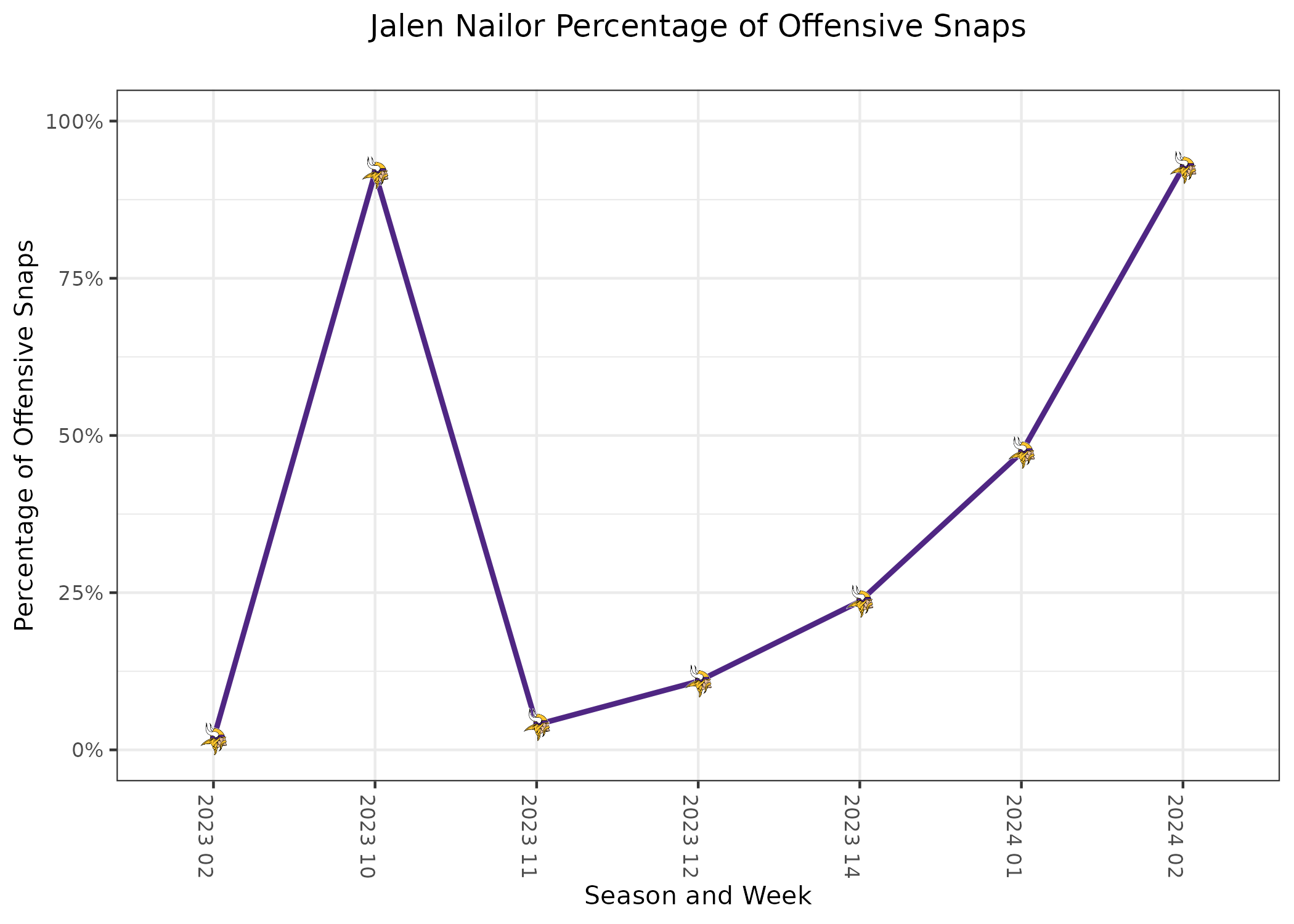
Miscellaneous Notes
- George Kittle was carted to the locker room in the second half but was able to return and finish the game. He was reportedly cramping and got an IV, so this is likely nothing serious but explains him playing fewer snaps than usual.
- Brandon Aiyuk was on a snap count in Week 1 after not practicing as much during training camp with a holdout. He was no longer on a snap count in this game.
Seattle Seahawks @ New England Patriots
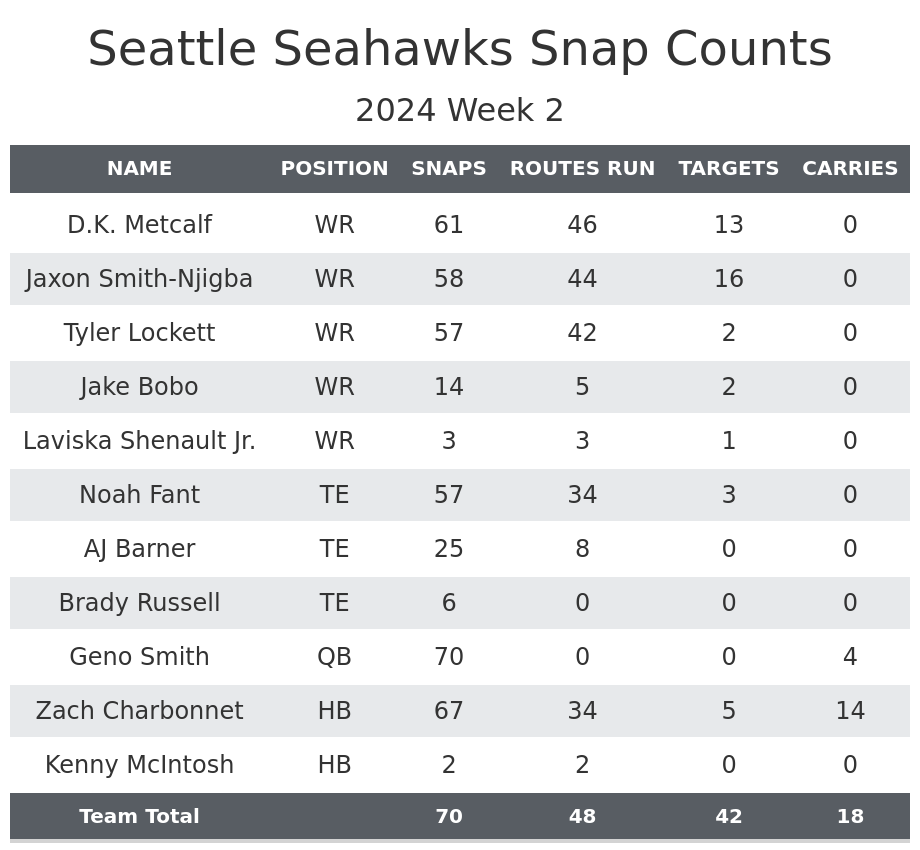

Zach Charbonnet had a feature role without Kenneth Walker III: Walker III was doubtful for this game due to an oblique injury and was ultimately inactive.
There were also reports before the game that the Seahawks will be cautious with the injury, so Walker might be out for multiple weeks. This left Charbonnet as the Seahawks’ lead running back. He played an every-down role for Seattle, only leaving the field for a four-receiver set and then twice in the fourth quarter for Kenny McIntosh.
This is the ideal role for a fantasy running back, as only a few players see anything close to this role. He only averaged 2.7 yards per carry but scored a touchdown and caught five passes to save his fantasy value. Despite the low rushing yardage total, he is a must-start for however long Walker is out for given his role and the quality of the offense.
Jaxon Smith-Njigba leads in two-receiver sets: The Seahawks’ wide receiver is playing an expanded role so far this season.
Smith-Njigba played in 11 of a possible 19 snaps in 11 personnel last week. This is much more than what he played last week, and it was good to see him play above Jake Bobo. It was worth noting Tyler Lockett was limited in practice leading up to Week 1.
Lockett was again limited to start this week, and Smith-Njigba played in seven of 12 possible snaps in 12 personnel. Lockett may play more once he’s fully healthy, but after how well Smith-Njigba played in this game, we may have reached the point where Smith-Njigba is a clear top-two wide receiver for the Seahawks while Tyler Lockett is third.
The Seahawks also ran 11 personnel for 54 snaps, so the 12 personnel snaps didn’t really impact Smith-Njigba’s fantasy value for this game, but it’s a positive sign for him, in general, to go along with his positive stat line.
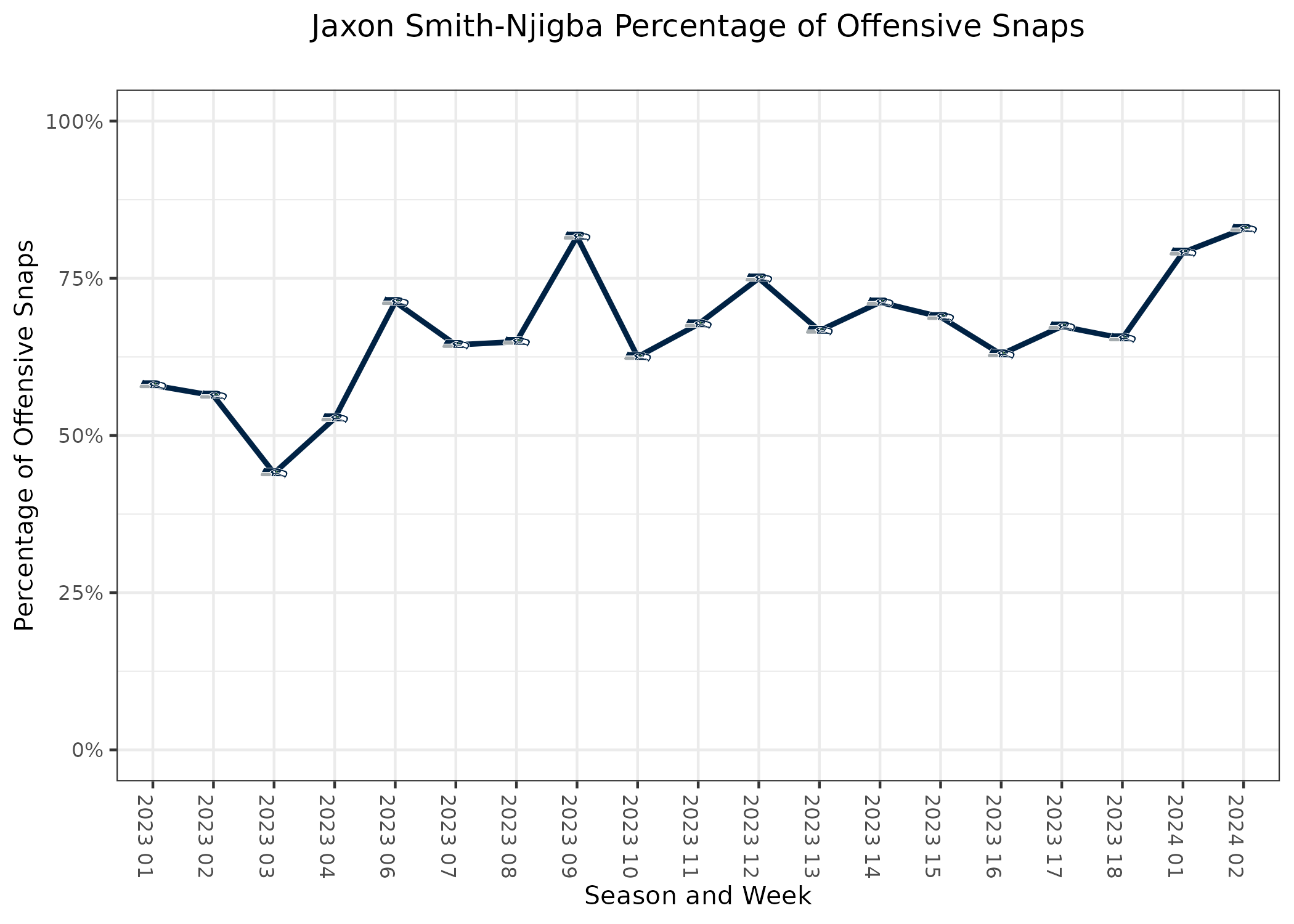
Don’t rush to pick up Antonio Gibson: He ran 11 times for 96 yards, but that doesn’t mean he should be a priority waiver target.
Gibson had a larger role in the Patriots’ offense compared to Week 1, but he was still a clear second to Rhamondre Stevenson on both early and third downs. He broke one long run for 45 yards, but as long as Stevenson is healthy, it’s hard to imagine putting Gibson in your fantasy starting lineup with this role. It’s still perfectly fine to have Gibson on your roster as Stevenson’s handcuff because Gibson could see 20-plus touches per game if Stevenson suffers an injury. However, this game shouldn’t change your view too much on him.
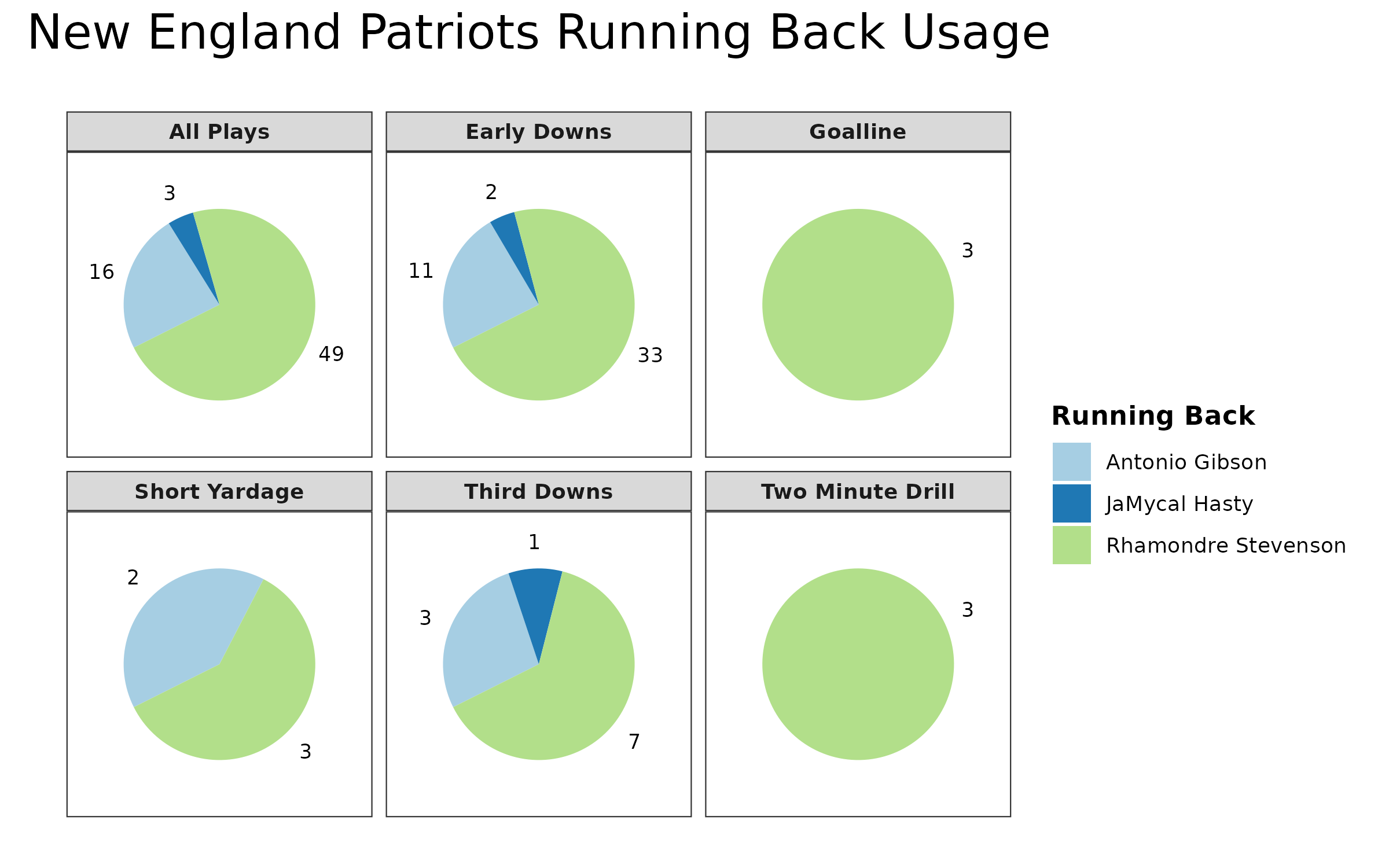
Add Hunter Henry: The Patriots tight end caught eight of 12 passes for 109 yards.
Henry has been a fantasy starter on and off throughout his career. His role in the offense hasn’t changed, as he consistently plays in two tight end sets as well as most single tight end sets. The fact that Jacoby Brissett trusted Henry so much in this game means there is a chance he will be trusted again in future games.
While he will likely be the top waiver-wire target at tight end this week, it’s not worth spending a lot of FAAB to get him, and if he follows this up with two or three games with minimal fantasy production, it will be OK to drop him again.
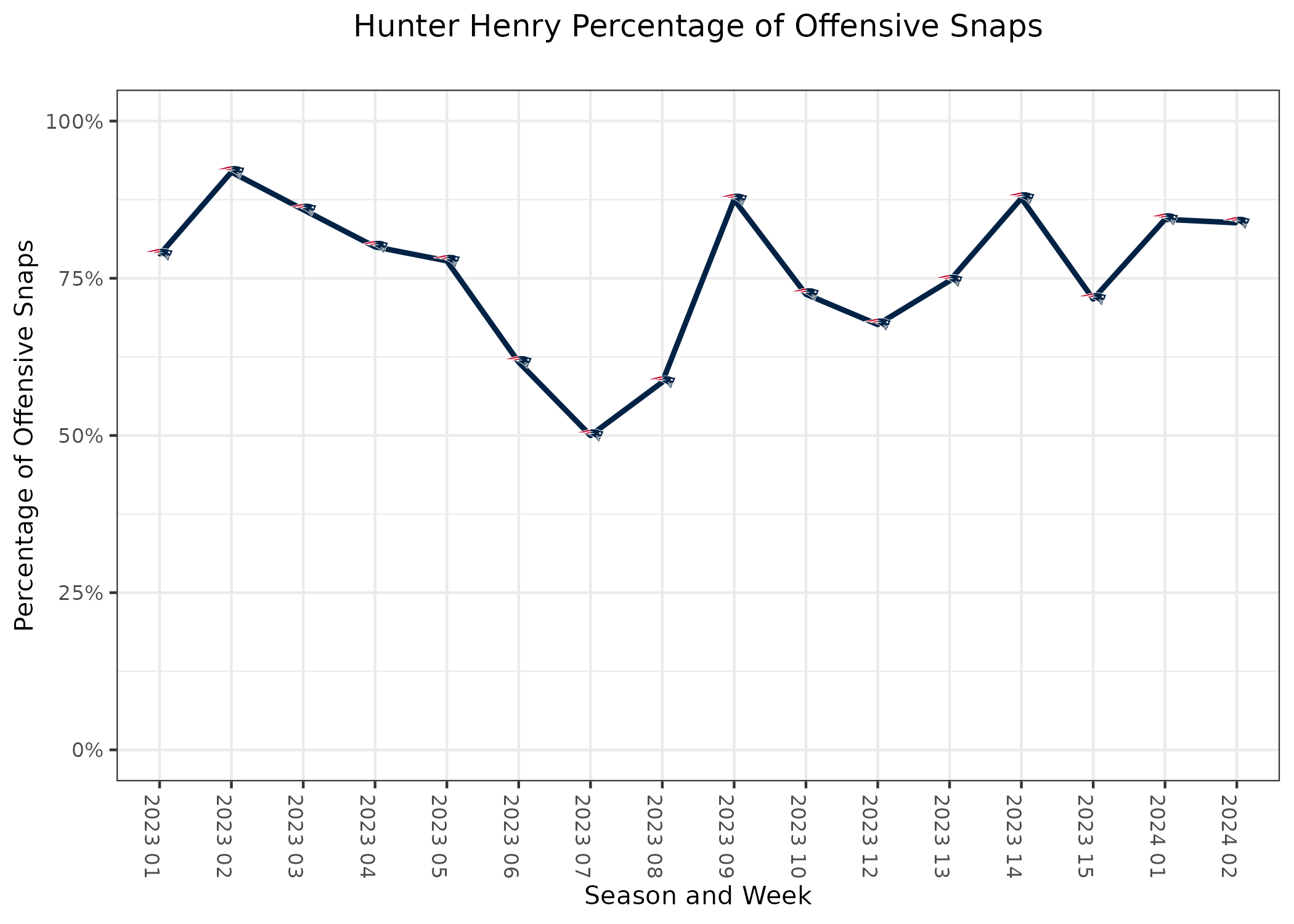
Miscellaneous Notes
- Seahawks backup tight end Pharaoh Brown remains out due to a foot injury.
- Patriots rookie wide receiver Javon Baker was active this week after being inactive last week. He replaces Kayshon Boutte on the gameday active roster.
- Tyquan Thornton fell to a clear fourth on the Patriots depth chart, but K.J. Osborn, Ja’Lynn Polk and Demario Douglas still weren’t running enough routes to trust them in fantasy starting lines. It was good to see Polk score his first touchdown, but wide receivers were only targeted on five of New England’s 27 pass attempts.
New York Jets @ Tennessee Titans
- Calvin Ridley: 4 receptions, 77 yards, 1 touchdown, 1 carry, 10 rushing yards, 1 rushing touchdown
- Breece Hall: 14 carries, 62 yards, 7 receptions, 52 receiving yards, 1 receiving touchdown
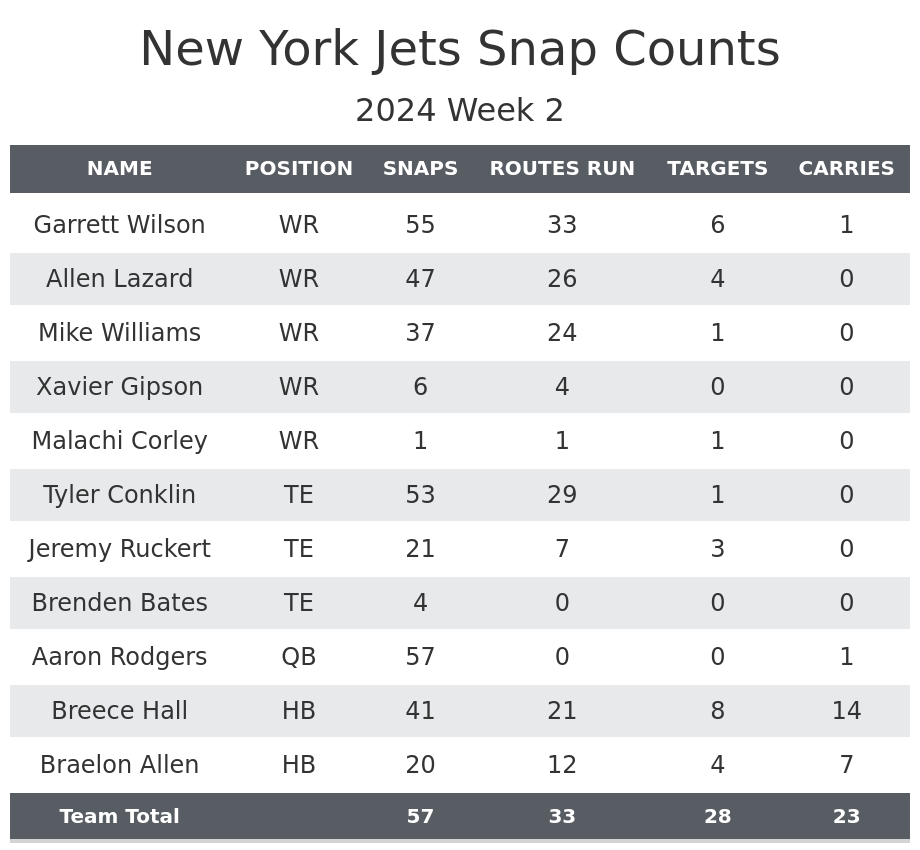
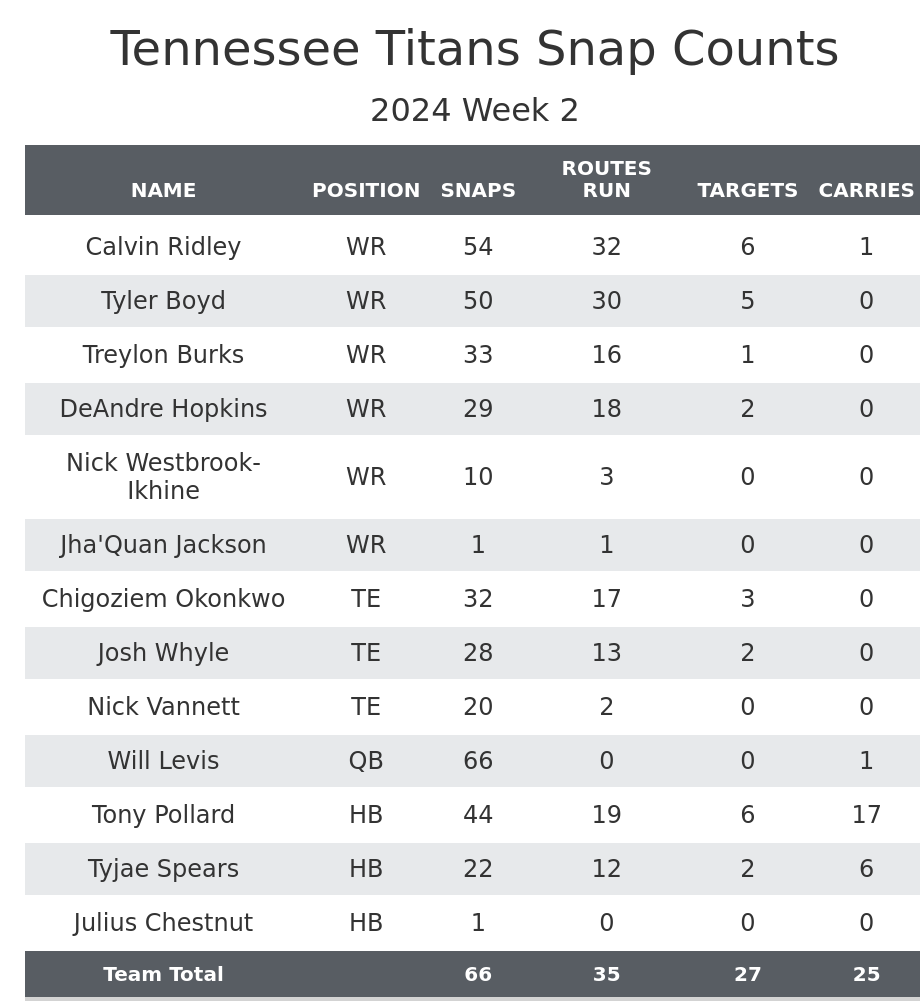
Braelon Allen scores twice: The Jets’ fourth-round rookie ran seven times for 33 yards and a touchdown while catching two passes for 23 yards and a touchdown.
Allen was competing with Isaiah Davis for the primary backup job throughout the preseason, and this game made it clear that Allen is clearly ahead of Davis. He is Breece Hall‘s handcuff.
This doesn’t mean Allen will have standalone value going forward. It wouldn’t be surprising for Allen to see five-to-10 touches per game going forward, but it just happened to be that this week, two of those touches resulted in touchdowns.
There is also no need to worry about Hall’s fantasy value. He touched the ball over 20 times, which should be the case going forward. If the Jets are running fewer plays like they did last week, then they simply don’t take Hall out of the game as much. If the Jets end up running a lot of plays in a game, it might mean a little more Allen.
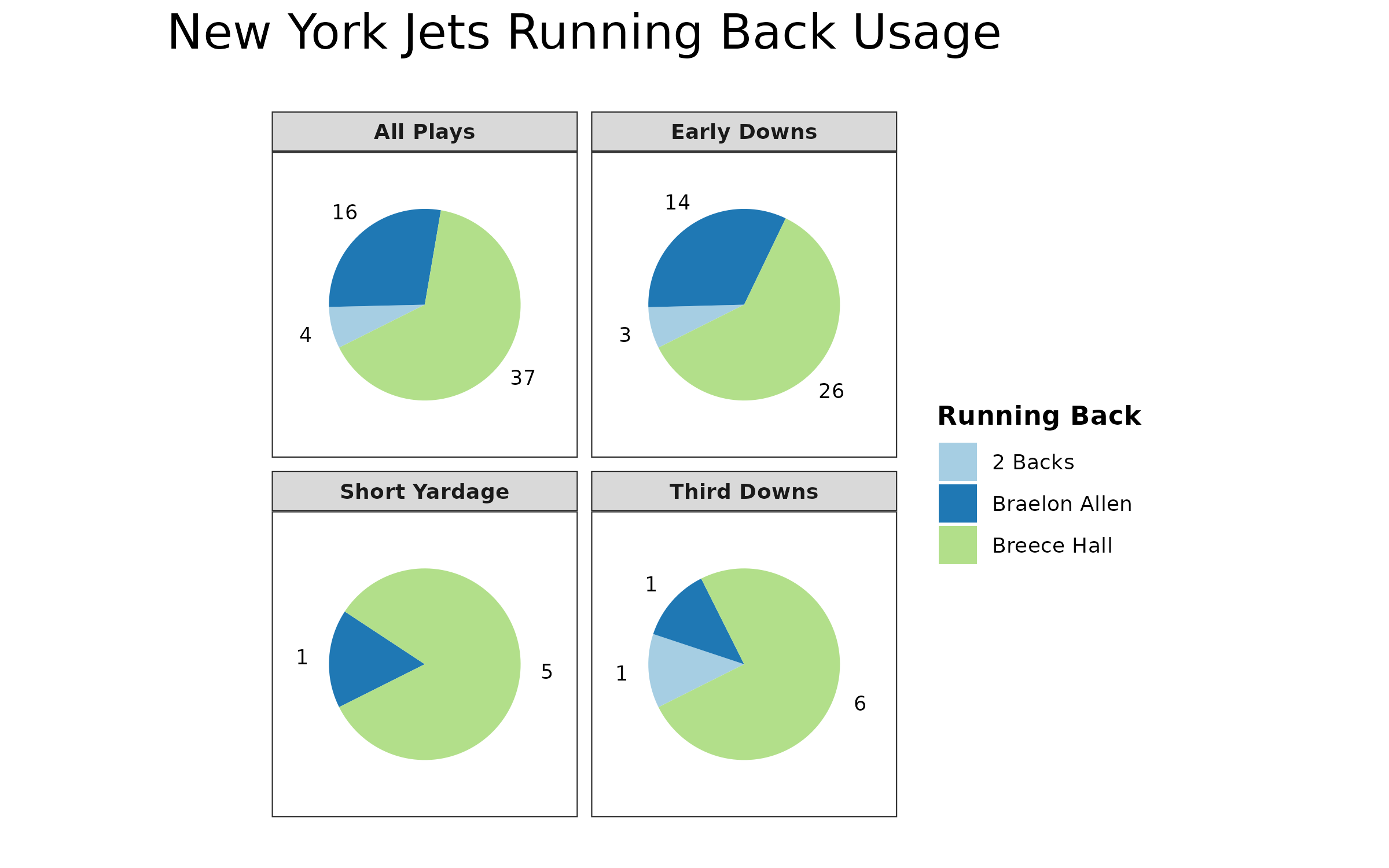
Mike Williams overtakes Xavier Gipson: The former Los Angeles Chargers’ star wide receiver barely played in Week 1.
Williams missed most of 2023 due to an ACL tear and when he signed with the Jets in the offseason, it wasn’t clear if he would be ready for Week 1. He ended up playing nine offensive snaps with Xavier Gipson as the third wide receiver that week.
This week, Williams almost always joined Garrett Wilson and Allen Lazard in 11 personnel. Wilson and Lazard took most of the work in 12 personnel, outside of four snaps where Williams replaced Lazard. Williams also joined Wilson in 21 personnel where Lazard didn’t take a single snap.
Williams caught his only target for 19 yards, while Lazard caught two passes for 11 yards. It wouldn’t be surprising if Williams ends up playing more snaps out of 12 personnel in the future while gaining more targets.
It’s worth noting Gipson led the Jets in snaps from the slot in Week 1, so Williams joining the lineup led Lazard to become the primary slot receiver. Wilson also ran 14 snaps from the slot, where he caught three of his passes for 49 yards.
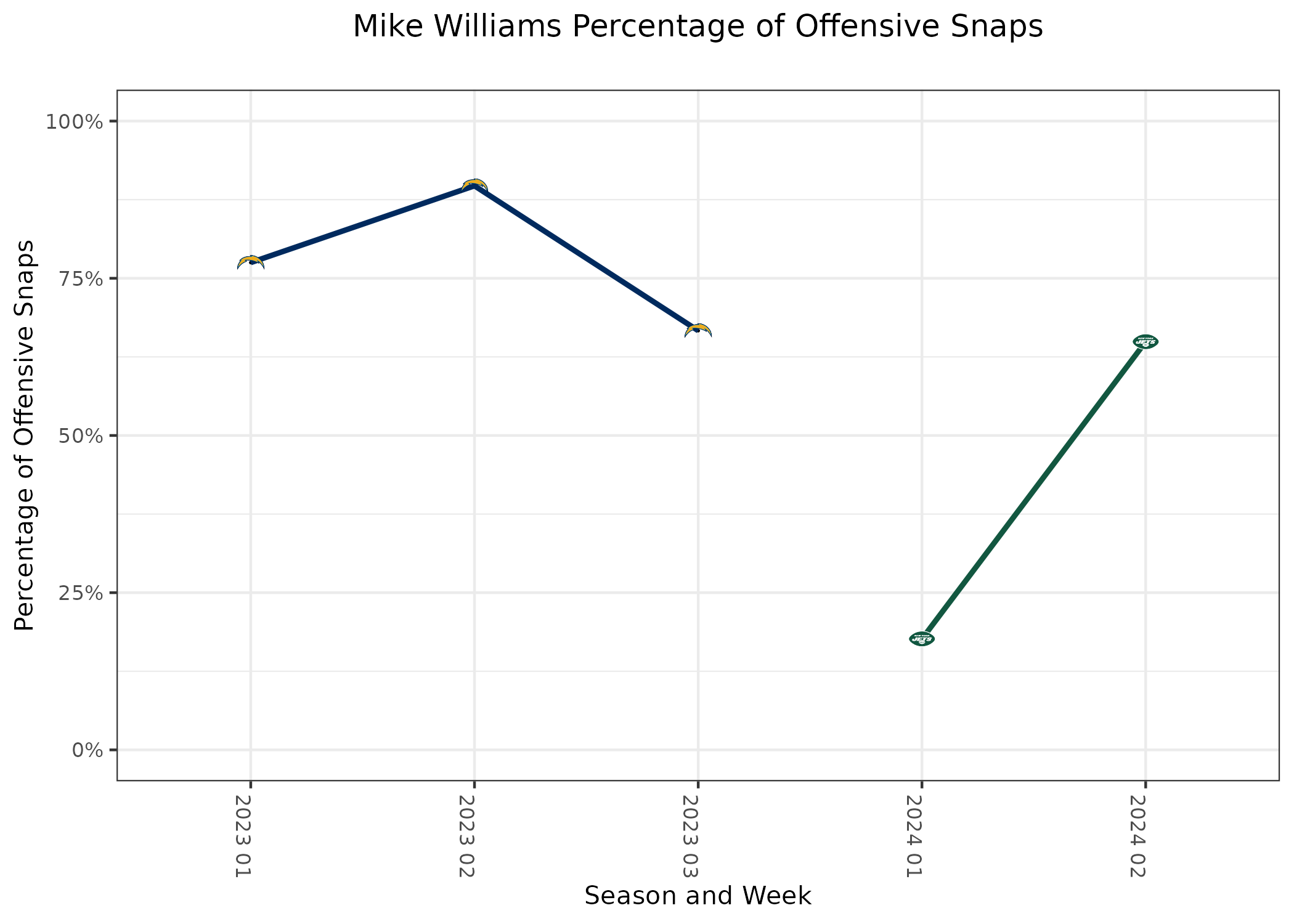
Monitor Tyjae Spears‘ health: Spears suffered an ankle injury and didn’t return.
In Week 1, it was a little surprising how much more Pollard played than Spears, as Pollard took 39 snaps to Spears’ 29. Pollard had 19 touches to Spears’ eight in that game.
In the first half, Spears ended up outsnapping Pollard 20-15. Pollard ran seven times to Spears’ six, so everything was closer than Week 1. Pollard played the first few snaps in the second half, while pears only played two snaps in the half before suffering his ankle injury. Julius Chestnut took one snap in the quarter. Pollard took the rest of the work in the second half, including all 19 snaps in the fourth quarter.
Pollard is a borderline fantasy starter if Spears is healthy and the Titans continue their first-half usage, but Pollard is a must-start for however long Spears is out for.
DeAndre Hopkins increases his playing time: Hopkins is heading in the right direction but still can’t be trusted in fantasy starting lineups.
Hopkins suffered an MCL tear near the start of training camp, so the team has eased Hopkins back into action. In Week 1, he played 17 offensive snaps and that increased to 29 this week. In Week 1 he was a primary receiver in 12 personnel, with just a small fraction of 11 personnel snaps. This week, he barely played in 12 personnel and played in just over half of the snaps in 11 personnel. He took 27 snaps to Treylon Burks‘s 25.
We can expect him to see even more snaps next week, but we don’t know how long it will be until he’s a full-time starter again. He caught his only target for eight yards. He could be considered a buy-low candidate.
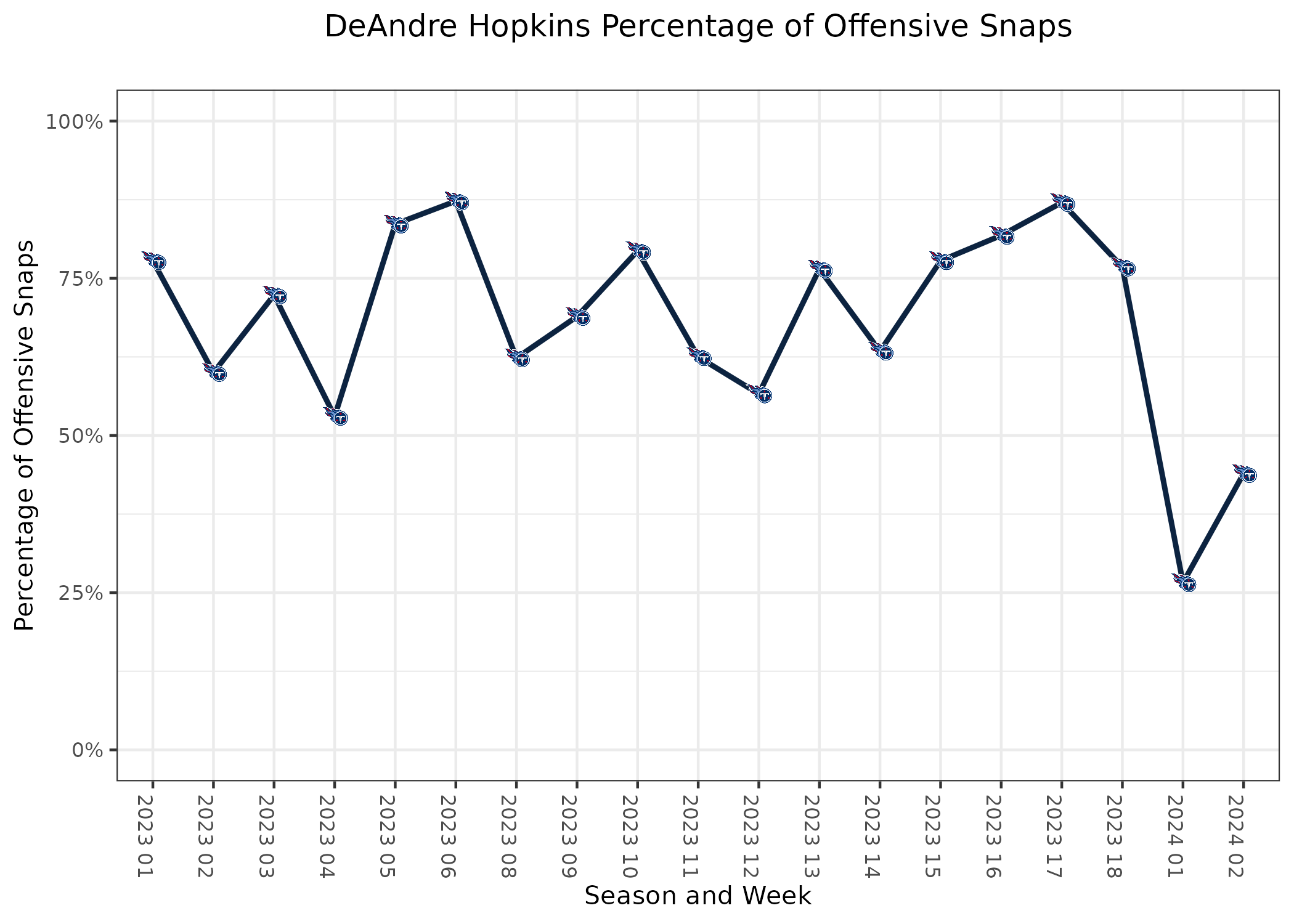
Miscellaneous Notes
New York Giants @ Washington Commanders
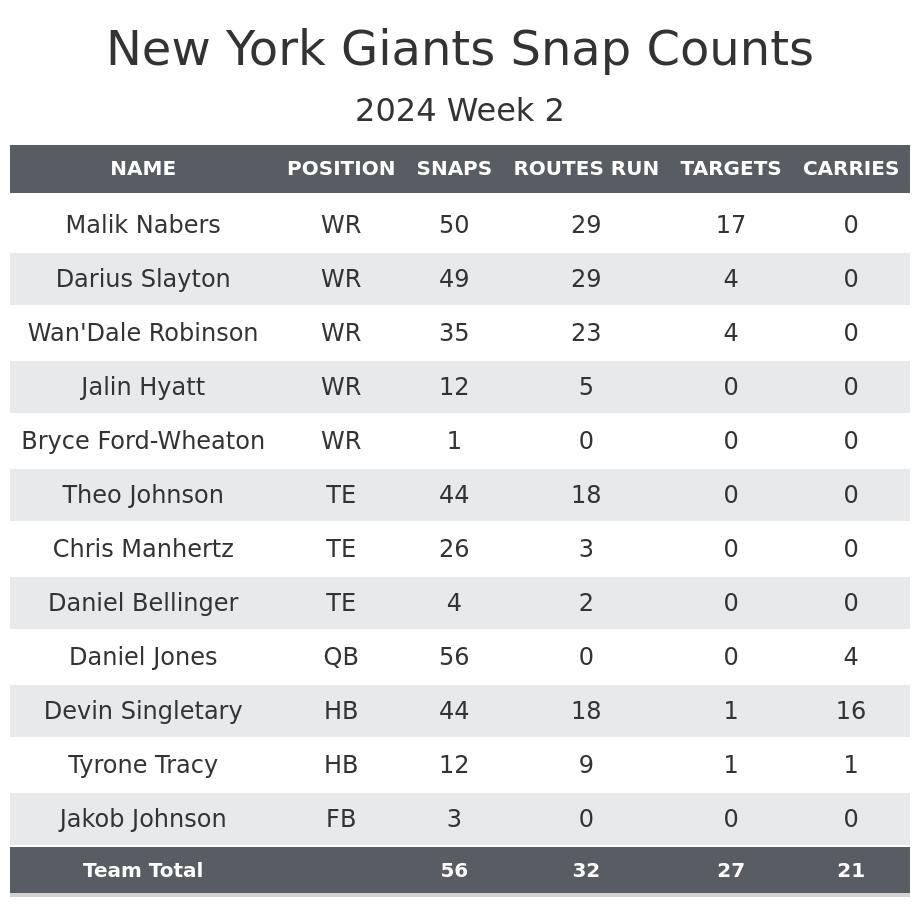
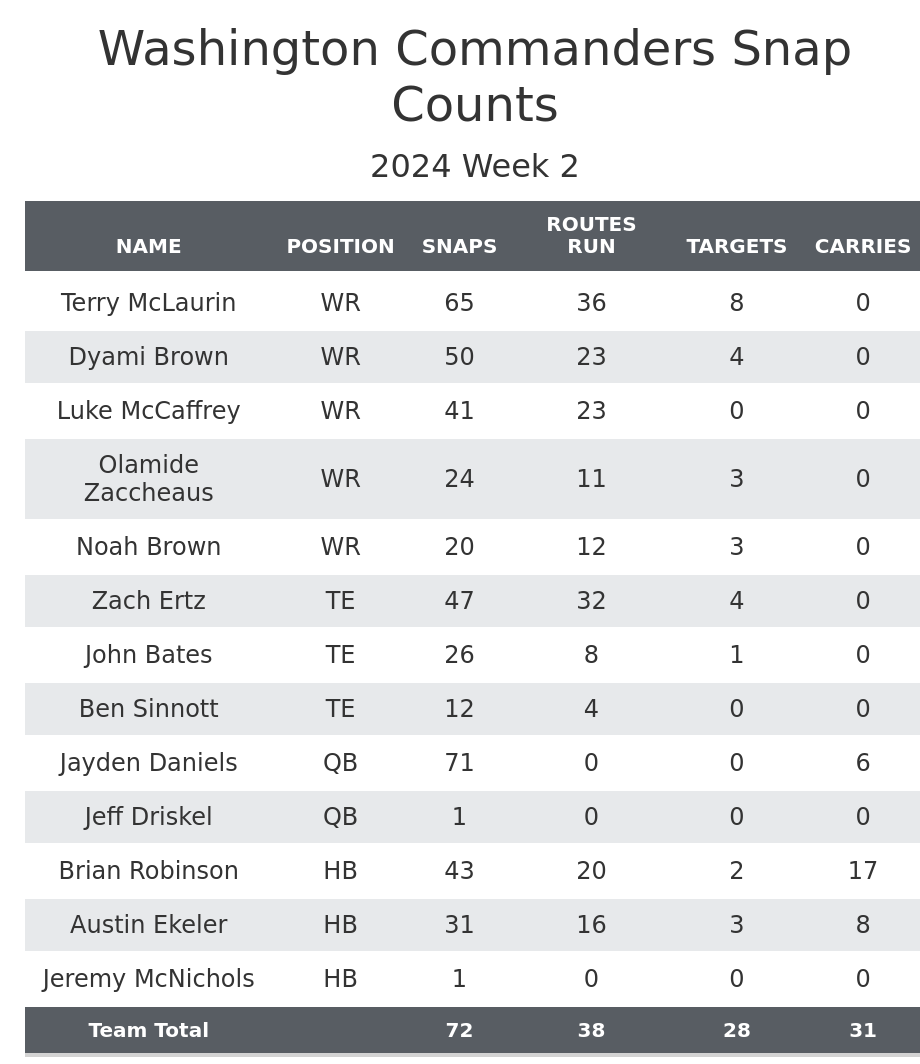
Devin Singletary is a sell-high candidate: The Giants’ lead running back helped his fantasy managers, but a concerning trend has emerged.
The Giants running back played a slightly higher percentage of snaps this week than last. He and Malik Nabers were the Giants’ only source of offense. The only concern is Tyrone Tracy has taken five of the Giants’ six snaps when they’ve been within six yards of scoring. Those five snaps by Tracy have spanned three different drives over the two games. Tracy is four inches taller and a bigger back, so, understandably, Tracy is the player New York wants on the field when it is close to scoring.
Singletary’s touchdown this week was from the seven-yard line. He hasn’t been much of a factor in the passing game, and Singletary’s touchdowns will be hard to come by. This means his fantasy value will come almost entirely off of rushing yards. While he can be a fantasy starter in the right matchup, it could be good to trade him now because he’s coming off a good game.
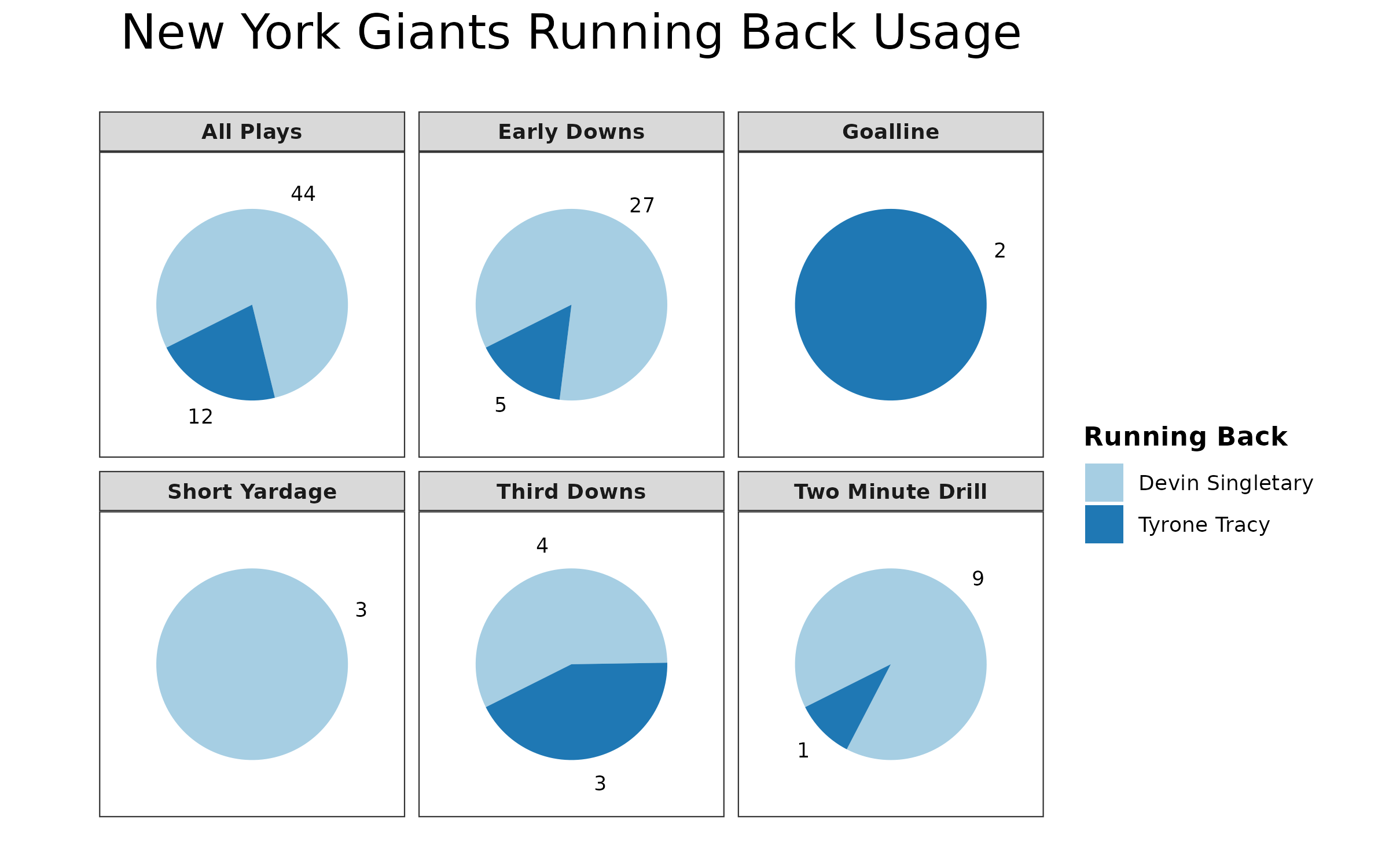
Noah Brown makes his Commanders’ debut: Brown was active after being inactive last week, replacing Jamison Crowder in the lineup. Brown was signed after the Houston Texans released him on cutdown day.
Last week, the Commanders’ wide receiver rotation was simple, Terry McLaurin had one of the two outside wide receivers. Dyami Brown and Olamide Zaccheaus rotated as the other outside receivers, while Luke McCaffrey played in 32-of-33 snaps in 11 personnel, primarily from the slot. No one else was playing in the slot with any kind of consistency.
This week, Dyami Brown was clearly ahead of Zaccheaus in both 11 and 12 personnel. This led the Commanders to use Zaccheaus more in the slot compared to Week 1 or the preseason. Zaccheaus has a history of primarily playing in the slot both last year with the Philadelphia Eagles,and earlier with the Atlanta Falcons. This meant McCaffrey only played 39-of-57 snaps out of 11 personnel.
Noah Brown was the primary backup to Dyami Brown on the outside. Noah Brown was the Commanders’ most productive receiver with three receptions for 56 yards. Dyami Brown has only one game of 56 or more yards in his NFL career. It wouldn’t be surprising for Noah Brown to gain more playing time as early as next week. He’s worth a waiver wire target if he becomes Jayden Daniels’ favorite wide receiver.
Miscellaneous Notes
- Giants tight end Theo Johnson is the team’s clear primary receiving tight end, but he is asked to pass block more than most tight ends. In Week 1, he was tied for the league lead in pass-blocking snaps by a tight end at eight. Teammate Chris Manhertz was not far behind at six. This week, they both stayed in to block even more often. This will make it hard for Johnson to see fantasy value this season.
- Giants wide receiver and returner Gunner Olszewski was active last week but reaggravated a groin injury in pregame warmups, forcing him to miss the game. He landed on injured reserve on Saturday. The team signed Ihmir Smith-Marsette to replace him.
- Commanders rookie tight end Ben Sinnott remains a clear third on the depth chart. When Sinnott is playing significantly in 12 personnel with John Bates, Bates takes some snaps from Zach Ertz on 11 personnel. If Ertz suffered an injury, Bates would likely see more of an increase in snaps than Sinnott. In most redraft leagues, Sinnott isn’t worth keeping on the roster.
Los Angeles Rams @ Arizona Cardinals
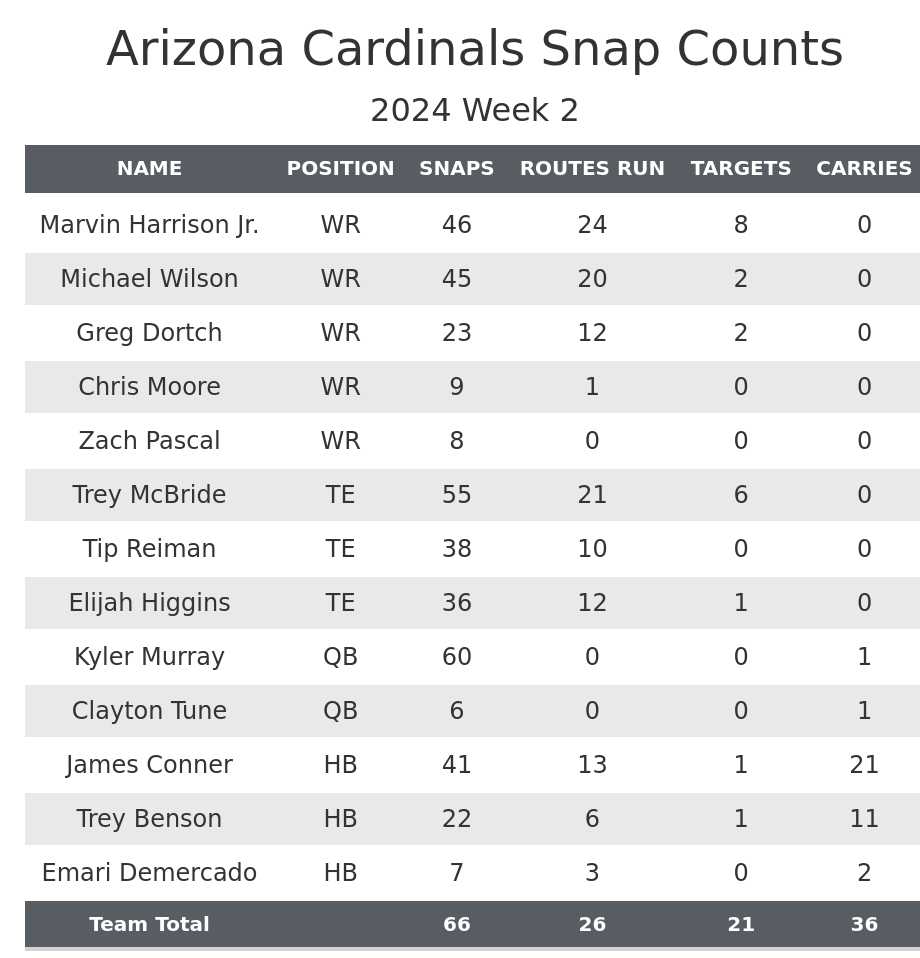
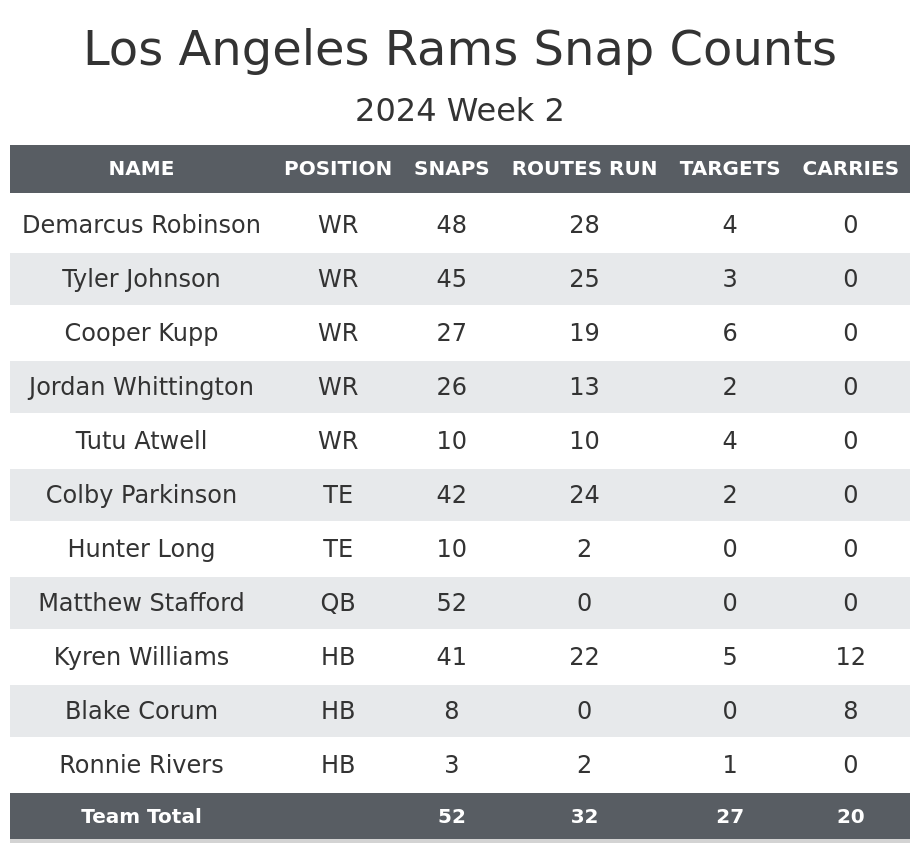 ‘
‘
Monitor Cooper Kupp’s health: Kupp was in a walking boot after suffering an injury against the Cardinals.
The Rams were already down one star wide receiver heading into the game, as Puka Nacua landed on injured reserve. Nacua is expected to miss more than four weeks. Tyler Johnson was Nacua’s direct replacement as expected. Kupp, Demarcus Robinson and Johnson all played at least 90% of the Rams’ offensive snaps in the first half.
Kupp didn’t play in the second half. Jordan Whittington took his place. Whittington played every snap in the second half. Tutu Atwell also played some snaps, cutting into Johnson’s snaps.
If Kupp misses time as well, we can expect Demarcus Robinson to be the lead target in the Rams offense. Both Johnson and Whittington are worth considering, depending on the size of your league.
Marvin Harrison Jr. shines in his second game: Harrison put up good fantasy production despite getting rotated out a little bit
Harrison scored 29 PPR points but played less than 70% of Arizona’s offensive snaps. In the first three quarters, he played in 34 of a possible 36 snaps out of 11 and 12 personnel. The only situation where he isn’t consistently playing over 90% of the available snaps is 13 personnel. This is a run-first personnel grouping, and it’s normal enough for teams to put in a run-blocking wide receiver. Even then, Harrison still played some snaps in these situations.
Harrison only played four-of-16 snaps in the fourth quarter, as he was taken out earlier than most starters. There is no need to worry about that sub-70% snap share in this game, and he should be a must-start going forward.
Miscellaneous Notes
- The blowout greatly impacted playing time for most starters in the fourth quarter.
- Kyren Williams played 41-of-44 snaps in the first three and a half quarters, while Ronnie Rivers played the other three snaps. All of Blake Corum’s offensive snaps came in the last five minutes of the game.
- The Cardinals similarly had a six-play drive to end the game with Clayton Tune at quarterback in addition to backups at running back, wide receiver and tight end.
- Rams backup tight end Davis Allen missed this game due to a back injury.
Pittsburgh Steelers @ Denver Broncos
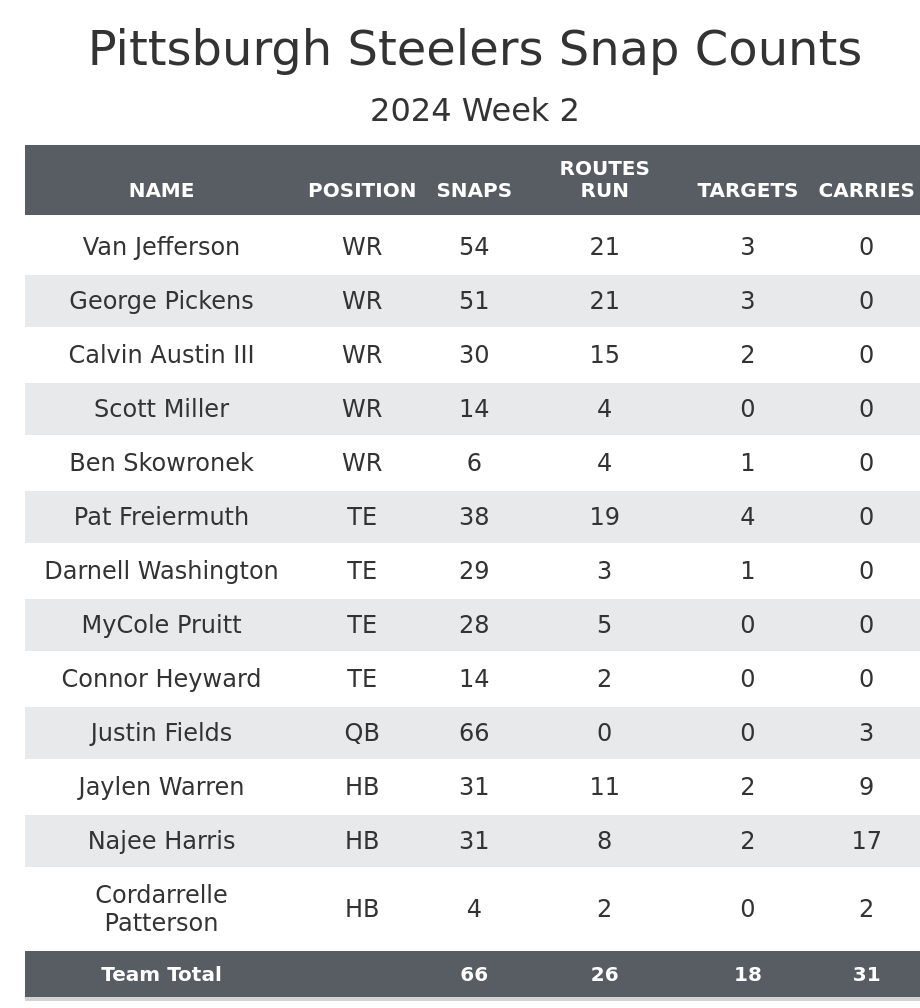
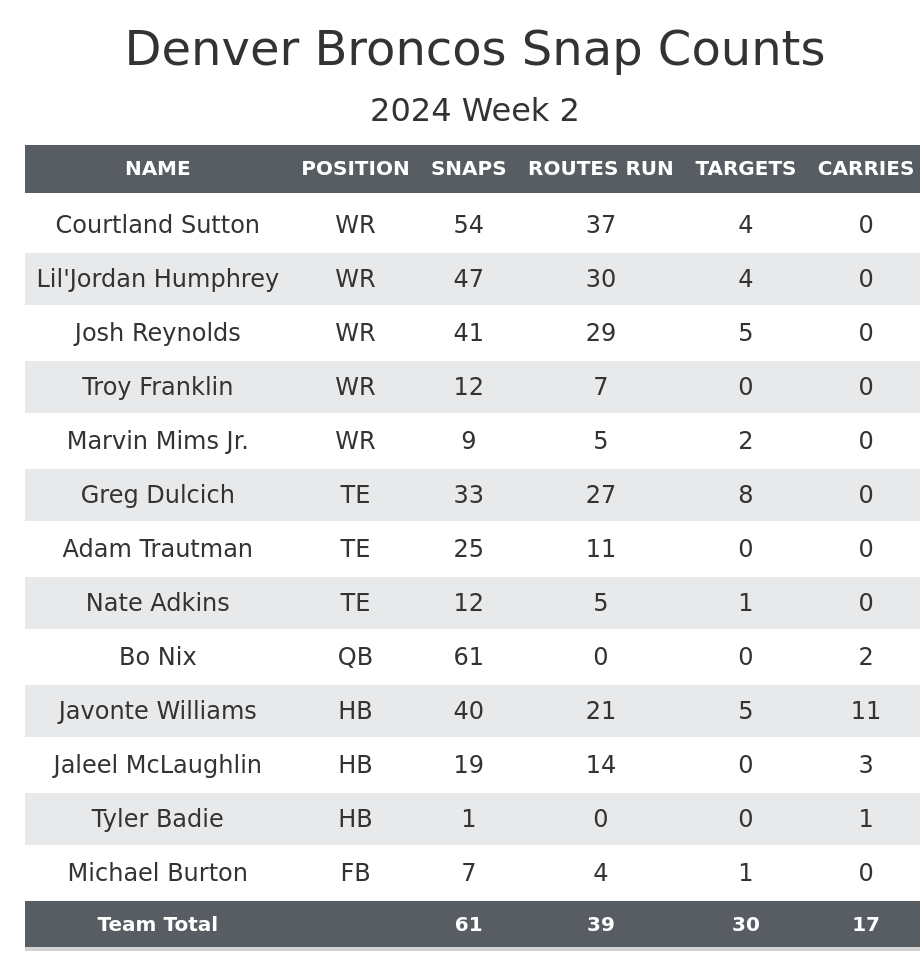
A familiar running back rotation for Pittsburgh: Jaylen Warren played much more in Week 2 compared to Week 1.
Warren was returning from injury in Week 1, leading him to run twice and catch two passes while Cordarrelle Patterson was equally involved. This week, Warren was another week further removed from his injury, leading to more of a 50-50 split in the backfield. Najee Harris played more on early downs while Warren played more in passing situations. This is very similar to how the running backs were used last season.
Harris had more carries while Warren averaged more yards per carry. Their fantasy value was near even. The big difference is Justin Fields was also part of the run game. He ran eight times for 27 yards. These two were borderline fantasy starters before, but with Fields on the team, it will be harder to trust either unless the team starts scoring a lot more points.
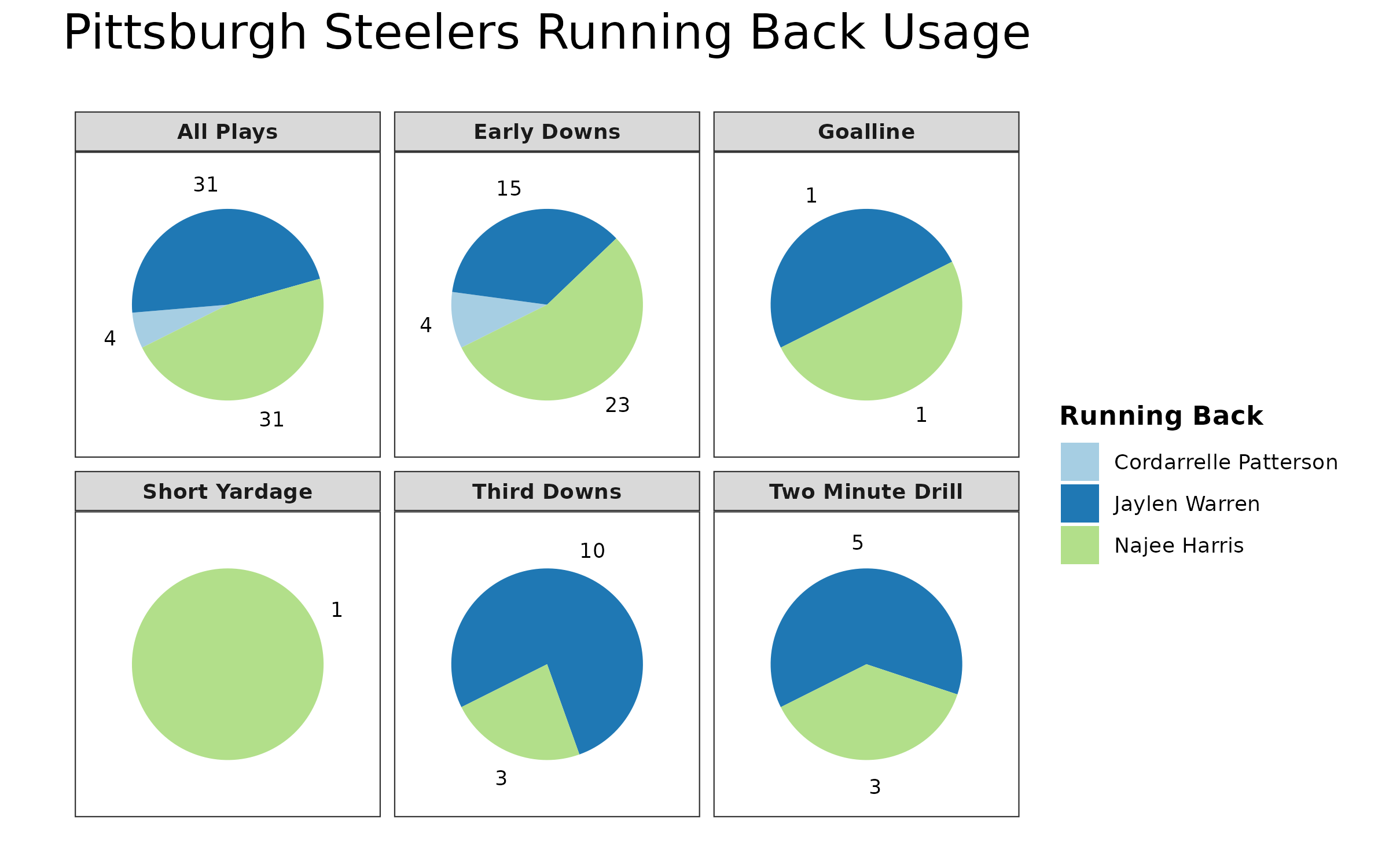
Pat Freiermuth leads the Steelers in receiving yards: Freiermuth caught four passes for 39 yards but played his lowest percentage of snaps in nearly a year.
The Steelers had four tight ends involved on offense. Freiermuth played 27-of-36 snaps in 11 personnel, including 19 of the 22 pass plays. This puts him in the best situation among the tight ends.
The problem is he did not take a single snap out of 12 personnel. In Week 1 and the preseason, he was the third option in 12 personnel. This week, Connor Heyward played ahead of Freiermuth in 12 personnel. The Steelers only ran nine snaps out of 13 personnel and two snaps out of 14 personnel, which was less than last week. This meant Freiermuth wasn’t on the field as often.
Whenever the Steelers are within five yards of scoring, they’ve either used 12 or 14 personnel. Last season, Arthur Smith’s Falcons only ran two out of 36 snaps within five yards out of 11 personnel. This means more often than not, when the Steelers are close to scoring, Freiermuth won’t be on the field. That’s why Darnell Washington scored a touchdown instead of Freiermuth.
Freiermuth can still be rostered in some leagues, but his ceiling is lower than several other tight ends given his lack of 12 personnel usage.
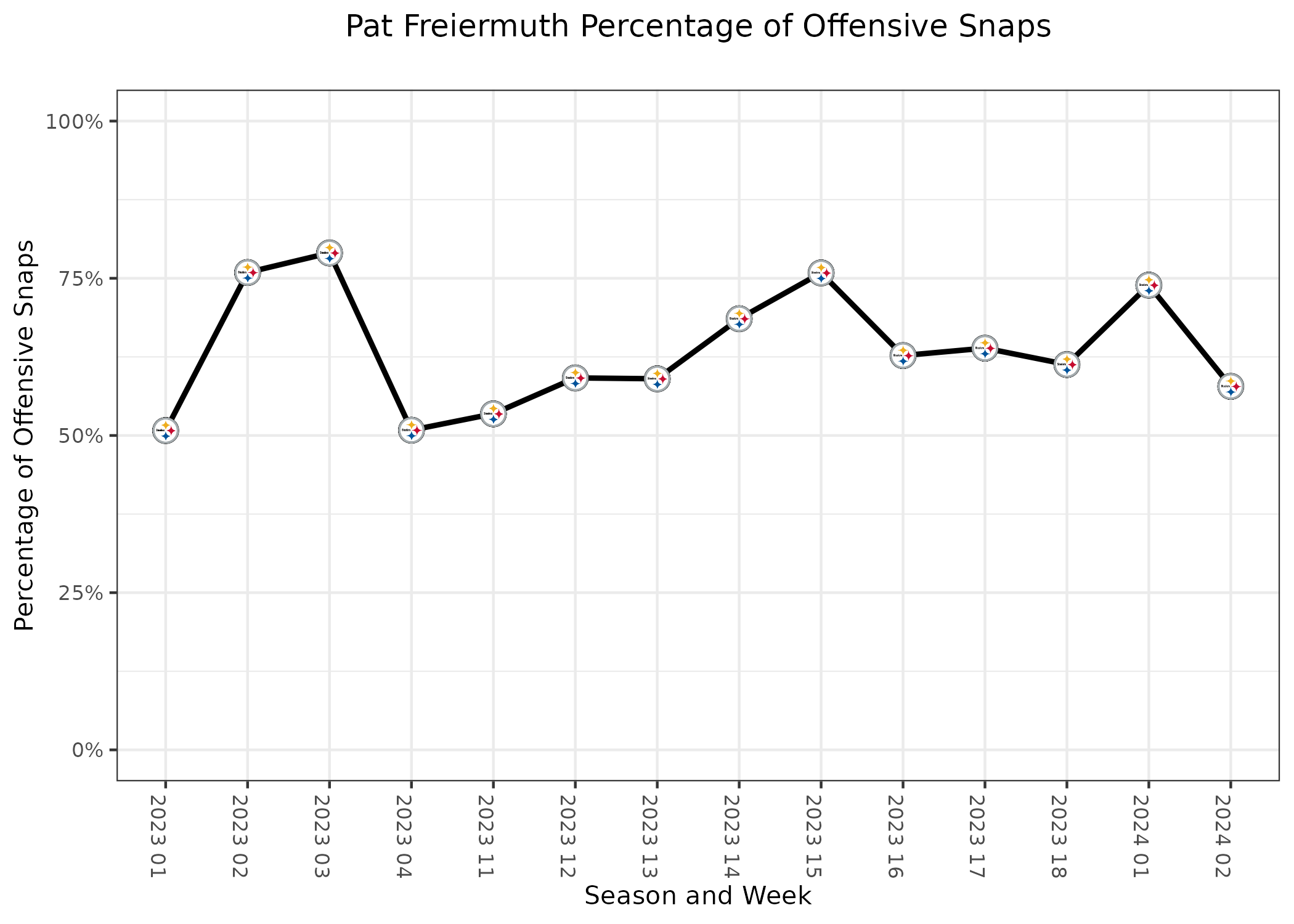
Javonte Williams dominates the Broncos backfield: Williams leads the Broncos backfield in all situations
He ran 11 times compared to McLaughlin’s three and caught five passes for 48 yards while McLaughlin wasn’t targeted. The Broncos offense didn’t have a great game, and Williams averaged just 1.5 yards per carry, but at this point, it’s clear Williams is the lead back.
McLaughlin is still worth rostering, as there is a chance he sees more targets going forward. Third-string back Audric Estime landed on injured reserve, which should help ensure Williams has a floor of around 15 touches per game.
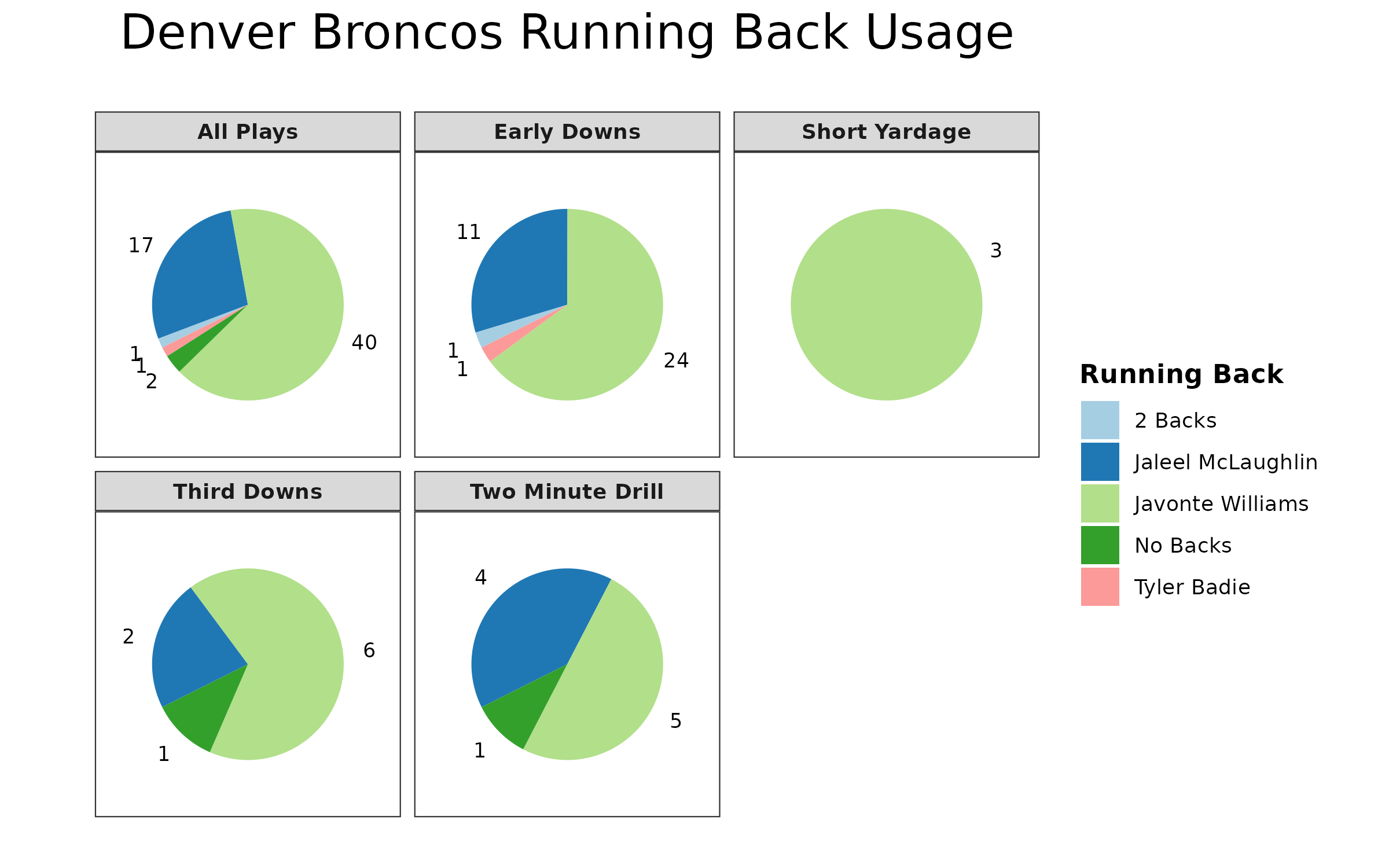
Veterans replace Devaughn Vele: The Broncos rookie wide receiver caught eight passes in Week 1 but was inactive due to a rib injury.
Vele was the third wide receiver last week. His snap share and role completely replaced by Lil’Jordan Humphrey. Marvin Mims Jr. was fifth on the depth chart last week and presumably would be fourth this week, but his playing time didn’t increase at all. Instead, Troy Franklin, who was a healthy inactive last week, leapfrogged him for fourth on the depth chart. Franklin didn’t see a target.
Josh Reynolds is the top waiver option out of everyone after gaining 93 yards. Even when Vele is back, Reynolds should remain second on the depth chart.
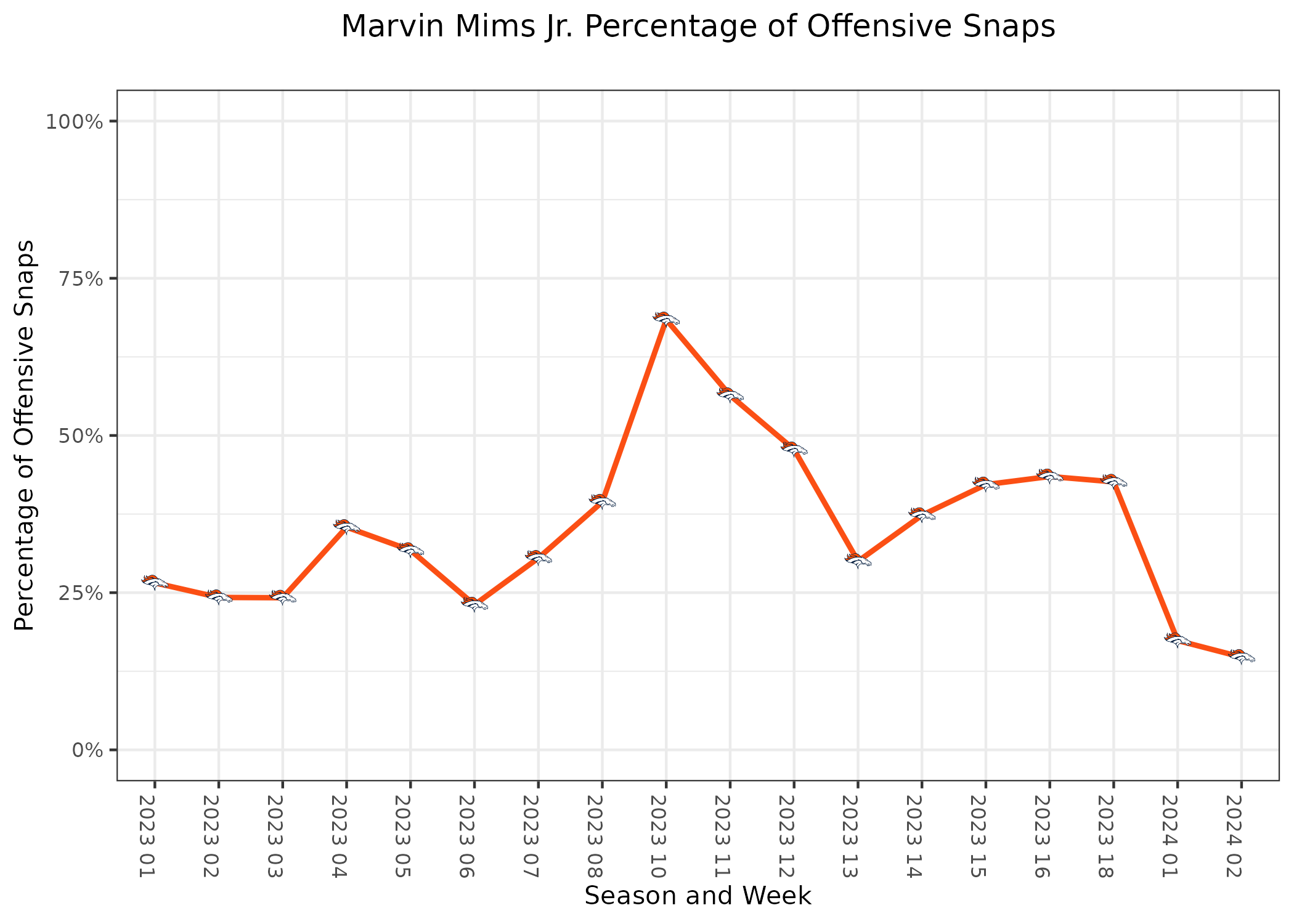
Miscellaneous Notes
- Steelers rookie wide receiver Roman Wilson has yet to play for the Steelers due to an ankle injury. He was a full participant in practice on Thursday but was back to limited on Friday and was ultimately inactive.
- George Pickens officially caught two passes for 29 yards, but he had a 51-yard catch called back due to offensive holding on a lineman and a six-yard touchdown nullified by Van Jefferson‘s offensive pass interference. The Steelers also gained 37 yards on defensive pass interference on one of his targets. His stat line could have been much different if a few things out of his control changed.
- Lucas Krull was a healthy inactive this week. This seemed like a good sign for Greg Dulcich, who did have eight targets, but Dulcich actually played fewer snaps this week compared to last week.
Cincinnati Bengals @ Kansas City Chiefs

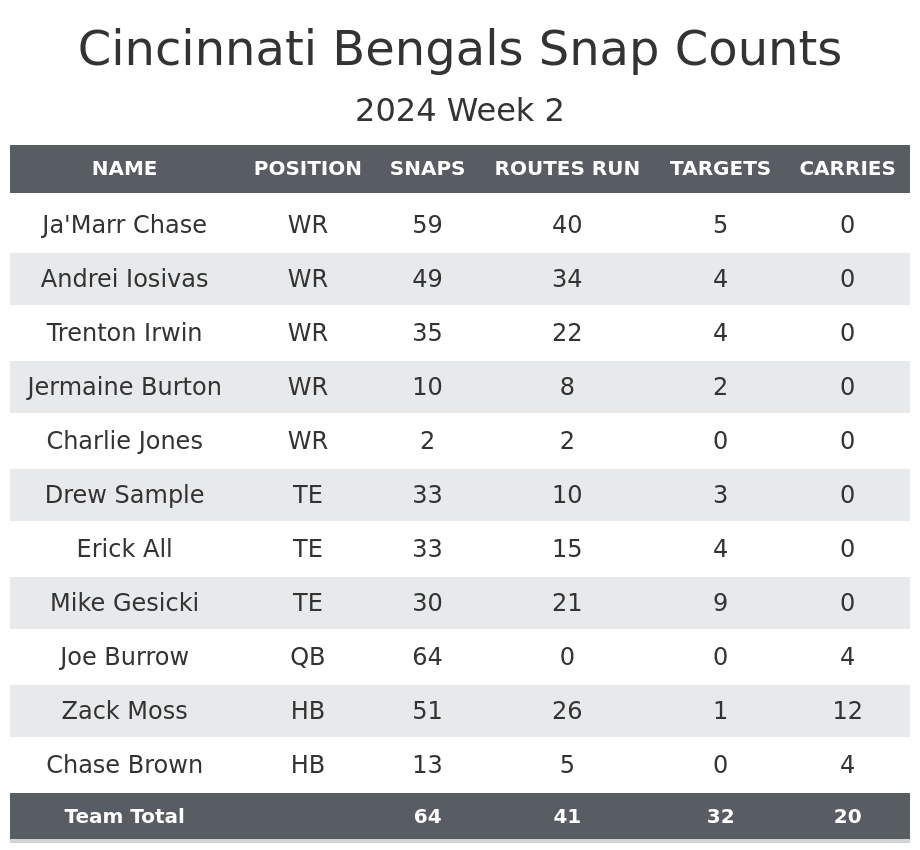
Monitor Isiah Pacheco’s health: Pacheco left the stadium today on crutches and in a walking boot
The Chiefs running back rotation was fairly similar to last week. Pacheco played the vast majority of early-down snaps while Samaje Perine played most of the third-down snaps. One big difference was Carson Steele was more involved in short-yardage and goal-line situations. Pacheco took both of those snaps last week, but this week, the two split that work.
Pacheco took his last snap at the two-minute mark, while Samaje Perine played the game’s final five snaps. If Pacheco misses time, Steele should be the lead running back on the team, considering Perine only played four snaps over the first 58 minutes of the game. Perine would likely take some of the early-down work while maintaining the passing-down role, but Steele should be the waiver-wire target between the two. It’s also entirely possible the Chiefs will look for another free agent to split time with Steele.
It’s worth noting Clyde Edwards-Helaire is eligible to return to the team after Week 4, so Steele might not be the long-term solution at the position, even if Pacheco’s injury is very serious and the team doesn’t add a free agent.
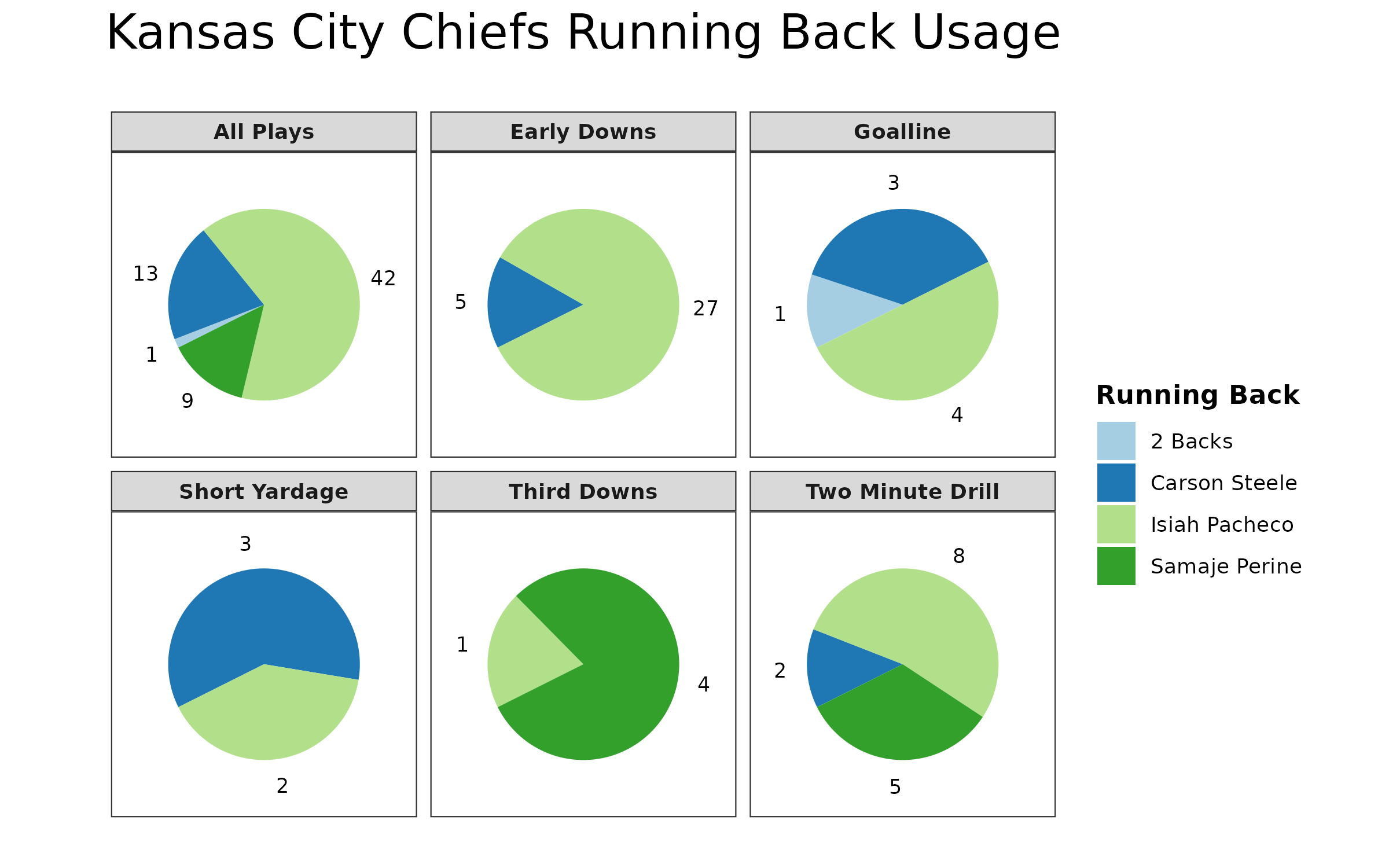
Zack Moss dominates offensive snaps for Bengals: Chase Brown can be dropped in some fantasy leagues based on his low usage.
The Bengals backfield split was somewhat similar to last season. The lead running back played in short-yardage and goal-line situations in addition to roughly 75% of the early-down snaps. Brown played in the other 25% of snaps and not much else. The only difference is Joe Mixon was the lead back last year and didn’t play much on third downs, while the Bengals seem to trust Moss more on third downs.
That didn’t lead to much fantasy production this week. Moss ran 12 times for 34 yards while Brown ran four times for 31 yards. The Bengals have struggled to start most seasons, so chances are the offense will turn things around. If that happens, that will be huge for Moss’ fantasy value, making him a buy-low option.
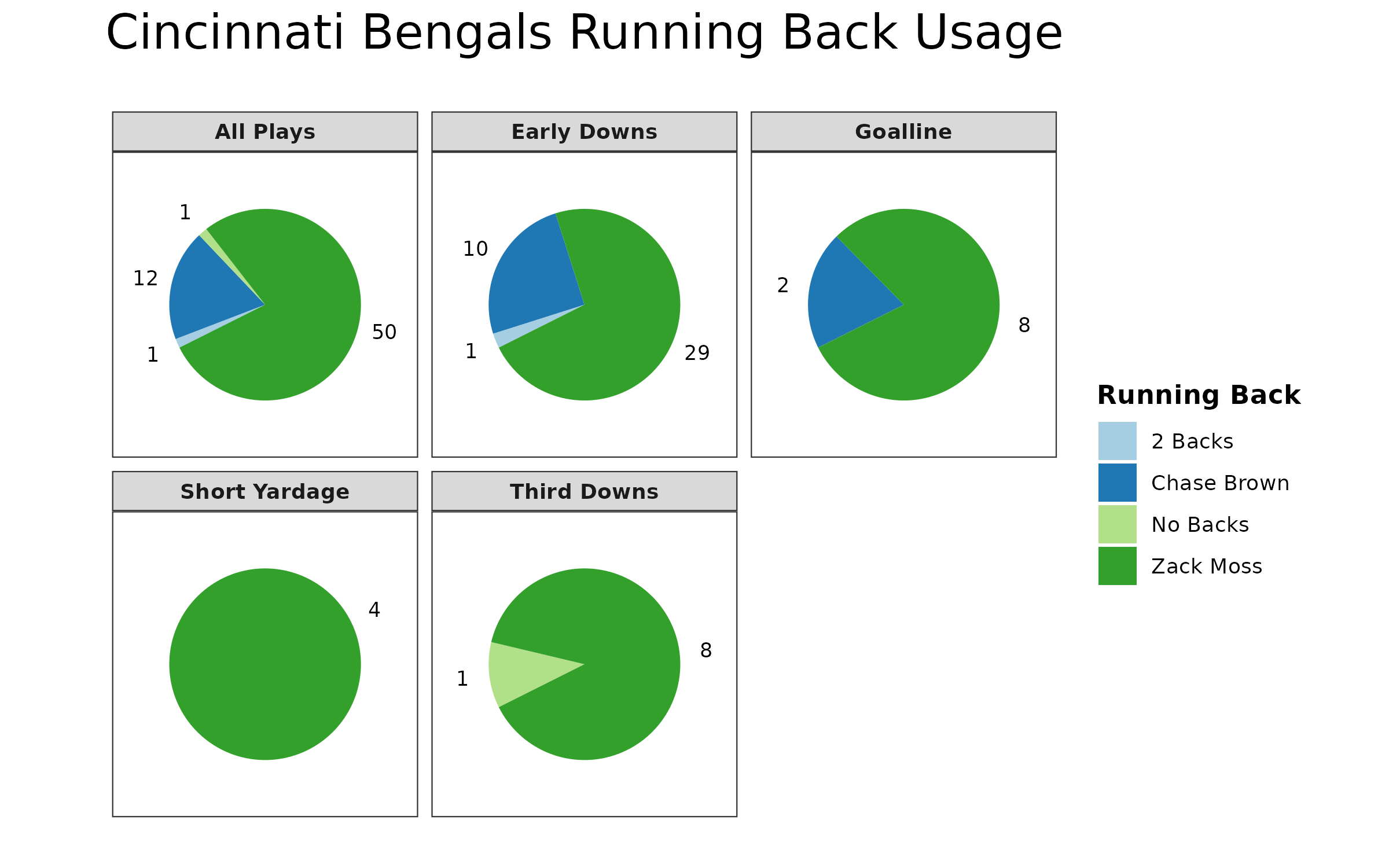
Don’t get tempted by Mike Gesicki: The tight end led the Bengals in receiving but is in too much of a rotation to be trusted going forward.
The Bengals have had a rotation at tight end for several years under Zac Taylor, and this year is no different. In Week 1, Gesicki caught three passes for 18 yards while playing 39% of Cincinnati’s 11 personnel snaps and 21% of 12 personnel.
Bengals backup tight end Tanner Hudson missed this game due to a knee injury, so it was expected that Gesicki would play more offensive snaps. His time only increased slightly to 54% of 11 personnel snaps and 29% of 12 personnel snaps. After this big game, his playing time could remain around this rate, but Drew Sample and Erick All aren’t going anywhere in 12 personnel.
It’s possible Gesicki has a game like this again, but once Tee Higgins is back, Gesicki won’t be as big of a priority in the passing game, and we should see many more games like Week 1 than Week 2.
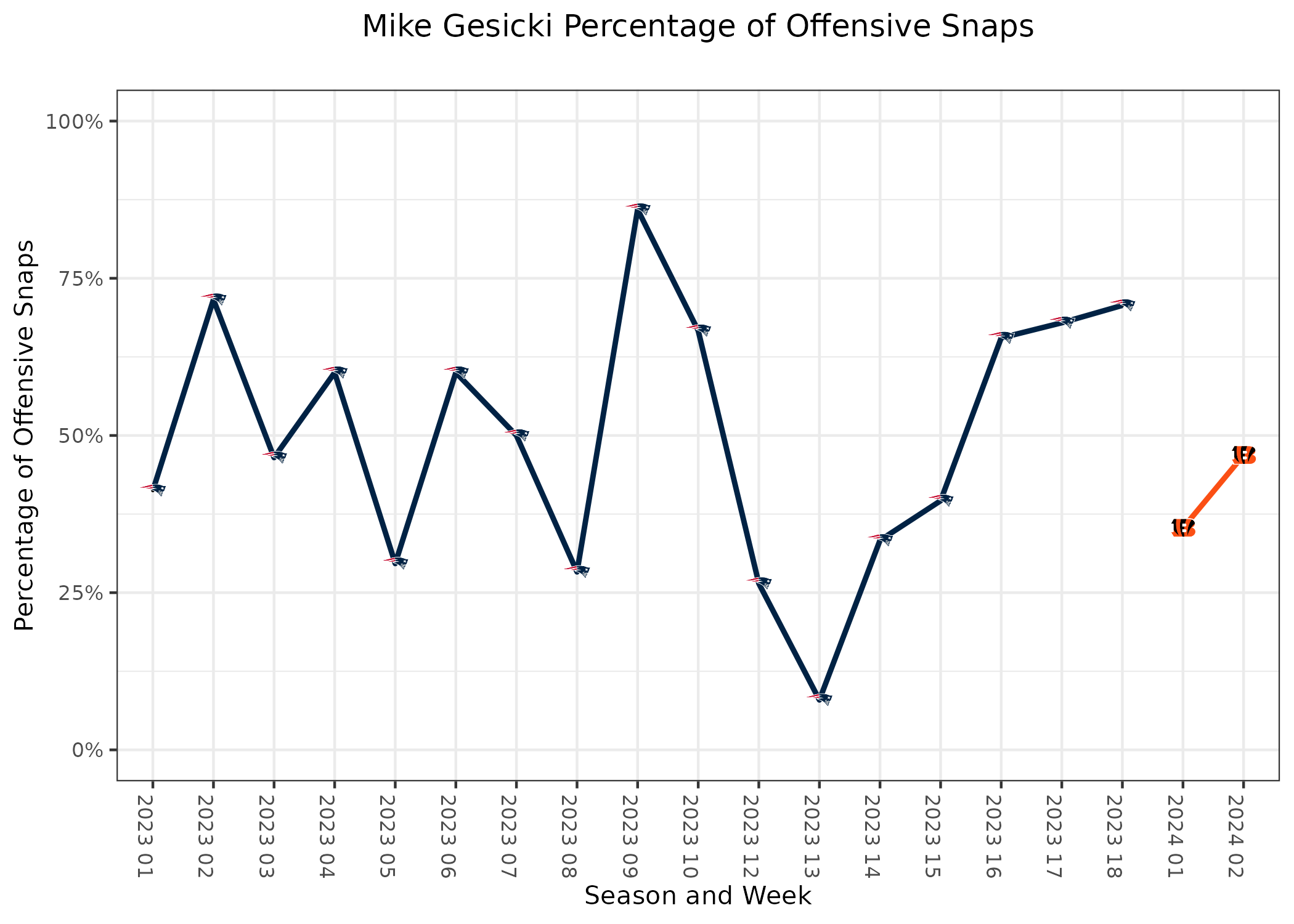
Miscellaneous Notes
- Bengals starting wide receiver Tee Higgins missed his second straight game due to a hamstring injury, leading Andrei Iosivas and Trenton Irwin to join Ja’Marr Chase in three-receiver sets.
- Chiefs wide receiver Hollywood Brown was placed on injured reserve. He will have surgery, and it’s currently unclear when he will be able to return.
- Travis Kelce played in over 90% of Kansas City’s offensive snaps for just the third time in the last four regular seasons. He generally plays more in the most important regular-season games.
Chicago Bears @ Houston Texans
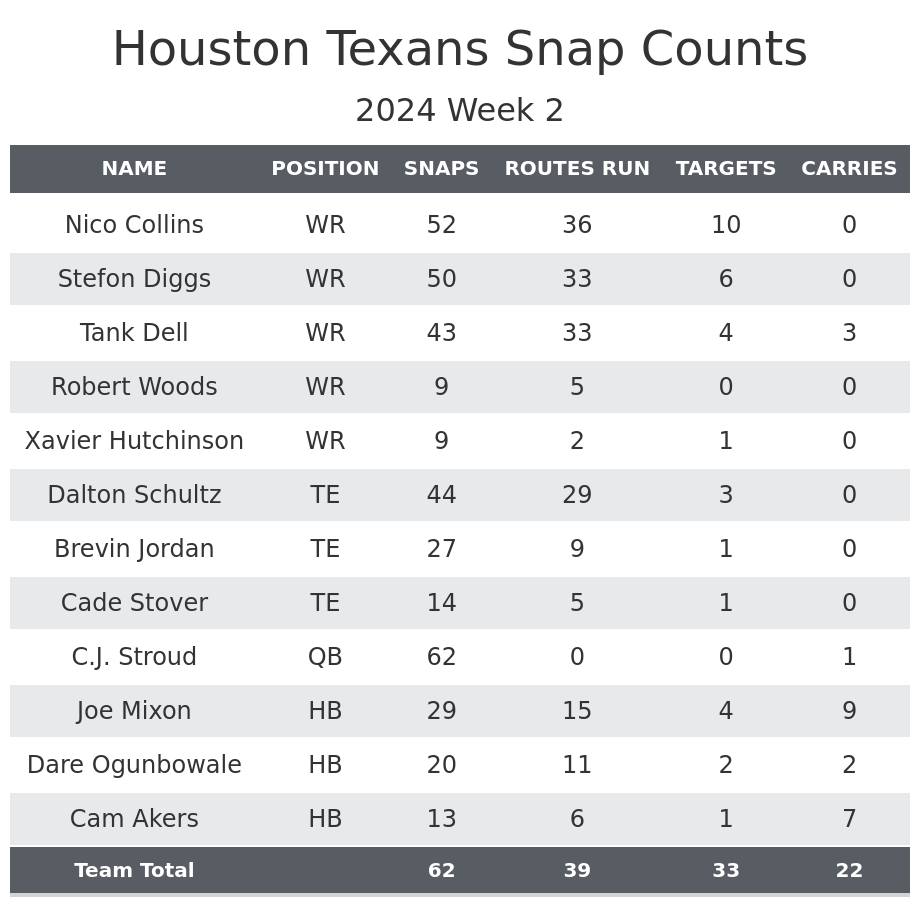
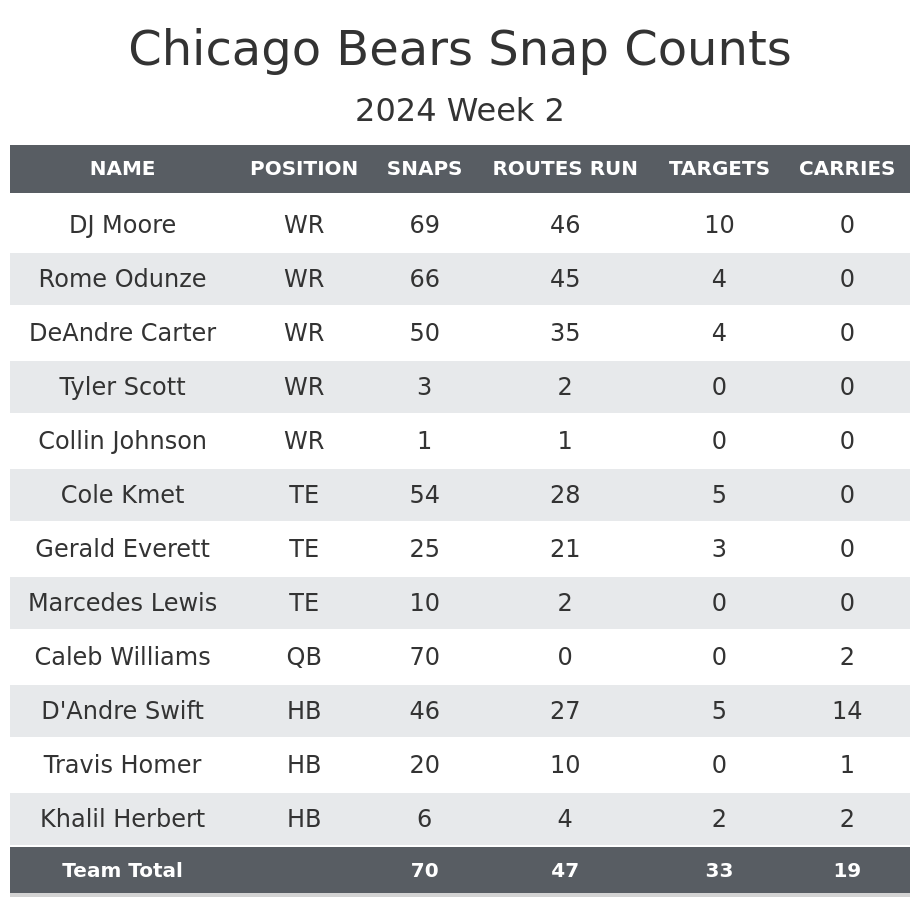
D’Andre Swift is in danger of losing playing time: Swift has been completely ineffective as a rusher this season.
Swift ran 10 times for 30 yards in Week 1 and followed that up with 14 carries for 18 yards in Week 2. He’s served as the clear early-down back, but Travis Homer went from taking some of the third-down snaps in Week 1 to most of the third-down snaps in Week 2. In both games, he’s had to split goal-line and short-yardage snaps with Khalil Herbert.
Swift’s main fantasy value now comes from taking the vast majority of early-down snaps, but considering his rushing production, it wouldn’t be surprising if they eventually give someone else more opportunities.
Keenan Allen was inactive for Chicago: Rome Odunze and DeAndre Carter combined to replace Allen’s snaps.
Allen missed practice all week due to a heel injury, and just 10 minutes before kickoff, Jay Glazer reported he was unlikely to play. Odunze, who saw action in 11 personnel and some two-receiver sets in Week 1, consistently played in two-receiver sets this game despite missing most of the week with a knee injury. While his production was limited, it’s reasonable to attribute that to his injury, making him worth holding onto in fantasy leagues.
In three-receiver sets, Carter consistently lined up in the slot and was the second-most productive receiver for Chicago, hauling in three catches for 32 yards.
Cole Kmet plays more snaps: Gerald Everett outsnapped Kmet in Week 1, and the opposite was true in Week 2.
In Week 1, the Bears’ tight end rotation resembled Shane Waldron’s time with the Seattle Seahawks, where multiple tight ends were utilized as receiving options, with Everett as the primary target. However, this week’s rotation was more similar to Waldron’s approach with the Los Angeles Rams, which featured a more defined role for the tight ends.
Kmet played the Tyler Higbee role, taking all of the two-tight-end snaps, most of the 21-personnel snaps and many of the 11-personnel snaps where it could be either a run or a pass. Then, in clear passing situations, Everett took the field.
This week, Kmet saw significantly more playing time than Everett, though they were fairly close in routes run. While Kmet’s role offers some potential for fantasy value, both he and the Bears offense will need to improve significantly. With several other offenses performing better and tight ends seeing higher snap counts and better production, Kmet remains a low-priority option and can stay on the waiver wire for now.
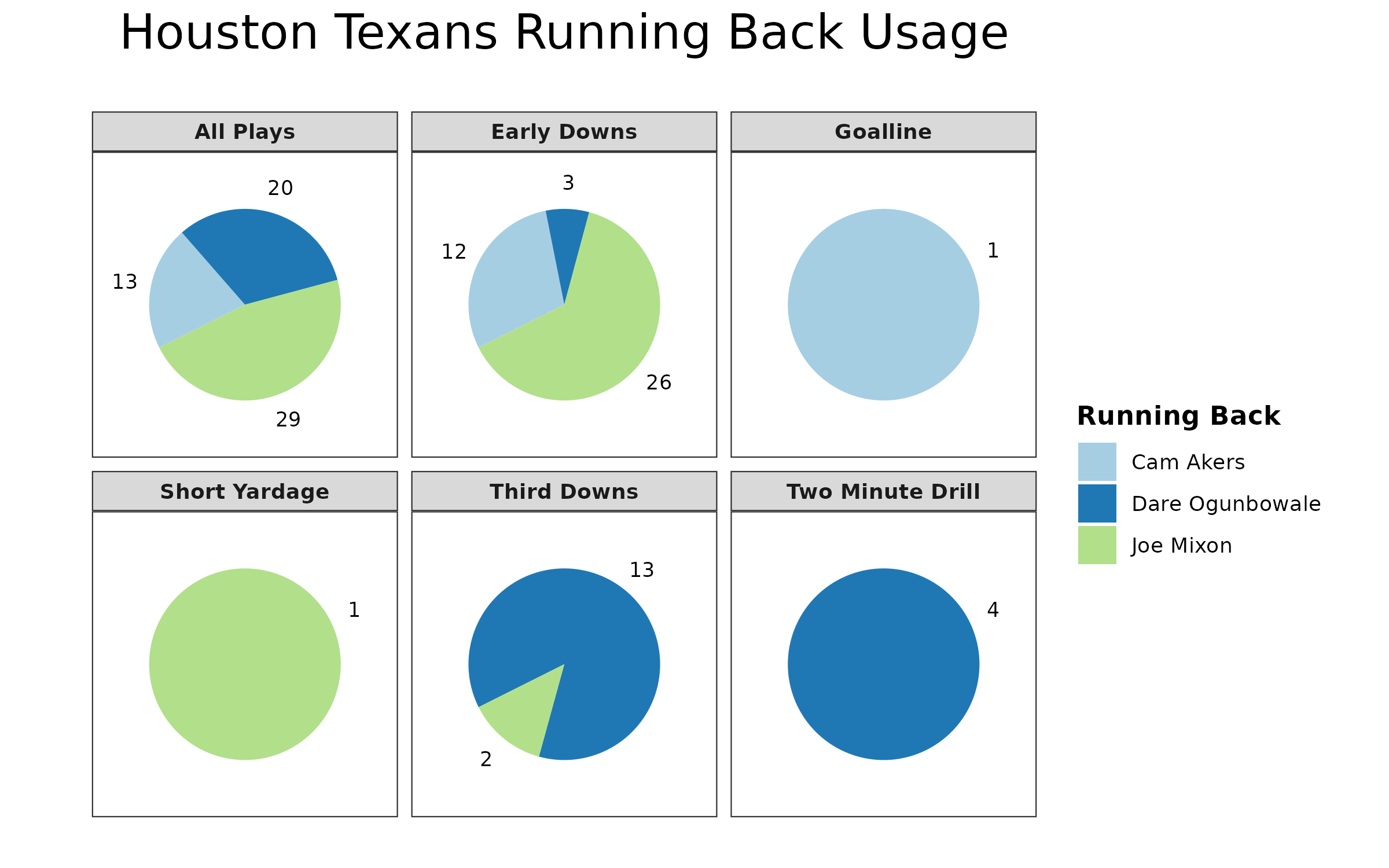
Monitor the health of the Texans running backs: Mixon suffered an ankle injury in the second half and returned only briefly.
The Texans started the game without Dameon Pierce (hamstring), who practiced on Wednesday, was limited on Thursday and didn’t practice Friday. He was declared questionable but ultimately was inactive. This meant Cam Akers was activated (unlike last week) and served as the primary backup.
Mixon played on early downs in the first half, and Dare Ogunbowale played in passing situations, as expected. Akers played only two snaps. Mixon’s injury occurred three minutes into the third quarter, and Akers took his role.
Mixon returned with a minute left in the quarter and played another seven snaps, but then Mixon didn’t play in the last 12 minutes of the game. Akers fumbled in the middle of the fourth quarter, so Ogunobale closed out the game.
If Mixon misses time, Dameon Pierce would be the player to target (depending on his health). If neither player can play, Akers should be the waiver wire target. Ideally, we will get more information on the health of both players before the end of Tuesday.

Miscellaneous Notes
- The Bears made Velus Jones Jr. inactive this week instead of Roschon Johnson, but Johnson didn’t play on offense.
- Tank Dell played only four of a possible 21 snaps in 12 personnel, leading Dell to miss out on six pass routes.
Table Notes
- Snaps include plays called back due to penalties, including offensive holding or defensive pass interference. The other three stats have these plays removed.
- Targets may differ from official NFL sources. The most likely discrepancy would be from a clear thrown-away pass, where the NFL may give the target to the nearest receiver, while this data will not.
- Carries are only on designed plays. Quarterback scrambles won’t count for the total number of carries in the game.
Related
Daniel Jones released: New York Giants part ways with struggling…
The New York Giants have "mutually agreed" to terminate the contract of quarterback Daniel Jones, less than two years after he signed a $160m extension with the
Browns top Steelers in snow; previewing crucial week in NFL,…
This is an article version of the CBS Sports HQ AM Newsletter, the ultimate guide to ev
NFL gameday guide: Taylor Swift’s rival, Aaron Rodgers’ despair, Kyle…
Mob movies, Motown magic, more Aaron Rodgers-centred drama, the 'Harbowl' and rushing fireworks between Kyle Shanahan and Matt LaF
Saudi wealth fund’s expansion into North American soccer raises questions
A leading human rights organization has described a sponsorship deal between Concacaf and the Saudi Arabia Public Investment Fund (PIF) as sportswashing, critic
